
まとめて解説
「まとめて検索/RUNNERS Discovery Service」「電子書籍検索」「電子出版物検索」「論文・記事検索」の使い方
How to Use RUNNERS Discovery Service, e-publication Search, e-book Search, Article Search
「まとめて検索」(RUNNERS Discovery Service)は、EBSCO社のディスカバリーサービスによって提供される検索システムです。本学図書館の蔵書、本学がアクセス権を購入した電子書籍や電子ジャーナルに掲載されている論文などの電子リソース、入力されたキーワードの意味、関連する新聞記事などをまとめて検索することができます。
こちらをクリックすると、英語によるEBSCO Discovery Serviceの総合的な解説ページが開きます。
こちらをクリックすると、日本語による解説動画(約30分)を視聴できます。
Our "RUNNERS Discovery Service" is an academic information resource search system provided by EBSCO. You can search the collections of our library, e-resources such as e-books and articles published in e-journals for which we have purchased access, the meaning of entered keywords, related newspaper articles, etc.
Click here to open a comprehensive explanation page for EBSCO Discovery Service in English.
Click here to watch an explanation video (about 30 minutes) in Japanese.
以下では、これらの解説の中で特に重要な点や、本学のためにアレンジされている点について説明します。調べたい項目の見出しをクリックすると、説明が表示されます。
Some important points in these explanations and the points arranged for our university are explained below. Click an heading for the item you want to look up to see a description.
「まとめて検索」(RUNNERS Discovery Service)で見つかるもの / What the RUNNERS Discovery Service Search for
「まとめて検索」は、図書館の蔵書検索システムや、GoogleやYahooなどの検索エンジンではみつからないさまざまな学術情報資源をまとめて検索する仕組みです。
"RUNNERS Discovery Service" is a mechanism to search various academic information resources that cannot be found in the library's OPAC system or search engines such as Google and Yahoo.
蔵書検索で見つからないもの
Information resources not found in RUNNERS OPAC
図書館の資料を探すとき、多くの方は蔵書検索システムで資料を探されます。図書館では、図書などの資料を受け入れた際、目録情報(その資料のタイトル、著者、主題、分類、所在などの情報。目次や抄録を含む場合もある。)を自館の蔵書管理システムに登録します。蔵書検索システムはこの目録情報を使って「自館の資料を検索するシステム」であり、次のような資料は検索できません。
When looking for resources in a library, many users look for resources in the RUNNERS OPAC. When a library accepts a resource such as a book, we input catalog information (information such as the title, author, subject, classification, location, etc. of the information resource, which may include a table of contents and abstracts) to our collection database. The RUNNERS OPAC is a system that uses this catalog information to search for resources in our library. You cannot search for resources such as the following on the OPAC system:
図書館がアクセス権を購入した電子書籍 / e-books Purchased and Owned by Library ( ▼開く Click to Read )
図書館が電子書籍を購入する場合、電子書籍のデータを受け入れて図書館の中にあるコンピューターに保存するのではなく、書店や出版社のコンピューターにある電子書籍の情報にアクセスする権利を購入して、利用者が学内ネットワークに接続したパソコンやスマホなどからこのデータにアクセスできるようにしています。印刷された書籍のような受入処理を行わないため、目録情報が図書館の蔵書管理システムに登録されません。そのため、電子書籍を利用するときは、蔵書検索システムではなく書店や出版社の提供する電子書籍用のプラットフォームを使って検索や閲覧をします。「まとめて検索」を使えば、出版社や書店が異なっていても横断検索ができます。
When a library purchases e-books, it purchases the right to access the e-books data on the computer of the bookstore or publisher, rather than accepting the data of the e-books and storing them on our library's computer. This allows users to access those data from computers and smartphones connected to the campus network. Catalog information is not registered in our library's collection databese because they does not accept as printed books. When using an e-book, search and browse on the e-book platform provided by bookstores and publishers instead of our library's collection databese system. With "Discovery", you can perform a cross-search at once even if the publisher or bookstore is different.
サブスクリプションの電子書籍や電子ジャーナル / e-books in the Subscription Packages and e-journal( ▼開く Click to Read )
図書館が電子書籍へのアクセス権を得るためにサブスクリプション契約をする場合があります。新しい電子書籍が出版された場合は、契約の範囲でそのタイトルのアクセス権も自動的に得ることができます。「まとめて検索」のシステムでは、このような新しい電子書籍の出版情報を自動的に収集して、閲覧可能な電子書籍としてリストアップします。
電子ジャーナルの購読契約も、出版社毎にまとめて契約する場合が増えています。このような契約では、契約先の出版社の電子ジャーナルの全部または分野ごとに決められた範囲でアクセスできます。その出版社で新しい電子ジャーナルの発行が始まったときには、そのタイトルも自動的にアクセス可能となるという契約もあります。「まとめて検索」のシステムでは、このような新しい電子ジャーナルの発行情報も自動的に収集しています。
Our library conclude some subscription contract to get the access right to e-books. Such e-books cannot be called a "collection" because the access right will be lost when the contract is terminated, but if a new e-book is published within the scope of the contract, the access right of the e-book will also be automatically gained. The "Discovery" system automatically collects the publication information of such new e-books and It will be listed as available e-books.
The number of e-journal package subscription contracts is increasing. If we make the package contract, we can access all of the e-journals of the publishers we have contracted with, or we can access within the range determined for each field. When a new e-journal is published by the publisher, the new e-journal will also be automatically accessible.The "Discovery" system automatically collects information about the publication of such new e-journals.
オープンアクセスの電子リソース / Open Access e-Resources( ▼開く Click to Read )
オープンアクセスの電子リソースも広い意味では図書館の情報リソースですが、図書館と出版社の契約や受入といったプロセスを経ずに利用者に提供されますので、蔵書管理システムに目録情報を登録することができません。
このほかにも、インターネット上には、契約や金銭的対価の支払いなしに、自由に閲覧が可能な電子出版物があります。例えば、著作権が切れてパブリックドメインとなった小説等を無料で公開している日本の「青空文庫」や海外の「Project Gutenberg」、学協会や大学などが無料で公開しているさまざまな電子出版物などです。
「まとめて検索」のシステムは、こうしたオープンアクセスの電子リソースに関する情報も、自動的に収集しています。
Open access e-resources are library information resources in a broad sense, but since they are provided to users without going through the process of contract between the library and the publisher or acceptance, catalog information cannot be registered in the collection management system.
In addition, there are e-publications on the Internet that can be freely browsed without contracts or payment of financial consideration. For example, Japanese "Aozora Bunko" and overseas "Project Gutenberg", which publishes novels that have expired of copyright and has became the public domain for free, and various e-publications published free of charge by academic societies and universities.
The "Discovery" system also automatically collects information about these open access e-resources.
ジャーナルに掲載された論文・記事 / Articles Published in the Journal( ▼開く Click to Read )
印刷されたジャーナルは、出版される都度、新たな巻号が送られてきます。送られてきたジャーナルを受け入れる際、掲載されている個々の論文や記事について、タイトル、著者などの目録情報を自館の蔵書管理システムに登録すれば蔵書検索システムでこれらを検索できますが、登録には莫大な労力と時間がかかるため、それぞれの図書館は、自館の蔵書管理システムに論文や記事の目録情報を登録していません。これらの論文や記事を探すには、CiNii ResearchやWeb of Scienceといった外部の目録データベースなどを使う必要があります。
電子ジャーナルの場合は、新しい巻号が発行されたことを検知することもできません。
「まとめて検索」では、さまざまなデータベースと連携して、新しい巻号の発行情報や、その巻号に掲載されている論文・記事の書誌情報(タイトル、著者、主題などの情報。ときには抄録なども含まれる。)を自動的に収集しています。
In tha case of printed journals, new volume and issue will be published repeatedly and printed and sent to the library. When we accept the volume and issue of the journal, if we register the catalog information such as title, author, etc. for each article published in the journal in our collection database, you can search for these articles by the OPAC system. However, our registration requires enormous effort and time. For this reason, each library does not have an article catalog information in its collection database. To find these articles, you must use an external catalog database such as "CiNii Research" or "Web of Science".
In the case of e-journals, it is not possible to detect that a new volume and issue has been published.
"Discovery Service" works with various databases to provide information on the publication of new volumes and issue, and bibliographic information (information such as titles, authors, subjects, etc. Sometimes abstracts is also included) of articles published in those volumes and issue is automatically collected.
事典・辞書や新聞の記事 / Encyclopedia and Dictionary Items, Newspaper Articles( ▼開く Click to Read )
事典・辞書に掲載されているひとつひとつの項目は、それぞれが独立した情報リソースです。また、新聞に掲載される新聞記事のひとつひとつも独立した情報リソースです。これらの情報リソースの目録情報も、蔵書管理システムには登録されていません。
「まとめて検索」のシステムは、一部の事典・辞書データベースや新聞記事データベースと連携して、入力されたキーワードについての事典・辞書の説明や、入力されたキーワードに関係する新聞記事なども検索できます。
The explanation of each item in these encyclopedias and dictionaries is an independent information resource. Newspaper article published there is also an independent information resource. The catalog information for these information resources is also not registered in our collection database.
The "Discovery" system works with some encyclopedia / dictionary databases and some newspaper article databases to explain with encyclopedias / dictionaries about the entered keywords and display newspaper articles related to the entered keywords.
これら、蔵書検索(RUNNERS OPAC)では見つけることのできない電子リソースやひとつの出版物の中にある個別の記事や項目を、蔵書検索システムで検索できる図書館の蔵書とまとめて検索するのが「まとめて検索」です。本学図書館で契約しているすべての電子リソースが検索対象になるわけではありませんが、とりわけ電子書籍や電子ジャーナルについては、ほぼ完全に検索対象となるように検索用のデータベースがメンテナンスされています。購読している電子ジャーナルの新しい巻号が発刊された場合は、そこに掲載されている論文のタイトル、著者、主題、抄録などの書誌情報が収集され、検索用のデータベースに組み込まれることによって、検索対象に追加されます。
"RUNNERS Discovery Service" searches the information resources what cannot be found by our OPAC system such as the e-resources or individual articles and items in one publication, with the library collections that can be searched by our OPAC system together. Not all e-resources contracted with our library will be searched, but especially for e-books and e-journals, a search database has been updated almost completely, as nessesary for searching. When a new volume of a subscribed e-journal is published, bibliographic information such as the title, author, subject, and abstract of the article published in it is collected and incorporated into a search database. By doing so, it will be added to the search target.
 「まとめて検索」(RUNNERS Discovery Service)「蔵書検索」(RUNNERS OPAC)「電子書籍(e-book)検索」「電子出版物(e-publication)検索」「論文・記事(article)検索」で検索できる主な文献の範囲を図示すると、右の図のようになります。
「まとめて検索」(RUNNERS Discovery Service)「蔵書検索」(RUNNERS OPAC)「電子書籍(e-book)検索」「電子出版物(e-publication)検索」「論文・記事(article)検索」で検索できる主な文献の範囲を図示すると、右の図のようになります。
さらに詳しい説明
「まとめて検索」で検索される大部分の文献と、「論文・記事(Article)検索」で検索される文献は、EBSCO社が世界中から収集している文献情報を元にした検索用のファイル(ここでは仮に「インデックス・ファイル」と言います)をもとに検索しています。「インデックス・ファイル」は、本学で全文にアクセスできるかどうかには関係なく、それぞれの文献情報を提供する出版社とディスカバリーサービスのベンダーであるEBSCO社で作成されます。全文情報が収集できる場合もあれば、タイトルや著者などの書誌情報だけの場合もあります。そのため、本学ではその文献の本文全文にアクセスできるのに全文を対象にした検索ができない場合もあります。検索結果を表示するにあたっては、本学と契約のあるリソースに限定して検索が行われますが、その際に本文全文にアクセスできるリソースだけに限定されるわけではありませんので、本文にアクセスできない文献が検索結果に表示されることもあります。
「電子出版物(e-publication)検索」は、EBSCO Publication Finder という製品で実現しています。EBSCO Publication Finder の検索は、本学でメンテナンスしている「ナレッジベース」というデータベースをもとに行われます。ナレッジベースには、世界中のさまざまな電子出版物が登録されており、その中で本学からアクセスできる電子出版物がどれなのかがわかるようにメンテナンスが行われています。「電子出版物(e-publication)検索」で表示される検索結果には、そのナレッジベースの中から本学からアクセス可能な電子出版物だけが表示されます。
「電子書籍(e-book)検索」は、「まとめて検索」「論文・記事(Article)検索」と同様に、EBSCO Discovery Service という製品で実現していますが、電子書籍という資料種別に特化した検索が行われます。本学が電子書籍を購入したときに提供された、タイトルや著者、出版社、場合によってはあらすじや目録などの情報を元にしたパッケージを対象に検索がなされます。そのため「電子書籍(e-book)検索」で表示される検索結果にも、本学からアクセス可能な電子書籍だけが表示されます。
「まとめて検索」は、これらをまとめて検索することができます。
 The figure on the right shows the range of the main documents that can be searched by "RUNNERS Discovery Service", "OPAC", "e-book Search", "e-publication Search", and "Article Search".
The figure on the right shows the range of the main documents that can be searched by "RUNNERS Discovery Service", "OPAC", "e-book Search", "e-publication Search", and "Article Search".
More Information
Most of the documents searched by "Discovery Service" and the documents searched by "Article Search" are files for searching based on the document information file collected by EBSCO from all over the world (here, we call it as "index file" tentatively). The "index file" is created by publicers those provides the respective bibliographic information and EBSCO which is a vendor of discovery service, regardless of whether or not the full text is accessible at our university. In some cases full text information can be collected, in other cases it is only bibliographic information such as title and author. Therefore, we may not be able to search the entire text of the document even though we can access the full text of the document. When displaying the search results, the search is limited to the resources that have a contract with our university, but at that time, the search is not limited to the resources that can access the full text, so there are documents that cannot access the text may also appear in search results.
"e-publication Search" is realized by a product called EBSCO Publication Finder. EBSCO Publication Finder searches are based on a database called the "Knowledge Base" maintained by our library. Various e-publications from all over the world are registered in the knowledge base, and maintenance is performed so that you can see which e-publications can be accessed from our university. The search results displayed by "e-publication Search" will only show e-publications accessible by our university from the knowledge base.
"e-book Search" is realized by a product called EBSCO Discovery Service as same as "Discovery Service" and "Article Search", but it specializes in the resource type of e-books. The search results are based on the information of title, author, publisher and in some cases abstract and table of contents, which are registered to our catalog database when our library purchases the e-book. Therefore, only the e-books accessible from our university will be displayed in the search results displayed by "e-book Search".
"Discovery Service" allows you to search for these all at once.
GoogleやYahooで見つからないもの
Information resources not found in Google or Yahoo
GoogleやYahooなどの検索エンジンは、クローラーというプログラムによってウェブ上から多数の情報を効率的に収集しています。これらの検索エンジンによって探し出せるのは「表層ウェブ」と呼ばれる情報です。例えば「立命館大学図書館」と入力して検索すると、本学の図書館ホームページを見つけることはできます。これが「表層ウェブ」です。しかし、検索エンジンではさらにその先の情報を見つけることはできません。本学の図書館ホームページで「末川博」と入力して検索すると、「末川博」に関係する本学図書館の蔵書を検索することができますが、GoogleやYahooなどの検索エンジンで「末川博」と入力して検索しても、本学図書館の蔵書に辿り着くことはできないでしょう。このような「表層ウェブ」のさらに奥にあるウェブ上の情報を「深層ウェブ」と呼んでいます。「まとめて検索」は、本学図書館の蔵書や、本学図書館が契約しているデータベースや電子ジャーナル、本学図書館が購入した電子書籍、各大学や研究機関が無料で公開している機関リポジトリに掲載された論文や、世界中の様々なオープン・アクセスの学術資源など、GoogleやYahooなどの検索エンジンでは見つかりにくい「深層ウェブ」にある情報を検索するためのシステムです。
Search engines such as Google and Yahoo, which are used by many people, use a program called a crawler to efficiently collect a large amount of information from the Internet. What these search engines can find is information called the "surface web." For example, you can find our library homepage by typing "Ritsumeikan University Library" and searching. This is the "surface web". However, search engines cannot find further information. If you enter "SUEKAWA Hiroshi" on our library homepage and search, you can search the collections of our library related to "SUEKAWA Hiroshi", but when you search for "SUEKAWA Hiroshi" on search engines such as Google and Yahoo, you can not reach the collection of theour University Library. The information on the web that is deeper than the "surface web" is called the "deep web". The RUNNERS Discovery Service is a system for searching information on the "deep web" that is difficult to find with search engines such as Google and Yahoo includes books collections in the University Library, databases and e-journals contracted by our University Library, e-books purchased by our University Library, and articles published in institutional repositories published free of charge by each university and research institution and various open access academic resources around the world.
「まとめて検索」に適した探し方
How to search suitable for "Discovery Service"
「まとめて検索」は、主題やテーマをもとに、さまざまな情報リソースをまとめて検索するための機能です。本学図書館の蔵書を検索する場合は、蔵書検索(RUNNERS OPAC)で検索する方が、より高度な検索機能を使うことができます。探そうとしている情報がどの電子リソースにあるのかがわかっている場合は、それぞれの電子リソースのプラットフォームで検索する方が効率的かもしれません。さまざまな検索機能をうまく使い分け、より効率的、効果的に、必要な情報を検索してください。
"Discovery Service" is a service to search various information resources at once based on the subject or theme. If you want to search the collection of books in our library, you can use the more advanced search function by searching with the OPAC system. If you know which e-resource contains the information you are looking for, it may be more efficient to search on the search screen for each e-resource. Use various search functions properly to search for the information you need more efficiently.
検索画面について / About the Search Screen
「まとめて検索」「電子書籍検索」「電子出版物検索」「論文・記事検索」の画面上部の赤帯には、次のリンクが並べられています。
| 表示 | リンク先 | 機能 |
|---|---|---|
| まとめて検索 / RUNNERS Discovery Service | 「まとめて検索」画面 | 入力したキーワードから、本学図書館の蔵書、購入した電子書籍、利用できる電子出版物、ジャーナルに掲載された論文や記事などの文献をまとめて検索 |
| 蔵書検索 / RUNNERS OPAC | 「蔵書検索」画面 | 入力したキーワードから、本学図書館が所蔵している印刷物の資料を検索 |
| e-book | 「電子書籍検索」画面 | 入力したキーワードから、本学が購入した電子書籍を検索 |
| e-publication | 「電子出版物検索」画面 | 入力したキーワードまたは一覧から、本学で利用できる電子ジャーナルや電子書籍のタイトルを検索 |
| Article | 「論文・記事検索」画面 | 入力したキーワードから、電子ジャーナルや冊子のジャーナルに掲載されている論文や記事を検索 |
| e-Resource List | 「電子リソース一覧」画面 | 本学で利用できるさまざまな電子リソースをカテゴリー別に一覧にしたリスト |
| FullTextFinder | 「FullTextFinder」画面 | 特定された文献の入手方法を調べるツール |
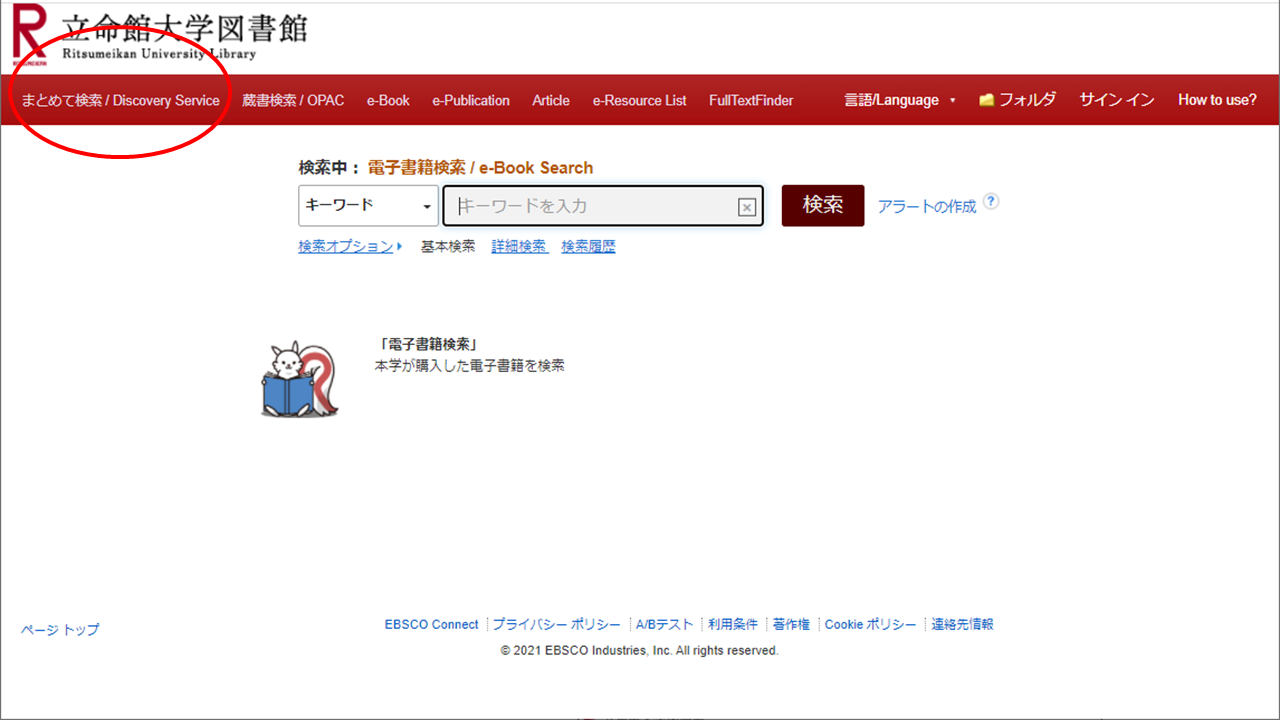 このうち「まとめて検索/RUNNERS Discovery Service」をクリックすると、右に示した「まとめて検索」の基本検索画面が表示されます。画面上部の赤帯にある「言語/Laguage」をクリックすると、操作言語を切り替えることができます。
このうち「まとめて検索/RUNNERS Discovery Service」をクリックすると、右に示した「まとめて検索」の基本検索画面が表示されます。画面上部の赤帯にある「言語/Laguage」をクリックすると、操作言語を切り替えることができます。
「まとめて検索」では、「蔵書検索」「電子書籍検索」「電子出版物検索」「論文・記事検索」で検索されるさまざまな文献をまとめて検索できるほか、入力されたキーワードに関連する新聞記事や事典・辞書の説明なども表示されます。
テキストボックスにキーワードを入力し「検索」ボタンを押すと、入力したキーワードに関連する文献等の一覧が検索結果として表示されます。「検索オプション」や「詳細検索」を使用すると、さらに精緻な検索条件を入力できます。
The following links are arranged in the red belt at the top of the screen of "RUNNERS Discovery Service", "e-publication Search", "e-book Search", and "Article Search".
| Display | Link destination | Function |
|---|---|---|
| まとめて検索 / RUNNERS Discovery Service | "Discovery Service" Screen | Cross-search the documents such as books in our library, purchased e-books, available e-publications, and articles published in journals by specifying a keyword. |
| 蔵書検索 / RUNNERS OPAC | "OPAC" Screen | Online Public Access Catalog of printed books in our library collection by specifying a keyword |
| e-book | "e-book Search" Screen | Search for e-books purchased by our library by specifying a keyword |
| e-publication | "e-publication Search" Screen | Search for titles of e-journals and e-books available at our library by specifying a keyword or from list |
| Article | "Article Search" Screen | Search for articles published in e-journals andprinted journals by specifying a keyword |
| e-Resource List | "e-Resource List" Screen | A list of various e-resources available at our library by category |
| FullTextFinder | "FullTextFinder" Screen | A tool to find out how to obtain a particular article or book |
 If you click "まとめて検索/RUNNERS Discovery Service", the basic search screen of "RUNNERS Discovery Service" shown on the right will be displayed. You can switch the operation language by clicking "言語 / Laguage" in the red belt at the top of the screen.
If you click "まとめて検索/RUNNERS Discovery Service", the basic search screen of "RUNNERS Discovery Service" shown on the right will be displayed. You can switch the operation language by clicking "言語 / Laguage" in the red belt at the top of the screen.
In "RUNNERS Discovery Service", you can search various documents searched by "OPAC", "e-book Search", "e-publication Search", and "Article Search" at once, and display articles on newspaper and the explanation of the dictionary and encyclopedia which is related to the keyword which you entered.
If you enter a keyword in the text box and press the "Search" button, a list of documents related to the entered keyword will be displayed as Search Results. You can enter more detailed search conditions by using "Search Options" or switching to "Advanced Search".
基本検索と検索オプション / Basic Search and Search Option
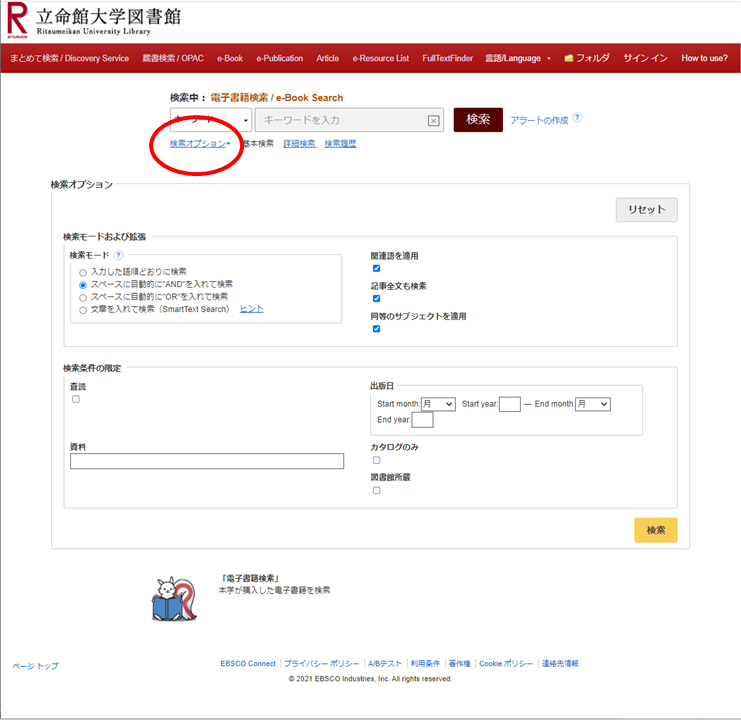 基本検索画面は、GoogleやYahooなどの検索エンジンと同じように、キーワードを入力して検索する画面です。「キーワード」の部分がドロップダウンになっており、「キーワード」「タイトル」「著者」から選択できます。「タイトル」を選んだ場合は、検索対象の文献のタイトルに入力された文字列を含むもの、「著者」を選んだ場合は、その文献の著者名に入力した文字列を含むものを検索します。
基本検索画面は、GoogleやYahooなどの検索エンジンと同じように、キーワードを入力して検索する画面です。「キーワード」の部分がドロップダウンになっており、「キーワード」「タイトル」「著者」から選択できます。「タイトル」を選んだ場合は、検索対象の文献のタイトルに入力された文字列を含むもの、「著者」を選んだ場合は、その文献の著者名に入力した文字列を含むものを検索します。
「検索オプション」をクリックすると様々な検索オプションを選択する画面が表示されます。
1. 検索モードは、複数の単語を入力したときに、それらの単語をどのように扱うかを指定します。
2. 「関連語を適用」「記事全文も検索」「同等のサブジェクトを適用」をチェックすることで、検索の範囲を広げることができます。
3. 検索条件を限定するオプションを指定できます。例えば、学術文献、フルテキストのあるもの、日本語のものなどで絞り込みできます。
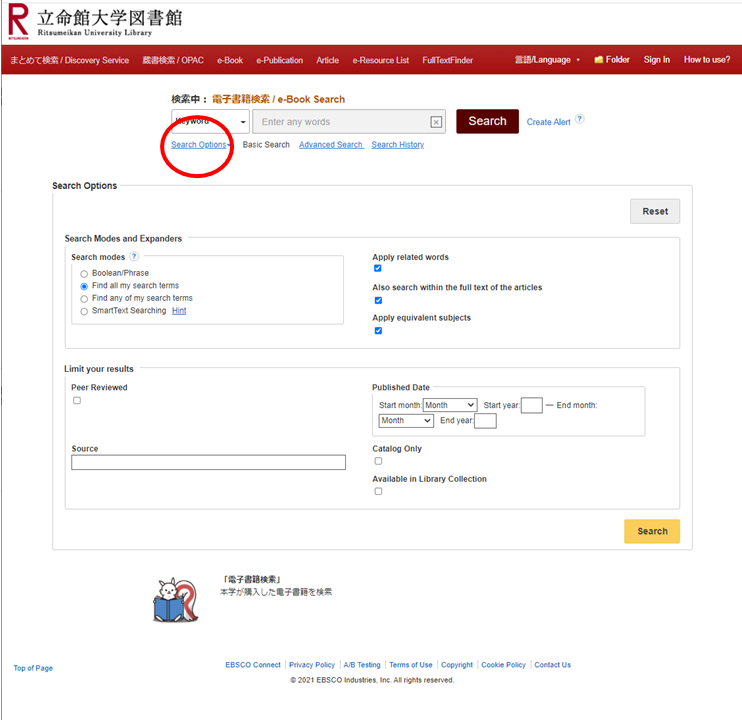 The basic search screen is a search screen where you enter a keyword and press the search button, similar to search engines such as Google and Yahoo. The "Keyword" part is a dropdown, and you can select from "Keyword", "Title", and "Author". If you select "Title", search for those that include the character string that was entered, in the title of the document to be searched, and if you select "Author", search for those that include the character string entered in the author name of the document.
The basic search screen is a search screen where you enter a keyword and press the search button, similar to search engines such as Google and Yahoo. The "Keyword" part is a dropdown, and you can select from "Keyword", "Title", and "Author". If you select "Title", search for those that include the character string that was entered, in the title of the document to be searched, and if you select "Author", search for those that include the character string entered in the author name of the document.
Clicking "Search Options" will bring up a screen where you can select various search options.
1. Search mode specifies how to handle multiple words when you enter them.
2. You can broaden your search by checking "Apply related words," "Also search within the full text of the articles," and "Apply equivalent subjects."
3. You can specify options to limit the search criteria. For example, you can narrow down to Peer Review, narrow down to those with full text, narrow down to those written in English,
and so on.
詳細検索 / Advanced Search
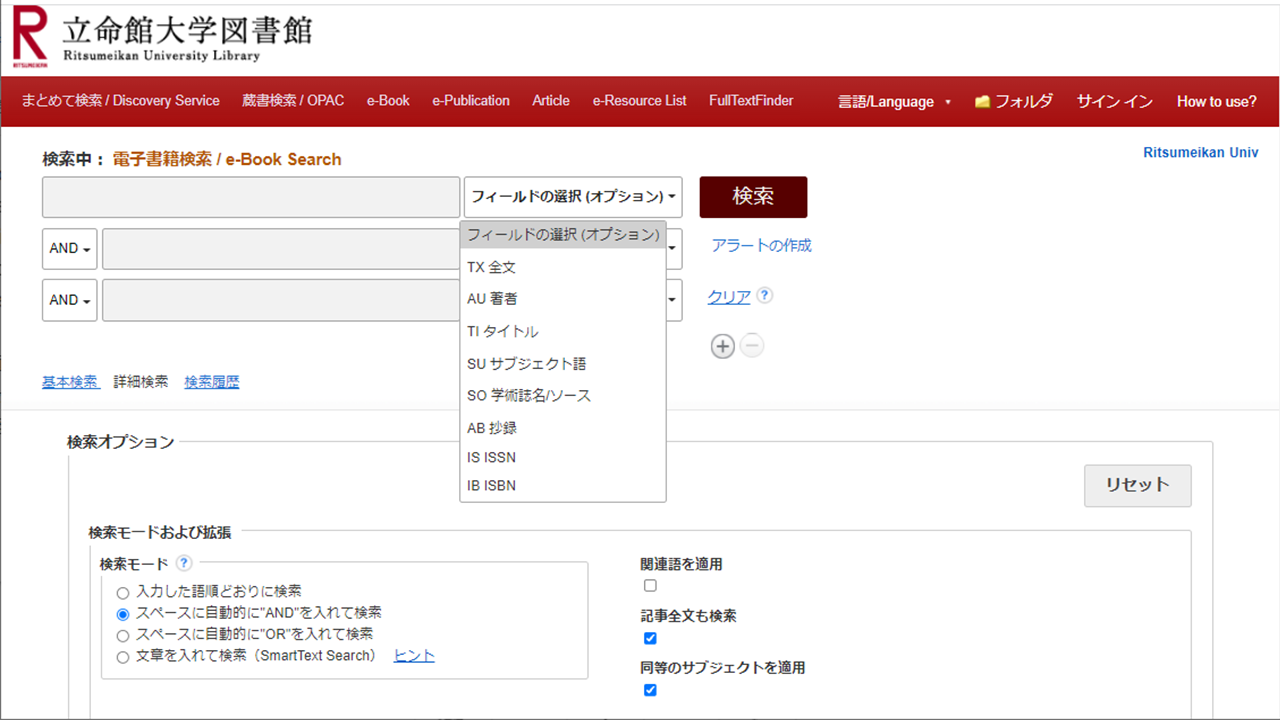 全文、著者、タイトル、サブジェクト語、学術誌名/ソース、抄録、ISSN、ISBNから複数の要素を選び、その組み合わせで対象を絞り込むことができます。
全文、著者、タイトル、サブジェクト語、学術誌名/ソース、抄録、ISSN、ISBNから複数の要素を選び、その組み合わせで対象を絞り込むことができます。
デフォルトでは3つの要素を入力する画面が表示されますが、「+」マークをクリックすると要素を増やせます。検索窓の左側に「AND」「OR」「NOT」を選択するプルダウンがあります。これらの使い方は「複数のキーワードによる検索」をご覧ください。検索を実行する場合、AndはOrよりも優先されます。
「検索オプション」に表示される条件は基本検索と同じです。
 You can select multiple elements from All Text, Authr, Title, Subjct Terms, Journal Title / Source, Abstract, ISSN and ISBN, and narrow down the target by combining them.
You can select multiple elements from All Text, Authr, Title, Subjct Terms, Journal Title / Source, Abstract, ISSN and ISBN, and narrow down the target by combining them.
In default screen, 3 elements are displaied, you can increase the number of elements by clicking the "+" mark. There is a pull-down to select "AND" "OR" "NOT" on the left side of the text box. See "Searching by Multiple Keywords" for how to use these. When executing a search, And takes precedence over Or.
The conditions displayed in "Search Options" are the same as the basic search.
関連語を適用 / Apply Related Words
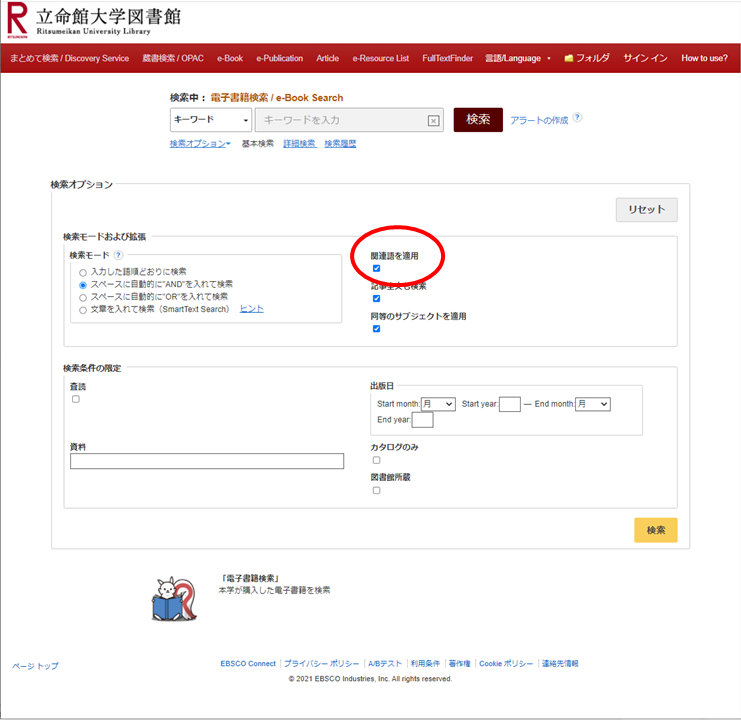 入力されたキーワードと意味が同じ用語が、書名や抄録、本文に含まれている場合に、これらの文献をまとめて検索できるようにすることは、「検索漏れ」を防ぐために重要です。「検索オプション」で「関連語を適用」をチェックした場合、それらのシソーラス(同義語や関連語を統制する辞書)をもとに、入力されたキーワードの同義語も含めて検索がなされます。例えば「Neoplasm」(癌)というキーワードで検索すると、Tumor(腫瘍)、Tumour、Tumours、Tumor's、Tumours、およびTumour'sといった用語も含めて検索がなされるため、検索漏れの少ない検索結果が得られます。
入力されたキーワードと意味が同じ用語が、書名や抄録、本文に含まれている場合に、これらの文献をまとめて検索できるようにすることは、「検索漏れ」を防ぐために重要です。「検索オプション」で「関連語を適用」をチェックした場合、それらのシソーラス(同義語や関連語を統制する辞書)をもとに、入力されたキーワードの同義語も含めて検索がなされます。例えば「Neoplasm」(癌)というキーワードで検索すると、Tumor(腫瘍)、Tumour、Tumours、Tumor's、Tumours、およびTumour'sといった用語も含めて検索がなされるため、検索漏れの少ない検索結果が得られます。
 When terms that have the same meaning as the entered keyword are included in the title, abstract, or text, it is important to be able to search these documents together to prevent "missing searches". If you check "Apply Related Words" in "Search options", the search will be performed including synonyms of the entered keyword based on those thesaurus (dictionaries that control synonyms and related words). For example, a search for Neoplasm with the Apply Related Words expander applied would also search for Tumor, Tumour, Tumors, Tumor's, Tumours, and Tumour's.
When terms that have the same meaning as the entered keyword are included in the title, abstract, or text, it is important to be able to search these documents together to prevent "missing searches". If you check "Apply Related Words" in "Search options", the search will be performed including synonyms of the entered keyword based on those thesaurus (dictionaries that control synonyms and related words). For example, a search for Neoplasm with the Apply Related Words expander applied would also search for Tumor, Tumour, Tumors, Tumor's, Tumours, and Tumour's.
同等のサブジェクトの適用 / Apply Equivalent Subjects
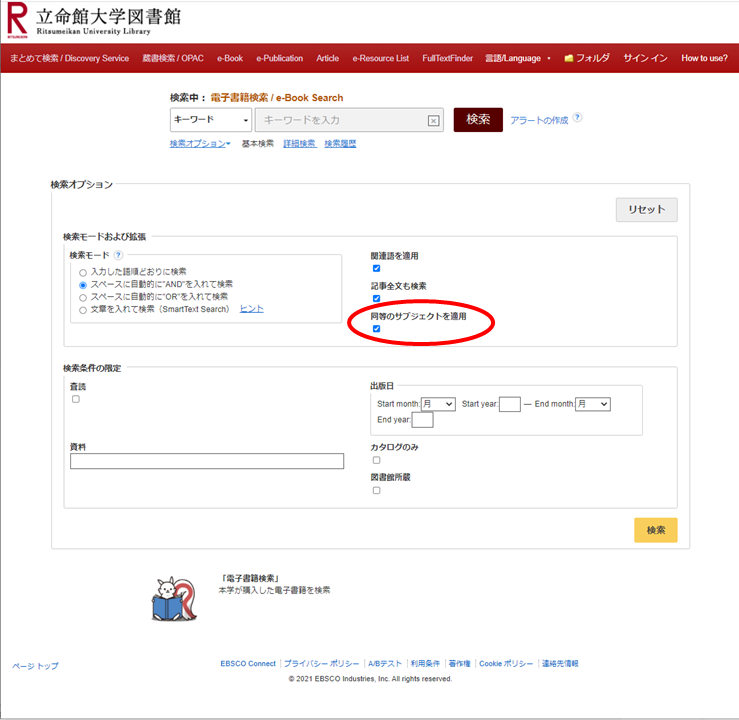 「検索オプション」で「同等のサブジェクトを適用」をチェックした場合、文献ごとに登録されているサブジェクト(主題)を対象に、各学問分野に特化した複数のシソーラスでマッピングしながら検索が行われます。例えば「Learning aids」という単語を入力すると、ERIC, MLA International Bibliographyのシソーラスでは「instructional materials」、GeoRefのシソーラスでは「educationaln resources」、PsycINFOのシソーラスでは「Instructional media」という単語にそれぞれマッピングされ、サブジェクトにこれらの単語を含むものもまとめて検索されます。
「検索オプション」で「同等のサブジェクトを適用」をチェックした場合、文献ごとに登録されているサブジェクト(主題)を対象に、各学問分野に特化した複数のシソーラスでマッピングしながら検索が行われます。例えば「Learning aids」という単語を入力すると、ERIC, MLA International Bibliographyのシソーラスでは「instructional materials」、GeoRefのシソーラスでは「educationaln resources」、PsycINFOのシソーラスでは「Instructional media」という単語にそれぞれマッピングされ、サブジェクトにこれらの単語を含むものもまとめて検索されます。
この場合、さまざまなデータベースに関連付けられているシソーラスが同時に使われます。適用の対象となるのは「サブジェクト」のほか、ほとんどの場合、著者、タイトル情報(書名)、抄録、キーワードに存在する用語に対しても、同義語や関連語を使った検索が行われます。
 If you check "Apply equivalent subjects" in "Search options", The search is performed while mapping the subjects registered for each document with multiple thesauruses specialized for each academic field. For example, when you enter the word "Learning aids" to text box, the word "instructional materials" well be mapped in the ERIC, MLA International Bibliography thesaurus, the word "educational n resources" well be mapped in the GeoRef thesaurus, and the word "Instructional media" well be mapped in the PsycINFO thesaurus, so those that include these words in the subject, title, abstract, etc. are also searched.
If you check "Apply equivalent subjects" in "Search options", The search is performed while mapping the subjects registered for each document with multiple thesauruses specialized for each academic field. For example, when you enter the word "Learning aids" to text box, the word "instructional materials" well be mapped in the ERIC, MLA International Bibliography thesaurus, the word "educational n resources" well be mapped in the GeoRef thesaurus, and the word "Instructional media" well be mapped in the PsycINFO thesaurus, so those that include these words in the subject, title, abstract, etc. are also searched.
In this case, the thesaurus associated with different databases is used at the same time. Searches using synonyms and related terms are not limited to "subjects", but in most cases "Authors", "Keywords", "Title information" (including source title), and "Abstracts". It also applies to existing terms.
フレーズによる検索 / Including Phrases in a Search
検索語を二重引用符で囲むと(例えば、"global warming")、検索エンジンはこれをひとつのフレーズとして検索します。また、「been」「however」「so」など冠詞、代名詞、前置詞などの一般的に使用される単語は「ストップワード」として無視します。ストップワードは、引用符で囲まれている場合でも常に無視されます。例えばタイトルを対象に"iPS細胞の培養"と入力して検索した場合、「iPS細胞の培養技術」「iPS細胞培養基材」などが検索結果に表示されます。「iPS細胞3次元培養」「iPS細胞のタンパク質ハイドロゲル内培養評価」などは検索結果には表示されません。ストップワードは、関連性が最小限であるため検索辞書に追加されませんが、近接度(単語間の距離)の単語としてカウントされます。
また、区切り文字を使用してフレーズを入力すると、検索エンジンは区切り文字を使用する場合と使用しない場合の両方で用語を検索します。 たとえば、「ディープ=ラーニング」と入力して検索すると、検索エンジンは「ディープラーニング」「ディープ・ラーニング」などの結果もあわせて表示します。
詳しくはこちらを参照。ストップワードの扱いについての詳細はこちらを参照。
When you encloses search terms with double quotation marks (i.e. "global warming") the search engine looks for words in the exact order in any field in the metadata and full text (when applicable). EBSCO treats certain words as "stop words"––such as articles, pronouns and prepositions for example, been, however, or so. Stop words are always ignored, even if they are enclosed in quotation marks. Stop words are not added to the search dictionary, since their relevance is minimal, but they are counted as words for proximity (the distance between words). If you enter phrases with punctuation, the search engine searches for the term both with and without the punctuation. For example, if you enter "television: talk show", the search engine finds results with "television talk-show", "television talk show", and if synonyms have been activated, "TV talk show".
See here for details. And for details about Stop Word, click here.
キーワードの一部を指定した検索 / Searching by specifying a part of the keyword
トランケーション・シンボル「*」を使うと、そこに任意の文字列の入った単語で検索します。
→例:「Nurs*」…「norse」「noused」「nurses」「nurrsing」などが含まれるコンテンツが検索されます。
ワイルドカード・シンボル「?」を使うと、その部分が任意の1文字に置き換えられた単語で検索します。
→例:「Ne?t」…「Next」「Neat」などが含まれるコンテンツが検索されます。
Use the truncation symbol "*" to search for words with any string in it
→ Example: “Nurs*”… Content that includes charactor string such as “norse”, “noused”, “nurses”, “nurrsing”, etc. is searched.
Use the wildcard symbol "?" To search for a word whose part has been replaced with any single letter.
→ Example: "Ne?t" ... Content that includes charactor string such as "Next", "Neat", etc. is searched.
複数のキーワードによる検索 / Searching by Multiple Keywords
複数のキーワードが入力された場合、デフォルトでは、入力されたすべてのキーワードが含まれるコンテンツを検索します。検索オプションで、入力されたキーワードのいずれかが含まれるコンテンツの検索や、入力した語順通りに単語が並んでいるコンテンツの検索、入力された文章をもとに検索するモードに変更できます。
→例:「イヌ ネコ」…デフォルトでは、「イヌ」「ネコ」両方が含まれるコンテンツが検索されます。
AND演算子は、ANDの左右にある両方のキーワードが含まれるコンテンツを検索します。
→例:「イヌ AND ネコ」…「イヌ」「ネコ」両方が含まれるコンテンツが検索されます。
OR演算子は、ORの左右にあるどちらかのキーワードが含まれるコンテンツを検索します。
→例:「地震 OR 津波」…「地震」に関するコンテンツと、「津波」に関するコンテンツの両方が検索されます。
NOT演算子は、NOTの右にあるキーワードを含まないコンテンツを検索します。
→例:「火災 NOT 地震」…「火災」に関するコンテンツのうち、「地震」と関係しないコンテンツが検索されます。
Nx演算子(xは255以下の数字)は、その演算子の左右にあるキーワードがx文字(英文の場合はx語)以内に近接しているコンテンツを検索します。
→例:「サッカー N20 運動能力」…「サッカー」と「運動能力」が20文字以内に近接しているコンテンツを検索します。「サッカー and 運動能力」よりも、より「サッカー」と「運動能力」の関係性が強いコンテンツの検索が期待できます。
Wx演算子(xは255以下の数字)は、その演算子の左右にあるキーワードがx文字(英文の場合はx語)以内に近接していて、かつ左のキーワードが右のキーワードよりも先にあるコンテンツを検索します。
→例:「卵 W5 鶏」…「卵から鶏が生まれる」は検索されますが、「鶏が卵を産む」は検索されません。
これらの演算子を組み合わせて使うときは「( )」を使って優先順位を指定できます。
→例:「((野球 OR サッカー) W5 (監督 OR コーチ)) AND 指導法」
検索演算子についてはこちら、近接検索についてはこちらを参照。
If multiple keywords are entered, the default is to search for content that contains all the keywords entered. In the search option, you can select the search option, searching for content that includes any of the entered keywords, searching for content in which words are arranged in the entered word order, or searching based on the entered sentence.
→ Example: "Dog Cat" ... By default, content that includes both "Dog" and "Cat" is searched.
The AND operator searches for content that contains both keywords to the left and right of AND.
→ Example: "Dog AND Cat" ... Content that includes both "Dog" and "Cat" is searched.
The OR operator searches for content that contains either of the keywords to the left or right of the OR.
→ Example: "Earthquake OR Tsunami" ... Both the content related to "Earthquake" and the content related to "Tsunami" are searched.
The NOT operator searches for content that does not contain the keyword to the right of NOT.
→ Example: "Fire NOT Earthquake" ... Among the contents related to "Fire", the contents not related to "Earthquake" are searched.
The Nx operator (x is a number less than or equal to 255) searches for content in which the keywords to the left and right of the operator are within x characters (x words in English).
→ Example: "Soccer N20 Physical" ... Search for content in which "Soccer" and "Physical" are close to each other within 20 words. You can expect to be able to search for content that has a stronger relationship between "Soccer" and "Physical" than "soccer and athletic ability".
For the Wx operator (x is a number of 255 or less), the keywords to the left and right of the operator are close to each other within x characters (x words in English), and the left keyword precedes the right keyword. Search for content located at.
→ Example: "Egg W5 Chicken" ... "Chicken is born from Egg" is searched, but "Chicken lays Egg" is not searched.
When using these operators in combination, you can use "()" to specify the priority.
→ Example: "((Baseball OR Soccer) W5 (Director OR Coach)) AND Teaching Method"
For about "Booleans" click here. For about "Proximity Searches" click here.
フィールドコードによる検索条件指定 / Search Conditions by field Code
検索式を入力する際、フィールドコードを用いて検索対象のフィールドが指定できます。「まとめて検索」では「SU」(サブジェクト語)、「AU」(著者)、「TI」(タイトル)などのフィールドコードを使用できます。例えば、簡易検索画面の検索窓に
AU "Yamanaka Shinya" AND SU "iPS cells"
と入力すると、入力された検索式の条件に適合する検索結果が得られます。
詳細検索画面に表示されるさまざまな検索オプションについても、検索式に入力できます。例えば
FT Y
という条件を検索式に追加すると、フルテキストにアクセスできるものだけを検索対象にできます。
詳しくはEBSCOのサポートページをご覧ください。
フィールドコードについてはこちら、リミッターによる絞り込みについてはこちらを参照
When you enter a search expression, you can use the field code to specify the field to search for. You can use field codes such as "SU" (subject word), "AU" (author), and "TI" (title) in "RUNNERS Discovery Service". For example, if you enter
AU "Yamanaka Shinya" AND SU "iPS cells"
in the search window of the Basic Search screen, you will get search results that match the criteria of the search expression you entered.
You can also enter various search options in the search formula that appear on the Advanced Search screen. For example if you add the condition to the search expression,
FT Y
you can search only those that have access to full text.
See EBSCO Support Page for details.
For about "Field Codes" click here. For about "Limiters" click here.
検索ノイズと検索もれ / Search Noise and Drop-out
特定の文献を探す場合、その文献のタイトルや著者などで検索し、検索結果の中に探している文献を見つけることができれば成功といえます。しかし、想定しているテーマに関係する文献を手当たり次第に探し出したいという場合、検索条件の入力の仕方によっては、探そうとしているテーマとは関係のない「検索ノイズ」ばかりが検索結果画面に表示されたり、反対に、探そうとしているテーマに関係があるのに検索結果画面には表示されない「検索もれ」が生じます。一般的に、「検索ノイズ」を減らそうとすると「検索もれ」が、「検索もれ」を減らそうとすると「検索ノイズ」が増えてしまいます。「検索ノイズ」や「検索もれ」を減らすためには検索条件に工夫が必要です。
「検索ノイズ」が多い場合の対応として考えられる方策は、キーワードをAND条件で増やしていくことです。「発電における地球温暖化対策」について調べたいときに、「発電」「地球温暖化対策」というキーワードに「再生可能エネルギー」というキーワードを加えると、火力発電所で二酸化炭素の排出を減らすことについて記述した文献などは検索されにくくなります。もし、技術的なことではなく、政府の政策について調べたい場合は「政府」「政策」などのキーワードを加えることによって、検索結果を絞り込むことができます。原子力発電については除きたいという場合は「NOT 原子力」という条件を加えるとよさそうですが、タイトルを対象にこの条件を指定すると「原子力発電に頼らない地球温暖化対策」などといったタイトルの文献も結果リストから消えてしまいますので、注意が必要です。
「検索もれ」が多い場合の対応として考えられる方策は、同義語や類義語をOR条件で追加することです。「(発電 OR 電力 OR 電気) AND (地球温暖化 OR 二酸化炭素 OR 再生可能 OR クリーン)」などと条件を指定すると、「発電 AND 地球温暖化」では見つからなかった文献も検索結果に表示されるようになります。他の項目で説明している「関連語の適用」や「同等のサブジェクトの適用」も、このように同義語や類義語を使って「検索もれ」を少なくすることに有効です。
検索するフィールドをどのように指定するかによって、「検索ノイズ」や「検索もれ」の量は大きく変わります。入力したキーワードを「全文」や「抄録」と照合すれば、それだけ多くの検索結果を得られますが「検索ノイズ」も増えます。「タイトル」や「サブジェクト語」と照合するようにすれば、検索結果は減って「検索ノイズ」は減りますが、「検索もれ」は増えてしまうかもしれません。
検索結果は、いつでも多い方が良い、という訳ではありません。「検索もれ」が少ない検索結果であっても、「検索ノイズ」が多ければ、大量の検索結果から「検索ノイズ」を取り除くために多くの手間がかかってしまいます。その手間を惜しんで、検索結果の上位だけを見ると、下位の検索結果は「検索もれ」と同じ扱いになってしまいます。「検索ノイズ」が多い場合は、記事全文を検索しない、査読された学術論文だけに限定する、直近の数年間に発表されたものだけに絞るなど、検索対象を減らしてください。その一方で、関連語や類義語を含めた検索をするなど、「検索もれ」の少ない検索条件を指定して、最適な検索結果が得られるように工夫をしてください。
If you are looking for a specific document, enter the title, author, etc. of the document and search, and if you can find the document you are looking for in the search results, it is a perfect search. However, if you want to randomly search for documents related to the theme you are assuming, depending on how you enter the search conditions, only "search noise" that is not related to the theme you are searching for will be displayed on the search result screen. Or, on the contrary, there may be a "drop-out" that is not displayed on the search result screen even though it is very related to the theme you are looking for. In general, trying to reduce "search noise" will increase "drop-out", and reducing "drop-out" will increase "search noise". If you want to get search results with few "search noise" and "drop-out", you need to devise search conditions.
The most conceivable measure to deal with a lot of "search noise" is to increase the number of keywords with AND conditions. When you want to find out about "global warming countermeasures in power generation", if you add the keywords "renewable energy" in addition to the keywords "power generation" and "global warming countermeasures", the documents describing reducing carbon dioxide emissions at existing thermal power plants will disappear from the search results. If you want to find out about government policies rather than technical documents, add keywords such as "government" and "policy" to further narrow your search results. If you want to exclude nuclear power generation, you should add the condition "NOT nuclear power", but if you specify this condition for the title, documents with titles such as "Global warming countermeasures that do not rely on nuclear power generation" will disappear from the result list, so be careful.
If there are many "drop-outs", a possible solution is to add synonyms and synonyms under the OR condition. If you specify conditions such as "(Power generation OR Power plant OR Electricity) AND (Global warming OR Carbon dioxide OR Renewable OR Clean)", documents not found in search result of "Power generation AND Global warming" will be displayed in the search results. The "Apply Related Words" and "Apply Equivalent Subjects" described on this page are also useful in reducing "drop-outs" by using synonyms and synonyms in this way.
The amount of "search noise" and "drop-out" varies greatly depending on how you specify the fields to search. If you collate the entered keyword with "All Text" or "Abstract", you will get more search results, but "search noise" will also increase. Matching with "Title" or "Subjct Terms" will reduce search results and reduce "search noise", but may increase "drop-out".
Having a lot of search results is not always better than having a few. Even if the search result has few "drop-outs", if there is a lot of "search noise", it will take a lot of time and effort to remove the "search noise" from a large number of search results. If you only look at the top of the search results to reduce time and effort, the bottom search results will be droped out. If there is a lot of "search noise", try not to search the entire article, limit it to peer-reviewed academic articles, or limit it to those published in the last few years to reduce the search target. On the other hand, specify search conditions to reduce "drop-out", such as searching with related words and synonyms, and devise ways to obtain optimal search results.
電子書籍検索について / About the e-book Search
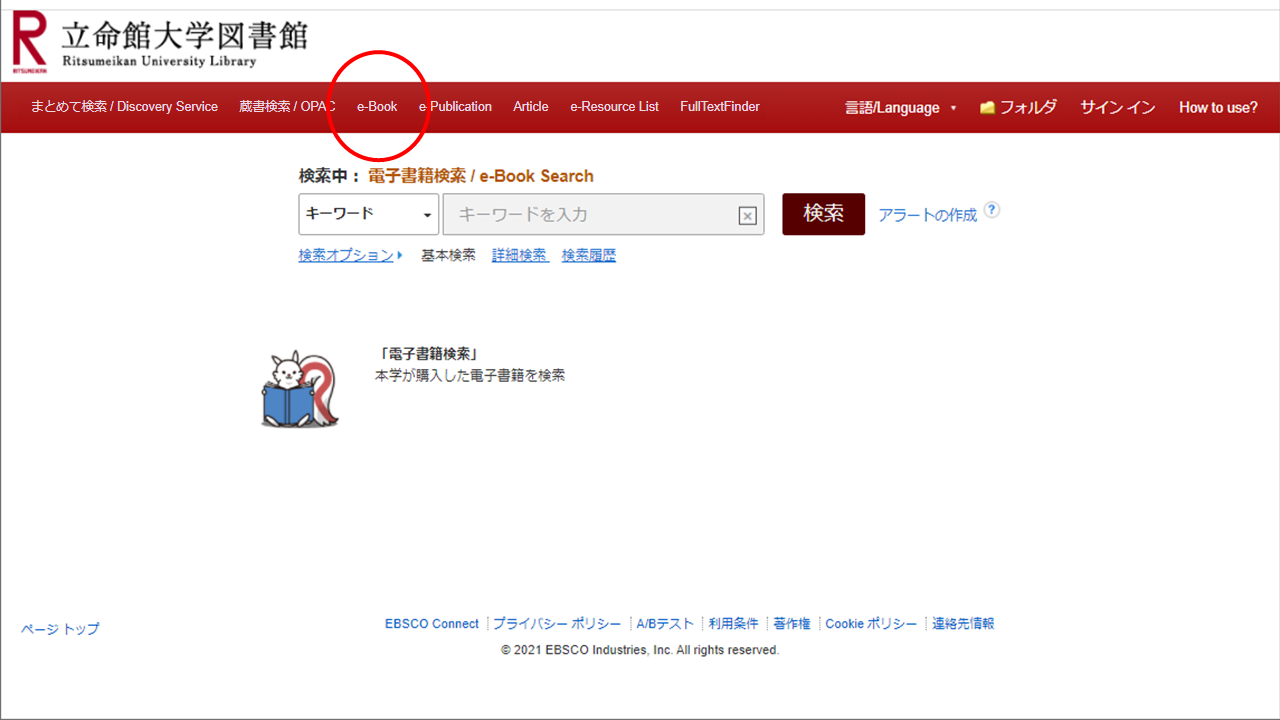 「電子書籍検索」は、図書館がアクセス権を購入した電子書籍だけを検索できます。検索オプションや詳細検索画面の使い方、関連語の適用や複数のキーワードによる検索式の入力方法などは、「まとめて検索」と同じです。
「電子書籍検索」は、図書館がアクセス権を購入した電子書籍だけを検索できます。検索オプションや詳細検索画面の使い方、関連語の適用や複数のキーワードによる検索式の入力方法などは、「まとめて検索」と同じです。
「電子書籍検索」で見つけた電子書籍は、学内ネットワーク(RAINBOW)に接続されたパソコンやスマホから閲覧できます。大部分のものはそれらのパソコンやスマホにダウンロードすることが可能で、その後はネットワークにつながっていなくても読むことができます。
学内ネットワークから閲覧可能な電子書籍のうち、サブスクリプション契約でアクセス権を得ているものや、電子書籍以外のさまざまな情報リソースとまとめてパッケージ購入しているものなどは、「電子書籍検索」では見つかりません。本学との契約の有無にかかわらずフリーで閲覧できる電子書籍についても同様です。これらの電子書籍を見つけるには「電子出版物検索」か「まとめて検索」で検索してください。
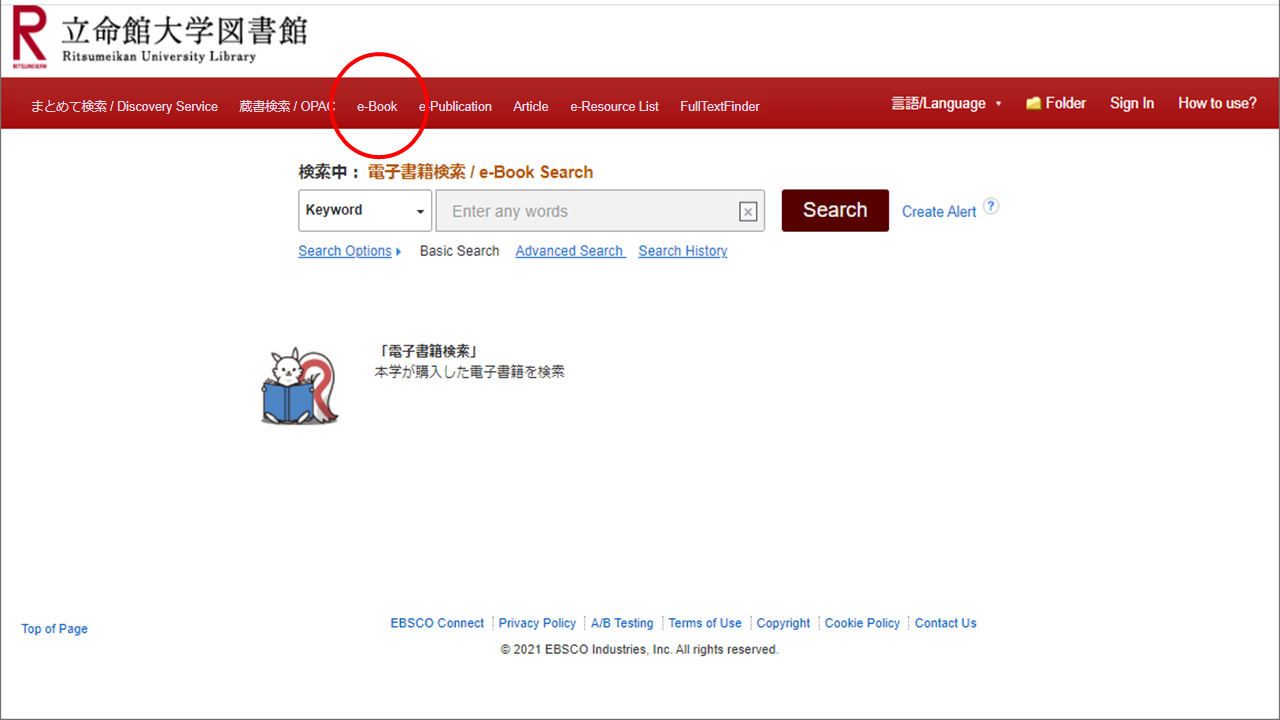 The "e-book search" is a search screen that narrows down the search target of the "RUNNERS Discovery Service" to only e-books which purchased and owned by our library. How to use Search Option and Advanced Search, how to apply related words and how to enter search expressions using multiple keywords are the same as "Discovery Service".
The "e-book search" is a search screen that narrows down the search target of the "RUNNERS Discovery Service" to only e-books which purchased and owned by our library. How to use Search Option and Advanced Search, how to apply related words and how to enter search expressions using multiple keywords are the same as "Discovery Service".
The e-books found on the "e-book search" can be viewed from a computer or smartphone connected to the campus network (RAINBOW). Most of them can be downloaded to those computers and smartphones, after downloading they can be read even if they are not connected to the network.
Among the e-books that can be viewed from the campus network, those that we have access rights under a subscription contract and those that are purchased as a package together with various information resources other than e-books, are nor found in the "e-book search". The same applies to e-books that can be viewed free of charge regardless of whether or not there is a contract with our university. To find these e-books, search in "e-publication search" or "RUNNERS Discovery Servicee".
電子出版物検索について / About the e-publication Search
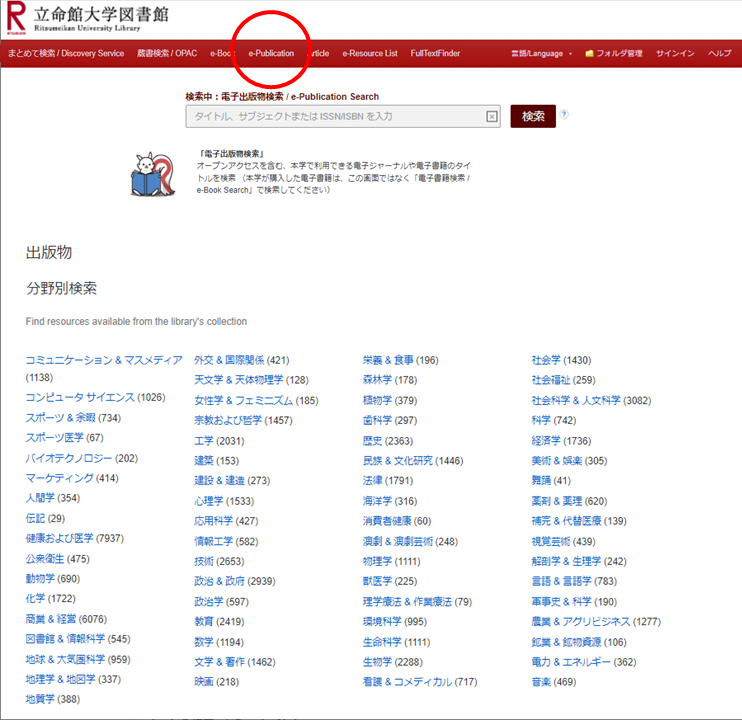 「e-publication(電子出版物検索)」は、電子書籍や電子ジャーナル、新聞、ニューズレター、レポート、ブックシリーズなどのタイトルから電子出版物を検索できます。入力されたキーワードに関係する文献を幅広く検索しようとする場合に使う「まとめて検索」とは違い、主に検索しようとしている電子出版物が特定されている場合に使われます。テキストボックスに入力するキーワードは、タイトル、サブジェクト、または ISSN / ISBN です。
「e-publication(電子出版物検索)」は、電子書籍や電子ジャーナル、新聞、ニューズレター、レポート、ブックシリーズなどのタイトルから電子出版物を検索できます。入力されたキーワードに関係する文献を幅広く検索しようとする場合に使う「まとめて検索」とは違い、主に検索しようとしている電子出版物が特定されている場合に使われます。テキストボックスに入力するキーワードは、タイトル、サブジェクト、または ISSN / ISBN です。
画面の下半分には、出版物を主なテーマ別に分類して一覧表にするためのリンクが並べられています。使われている分類は、このシステムを提供するEBSCO社独自のものです。
 "e-publication" such as e-journal, e-book, newspaper, newsletter, report, and book series. Unlike "Discovery Service", which is used to make a wide range of search specifications for documents related to the entered keyword, it is mainly used when you are searching for specified e-publication. The keywords you enter in the text box are limited to title, subject, or ISSN / ISBN.
"e-publication" such as e-journal, e-book, newspaper, newsletter, report, and book series. Unlike "Discovery Service", which is used to make a wide range of search specifications for documents related to the entered keyword, it is mainly used when you are searching for specified e-publication. The keywords you enter in the text box are limited to title, subject, or ISSN / ISBN.
In the bottom half of the screen, you'll find links to sort and list your publications by major theme. The classification of the theme used is unique to EBSCO, which provides this system.
 検索結果は右の図のような画面で表示されます。この画面で、査読誌だけ、出版物ごとに付けられているサブジェクト語、リソースタイプなどによる絞り込みができます。
検索結果は右の図のような画面で表示されます。この画面で、査読誌だけ、出版物ごとに付けられているサブジェクト語、リソースタイプなどによる絞り込みができます。
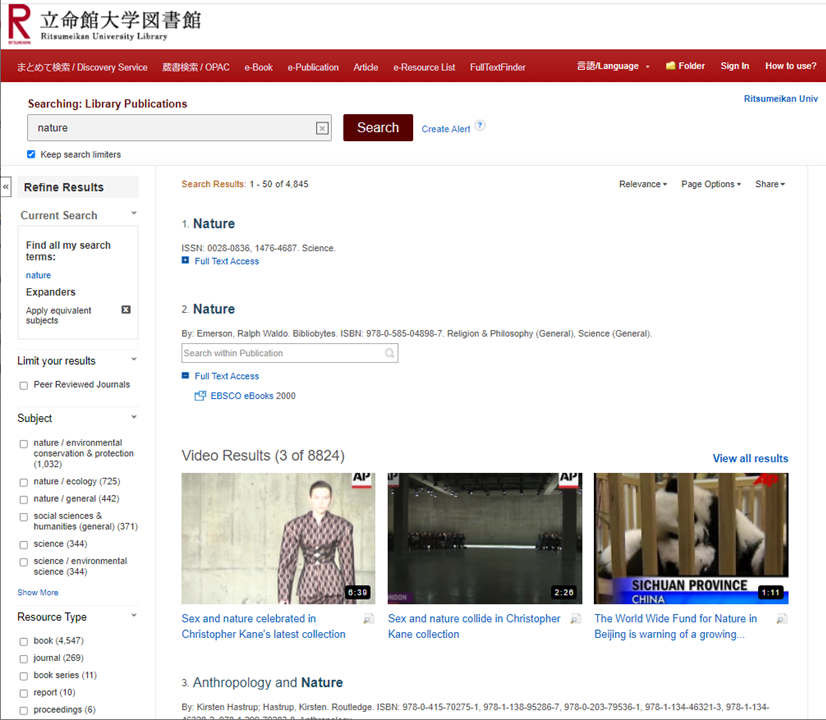 The search results will be displayed in a screen like the one shown in the figure on the right. On this screen, you can narrow your search by peer-reviewed journals only, subject terms attached to each publication, resources type, etc.
The search results will be displayed in a screen like the one shown in the figure on the right. On this screen, you can narrow your search by peer-reviewed journals only, subject terms attached to each publication, resources type, etc.
「電子出版物検索」で検索される電子書籍 / e-books Searched by "e-publication Search"
図書館が電子書籍へのアクセス権を得るためにサブスクリプション契約をする場合があります。契約が終了するとアクセス権はなくなる一方、新しい電子書籍が出版された場合は契約の範囲でそのタイトルのアクセス権も自動的に得ることができます。これらの電子書籍は図書館の蔵書検索(RUNNERS OPAC)では検索できませんが、「電子出版物検索」では検索できます。
また、インターネット上には、契約や金銭的対価の支払いなしに、自由に閲覧が可能な電子出版物があります。例えば、著作権が切れた小説等を無料で公開している「青空文庫」や海外の「Project Gutenberg」、オープンアクセスの電子出版物、大学などが無料で公開しているさまざまな電子出版物などです。これらのうち一定の水準を満たしているものは「電子出版物検索」画面で検索できます。
図書館が個別に購入している電子書籍については、購入の都度、書名や著者、サブジェクト語のほか、一部については目次や抄録などをシステムに登録しています。これらを検索するときは「電子書籍検索」を使ってください。
libraries may enter into a subscription agreement to gain access to an e-book. When the contract ends, the access rights will be lost, but if a new e-book is published, the library will also automatically get access rights to that title within the scope of the contract. These e-books cannot be searched in the library's collection search system, but they can be searched in the "e-publications Search".
There are electronic publications on the Internet that can be freely accessed without contract or monetary compensation.For example, there is Aozora Bunko, which offers free access to novels and other works whose copyrights have expired, Project Gutenberg from overseas, open-access electronic publications, and various electronic publications offered free of charge by universities and other institutions.Those that meet certain criteria can be searched on the "e-publication Search" screen.
e-books purchased individually by the library are registered with the book title, author name, subject term, and in some cases, the table of contents and abstract.These can be searched on the "e-book Search" screen.
特定の電子ジャーナルを探す / Search for a Specific e-journal
 「電子出版物検索」の検索窓に文字列を入力すると、オートコンプリート機能により、入力した文字列を含む出版物のタイトルが候補として表示されます。検索しようとしているジャーナルのタイトルを選択すると、タイトルが完全に一致する出版物が検索結果の先頭に表示されます。タイトルだけでは十分に絞り込めない場合は、検索結果画面の左側に表示されるファセットを使って、リソースタイプを「journal」だけに絞る、出版社を選択するなどしてください。
「電子出版物検索」の検索窓に文字列を入力すると、オートコンプリート機能により、入力した文字列を含む出版物のタイトルが候補として表示されます。検索しようとしているジャーナルのタイトルを選択すると、タイトルが完全に一致する出版物が検索結果の先頭に表示されます。タイトルだけでは十分に絞り込めない場合は、検索結果画面の左側に表示されるファセットを使って、リソースタイプを「journal」だけに絞る、出版社を選択するなどしてください。
なお、入力した文字列に完全に一致するタイトルの出版物だけを検索する「完全一致検索」や、タイトルが入力した文字列から始まる出版物だけを検索する「前方一致検索」の機能はありません。
ジャーナルの名称に略称が使われる場合があります。例えば、参考文献リストの中で「Scientific Reports」というジャーナルのタイトルが「Sci. Rep.」と表記されていることがあります。省略されたタイトルで検索した場合、電子出版物検索では上手くジャーナルを見つけることができないことがあります。「まとめて検索」画面で検索すると見つかることもありますので試してください。
このような省略形が使われるのは、80桁のパンチカードによってコンピューターへの入力がなされていた時代に必要とされたことに由来するもので、早い段階で論文データベースが構築された化学、医薬学分野などを中心に、引用文献や参考文献を省略形で表記する慣行が続いています。省略の仕方は、ISO規格、ISO 4:1997 Information and documentation — Rules for the abbreviation of title words and titles of publicationsで定められていますが、これと異なる省略形が使われることもあります。
As you enter a character string into the text box of the "e-publication Search", the auto-complete function will be activated and the title of the publication containing the entered character string will be displayed as a candidate. Use the mouse pointer to select the title of the journal you are searching for, and the publications with the exact title will appear at the beginning of the search results. Many journal titles are made up of common nouns, and the title alone may not be enough to narrow down the list. Use the facets displayed on the left side of the search results screen to narrow down the resource type to "journal" or select a publisher to search.
There is no "exact match search" function that searches only publications with titles that exactly match the entered character string, or "prefix match search" that searches only publications that start with the entered character string.
Abbreviations may be used in journal names. For example, the journal "Scientific Reports" may be titled "Sci. Rep." in the bibliography list. If you search by abbreviated title, you may not be able to find the journal well by "e-publication Search". You may find it by searching on the "Descovery Service", so please try it.
These abbreviations are used because they were needed in the days when 80-digit punched cards were used to enter computers, and the practice of abbreviating citations and references continues, especially in the fields of chemistry and medicine that a article database was built early. The abbreviations are specified in the ISO standard, ISO 4: 1997 Information and documentation — Rules for the abbreviation of title words and titles of publications, but different abbreviations may be used.
電子ジャーナルの継続誌、関連誌 / Continued Journals and Related Journals of the e-journals
ジャーナルの中には、繰り返し刊行されるうちに誌名の変遷、他のジャーナルへの吸収、他のジャーナルの派生などが生じる場合があります。タイトルは正しいはずなのに巻号が見つからないときは、こうした関連出版物についても調べてください。
関連出版物を調べるには、Serials directory を使う方法と CiNii Books を使う方法があります。Serials directory はEBSCO社が提供する逐次刊行物の書誌情報に関するデータベース、CiNii Books は国立情報学研究所のデータベースで日本国内の大学図書館に所蔵されている出版物が対象です。どちらも、すべての継続誌や関連誌の情報を網羅しているわけではありませんので、両方で確認されることをお勧めします。
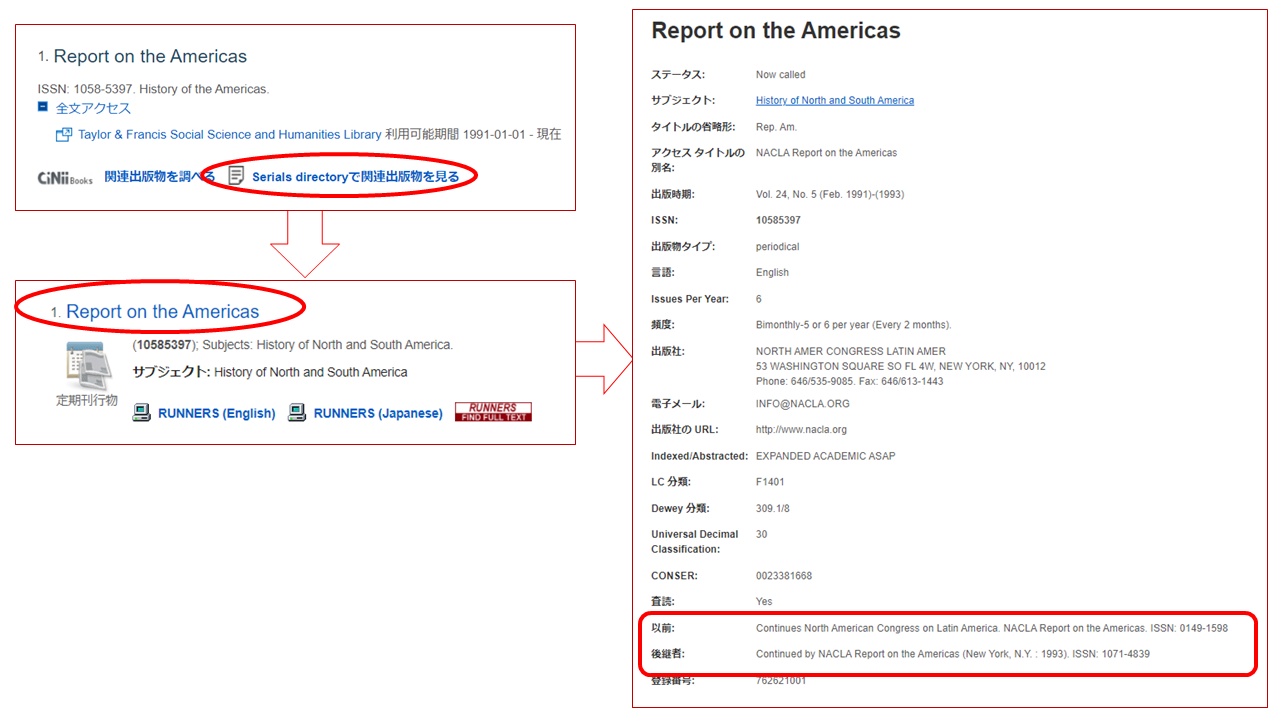 Serials directory を使う場合は、右の図のように Serials directory のアイコンをクリックしてください。 Serials directory の画面が表示されたら、ジャーナルのタイトルをクリックしてください。すると、右の図の右半分にあるように、そのジャーナルの書誌が表示されます。「以前」と書かれているのが継続前誌、「後継者」が継続後誌です。「Continued by」と書かれている場合はタイトルが変更されてそのまま継続されていること、「Merged into」と書かれている場合はそのあとに記されているジャーナルに吸収されて継続していることを示しています。
Serials directory を使う場合は、右の図のように Serials directory のアイコンをクリックしてください。 Serials directory の画面が表示されたら、ジャーナルのタイトルをクリックしてください。すると、右の図の右半分にあるように、そのジャーナルの書誌が表示されます。「以前」と書かれているのが継続前誌、「後継者」が継続後誌です。「Continued by」と書かれている場合はタイトルが変更されてそのまま継続されていること、「Merged into」と書かれている場合はそのあとに記されているジャーナルに吸収されて継続していることを示しています。
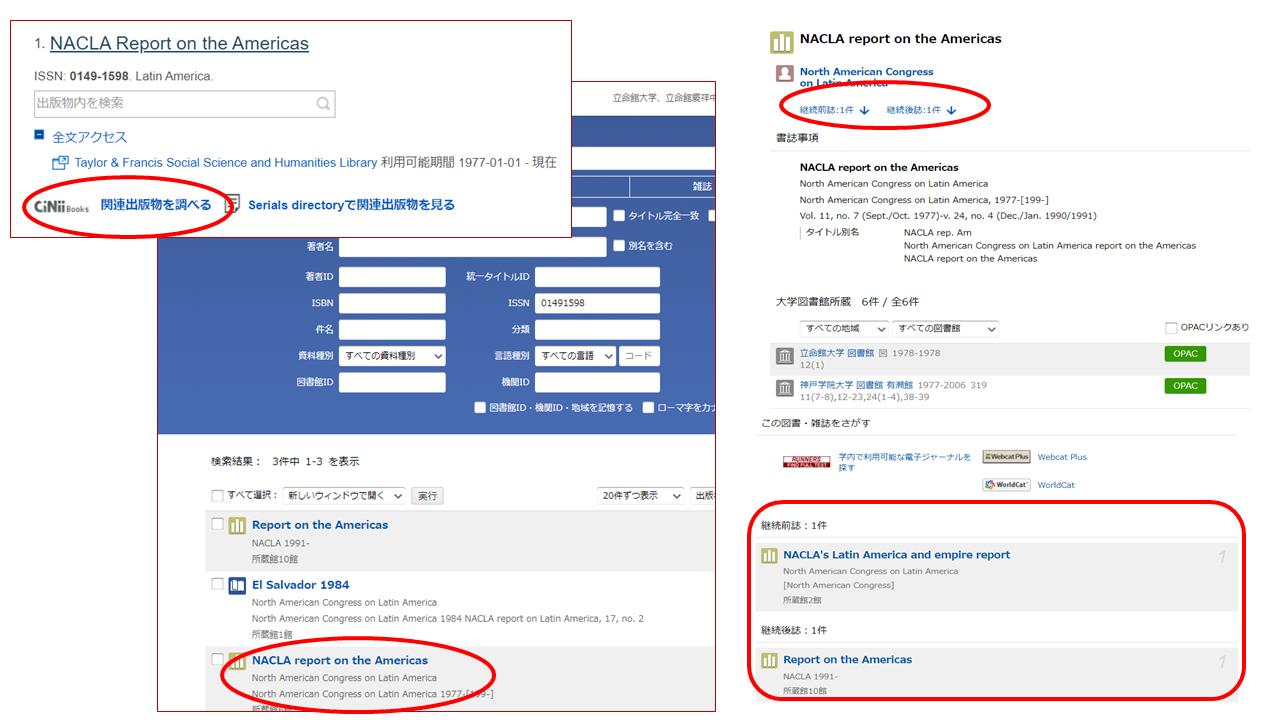 CiNii Books を使う場合は、右の図のように、CiNii Books のアイコンをクリックしてください。電子出版物検索で検索された出版物と CiNii Books に登録されている出版物は、1対1で対応するわけではありませんので、右の図のように複数の出版物が表示されることがあります。該当するものをクリックすると、その出版物の書誌情報、所蔵情報などに続いて、関連出版物の情報が表示されます。
CiNii Books を使う場合は、右の図のように、CiNii Books のアイコンをクリックしてください。電子出版物検索で検索された出版物と CiNii Books に登録されている出版物は、1対1で対応するわけではありませんので、右の図のように複数の出版物が表示されることがあります。該当するものをクリックすると、その出版物の書誌情報、所蔵情報などに続いて、関連出版物の情報が表示されます。
詳しくは CiNiiBooks のガイドを参照。
Some journals may change their names, be absorbed by other journals, or be derived from other journals as they are published repeatedly. If the title should be correct but you can't find the volume or issue, check out these related publications as well.Neither of them covers the information of continuing journals and related journals for all publications, so it is recommended to check both.
There are two ways to look up related publications: Serials directory or CiNii Books. The Serials directory is a database of bibliographic information on serials provided by EBSCO. CiNii Books is for publications held in university libraries in Japan provided by National Institute of Informatics.
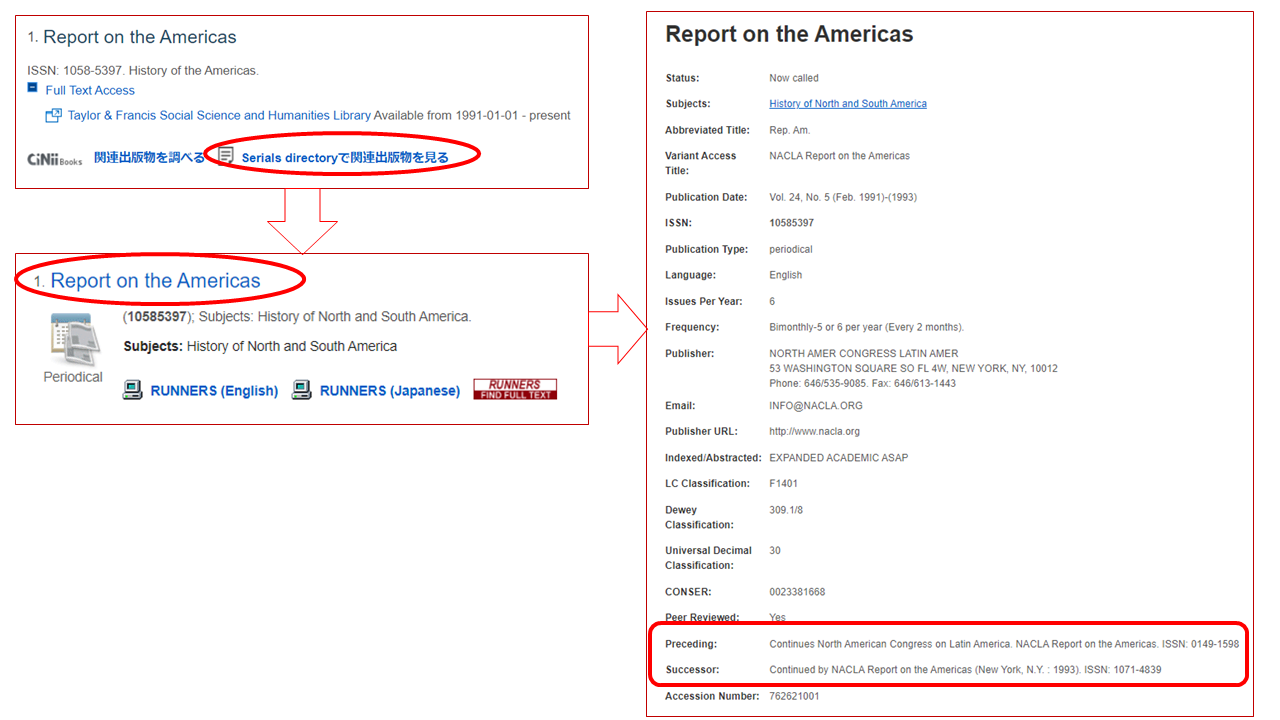 To use the Serials directory, click the Serials directory icon as shown on the right. When the Serials directory screen appears, click on the journal title. Then, the bibliography of that journal is displayed as shown in the right half of the figure on the right. "Preceding" is the pre-continuation journal, and "Successor" is the post-continuation journal. If it says "Continued by", it means that the title has been changed and continues. If it says "Merged into", it means that it has been absorbed by the journal that follows it and continues.
To use the Serials directory, click the Serials directory icon as shown on the right. When the Serials directory screen appears, click on the journal title. Then, the bibliography of that journal is displayed as shown in the right half of the figure on the right. "Preceding" is the pre-continuation journal, and "Successor" is the post-continuation journal. If it says "Continued by", it means that the title has been changed and continues. If it says "Merged into", it means that it has been absorbed by the journal that follows it and continues.
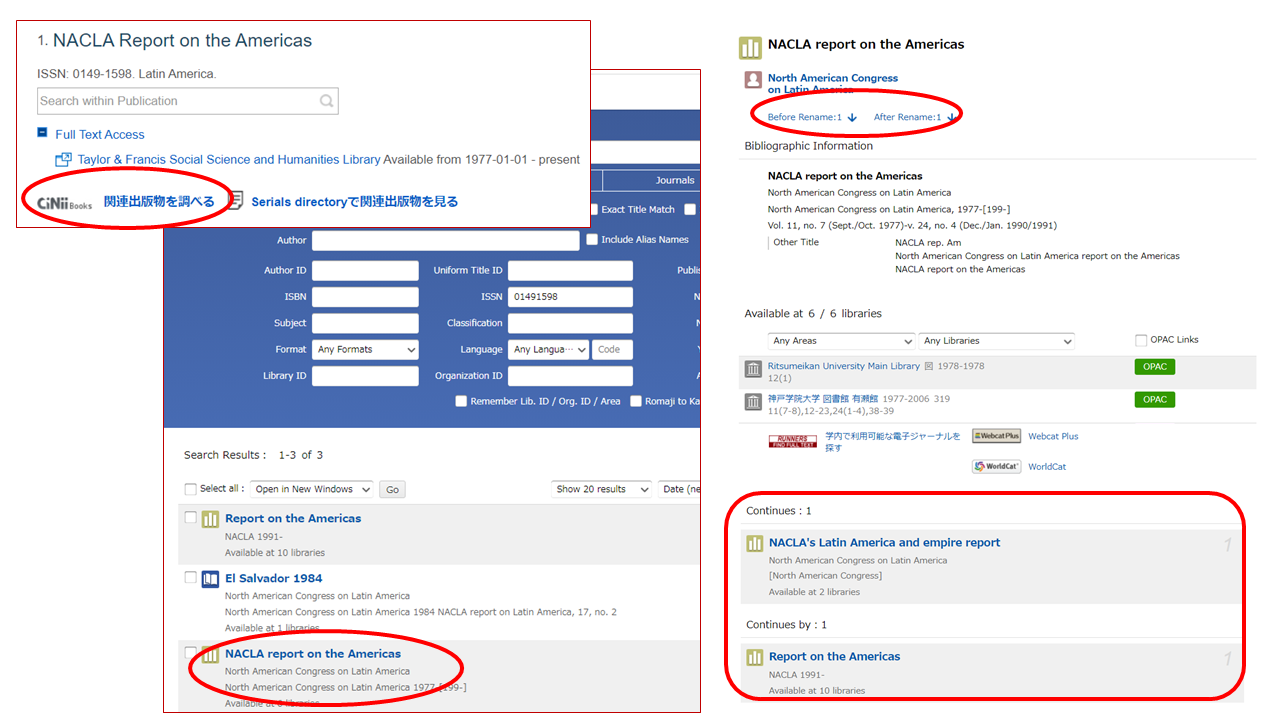 To use CiNii Books, click the CiNii Books icon as shown on the right. Since there is no one-to-one correspondence between the publications searched by the "e-publication search" and the publications registered in "CiNii Books", multiple publications may be displayed as shown in the figure on the right. Click on the publication's name you want to see, the the screen will be displaied that allows you to see the bibliographic information, holding information, and information of related publications.
To use CiNii Books, click the CiNii Books icon as shown on the right. Since there is no one-to-one correspondence between the publications searched by the "e-publication search" and the publications registered in "CiNii Books", multiple publications may be displayed as shown in the figure on the right. Click on the publication's name you want to see, the the screen will be displaied that allows you to see the bibliographic information, holding information, and information of related publications.
論文・記事検索について / About the Article Search
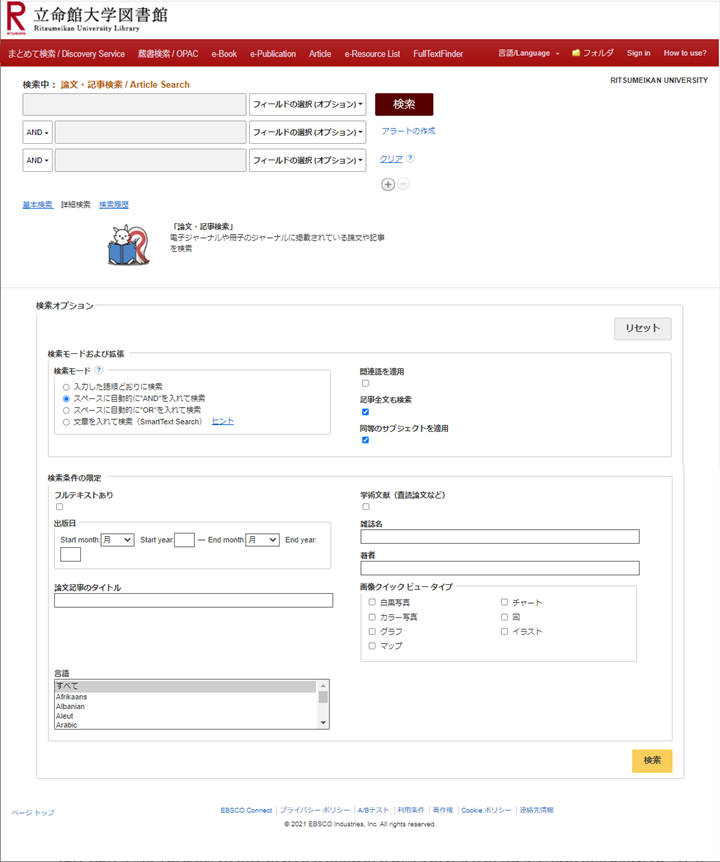 「論文・記事検索」は、「まとめて検索」の検索対象を、ジャーナルなどの雑誌に掲載されている記事や論文だけに絞り込んだ検索です。検索オプションや詳細検索画面の使い方、関連語の適用や複数のキーワードによる検索式の入力方法などは、「まとめて検索」と同じです。画面上部の赤帯にある「言語/Laguage」をクリックすると、操作言語を切り替えできます。
「論文・記事検索」は、「まとめて検索」の検索対象を、ジャーナルなどの雑誌に掲載されている記事や論文だけに絞り込んだ検索です。検索オプションや詳細検索画面の使い方、関連語の適用や複数のキーワードによる検索式の入力方法などは、「まとめて検索」と同じです。画面上部の赤帯にある「言語/Laguage」をクリックすると、操作言語を切り替えできます。
「論文・記事検索」では、本学が契約しているジャーナルや学協会のポータルサイト、オープンアクセスで閲覧可能な学術情報などを横断検索できます。探そうとしている論文や記事が掲載されているジャーナルや、それを発行する出版社や学協会がわかっている場合などは、それぞれの出版者や学協会のポータルサイトで検索できます。
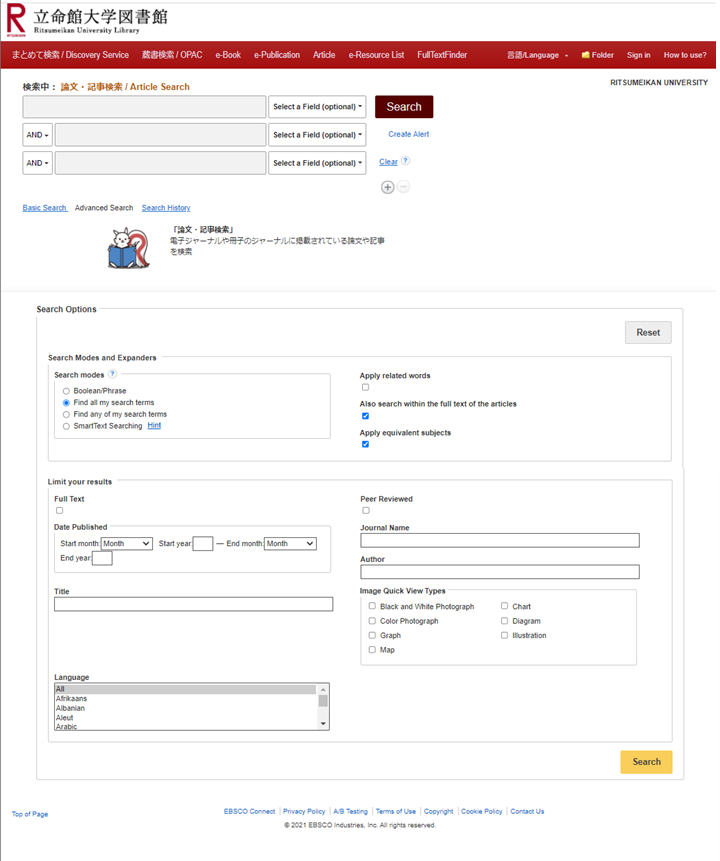 The "Article Search" is a search that narrows down the search target of the "RUNNERS Discovery Service" to only articles and academic papers published in magazines such as journals. How to use Search Option and Advanced Search, how to apply related words and how to enter search expressions using multiple keywords are the same as "RUNNERS Discovery Service". You can switch the operation language by clicking "言語 / Laguage" in the red belt at the top of the screen.
The "Article Search" is a search that narrows down the search target of the "RUNNERS Discovery Service" to only articles and academic papers published in magazines such as journals. How to use Search Option and Advanced Search, how to apply related words and how to enter search expressions using multiple keywords are the same as "RUNNERS Discovery Service". You can switch the operation language by clicking "言語 / Laguage" in the red belt at the top of the screen.
Using the "Article Search", you can perform a cross-search at once for journals contracted by our university, portal sites of academic societies, and academic information that can be viewed through open access. If you know the journal name which the article you are looking for is published, or if you know the publisher or academic society, you can also search the article in journal package site of each publisher or portal site of the academic society.
キーワードに関連する論文・記事を探す / Search for Articles Related to Keywords
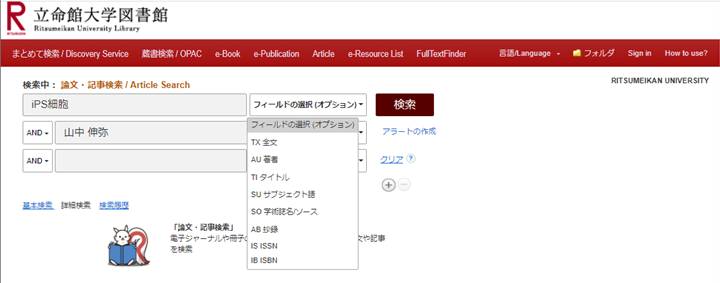 論文のタイトルや、それぞれの論文に対して入力されているサブジェクト(主題)語、抄録、または本文に特定のキーワードを含む論文を探すときは、右の図のように、検索窓にキーワードを入力し、検索対象となるフィールドを指定して検索します。検索対象となるフィールドをタイトルやサブジェクト語にした場合は、入力したキーワードに強く関係する文献を見つけることができますが、より多くの検索漏れが生じるかもしれません。本文を検索対象とすると、より多くの文献が検索結果画面に表示され、検索漏れは少なくなりますが、探そうとしている文献とは関係のない「検索ノイズ」が増えてしまいます。「関連語を適用」「同等のサブジェクトの適用」「フレーズによる検索」「複数のキーワードによる検索」などを活用し、検索漏れや検索ノイズの少ない方法で検索してください。
論文のタイトルや、それぞれの論文に対して入力されているサブジェクト(主題)語、抄録、または本文に特定のキーワードを含む論文を探すときは、右の図のように、検索窓にキーワードを入力し、検索対象となるフィールドを指定して検索します。検索対象となるフィールドをタイトルやサブジェクト語にした場合は、入力したキーワードに強く関係する文献を見つけることができますが、より多くの検索漏れが生じるかもしれません。本文を検索対象とすると、より多くの文献が検索結果画面に表示され、検索漏れは少なくなりますが、探そうとしている文献とは関係のない「検索ノイズ」が増えてしまいます。「関連語を適用」「同等のサブジェクトの適用」「フレーズによる検索」「複数のキーワードによる検索」などを活用し、検索漏れや検索ノイズの少ない方法で検索してください。
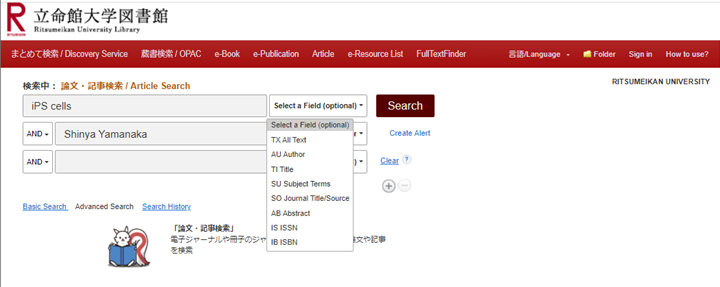 When searching for articles which contains a specific keyword in the "Title" of a treatise or the "Subject Term", "Abstract", or "All Text" entered for each article, enter a keyword in the textbox, and specify the field to be searched for, as shown in the figure on the right. If you set the search target field to "Title" or "Subject Term", you can find article that are strongly related to the keyword you entered, but you may miss more searches. If you search for "All Text", more articles will be displayed on the search result screen and search omissions will be reduced, but "search noise" that is not related to the document you are searching for will increase. Please read the explanations such as "Apply Related Words", "Apply Equivalent Subjects", "Including Phrases in a Search", and "Searching by Multiple Keywords", and search using a method that reduces search omissions and search noise.
When searching for articles which contains a specific keyword in the "Title" of a treatise or the "Subject Term", "Abstract", or "All Text" entered for each article, enter a keyword in the textbox, and specify the field to be searched for, as shown in the figure on the right. If you set the search target field to "Title" or "Subject Term", you can find article that are strongly related to the keyword you entered, but you may miss more searches. If you search for "All Text", more articles will be displayed on the search result screen and search omissions will be reduced, but "search noise" that is not related to the document you are searching for will increase. Please read the explanations such as "Apply Related Words", "Apply Equivalent Subjects", "Including Phrases in a Search", and "Searching by Multiple Keywords", and search using a method that reduces search omissions and search noise.
タイトルや著者名から論文・記事を探す / Search for Article by Title or Author Name
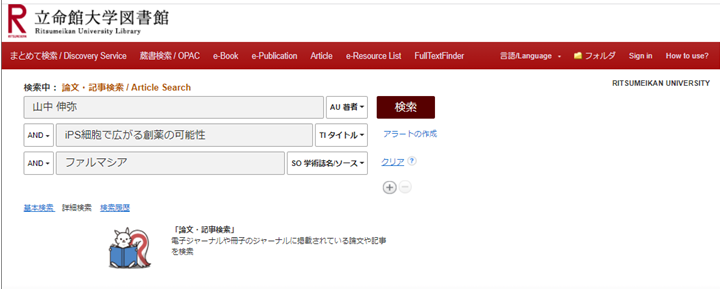 誰が著した何というタイトルの論文を探すかが明確な場合も、右の図の画面で検索できます。この図では、「山中 伸弥」が著した「iPS細胞で広がる創薬の可能性」という論文を「ファルマシア」というジャーナルから探しています。入力したキーワードと照合する対象のフィールドについては、著者、タイトル、学術誌名/ソース、ISSNなどが選べますので、これらの組み合わせで探し出したい論文・記事を特定して検索してください。
誰が著した何というタイトルの論文を探すかが明確な場合も、右の図の画面で検索できます。この図では、「山中 伸弥」が著した「iPS細胞で広がる創薬の可能性」という論文を「ファルマシア」というジャーナルから探しています。入力したキーワードと照合する対象のフィールドについては、著者、タイトル、学術誌名/ソース、ISSNなどが選べますので、これらの組み合わせで探し出したい論文・記事を特定して検索してください。
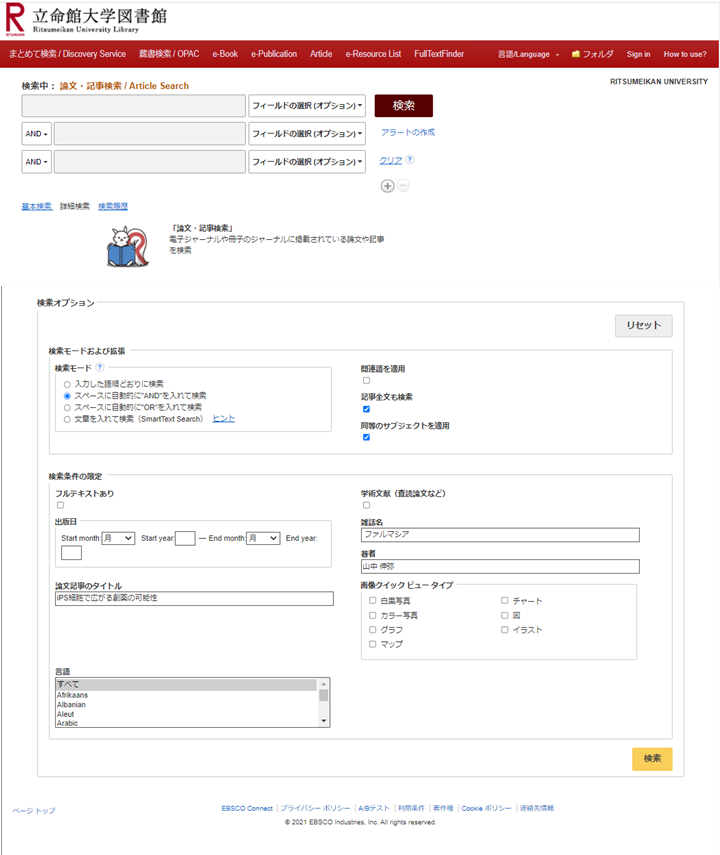 検索オプションでも、出版日、論文記事のタイトル、雑誌名、著者を指定して検索できます。
検索オプションでも、出版日、論文記事のタイトル、雑誌名、著者を指定して検索できます。
また、これらの情報によって論文・記事を完全に特定できる場合は、「FullTextFinder」で入手方法を調べることができます。
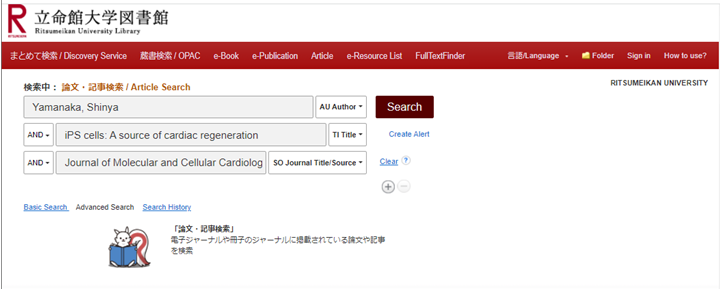 When you are looking for a article that happened to be presented as a reference for a document you read, you can search on the screen shown on the right. In this figure, you are looking for a article entitled "iPS cells: A source of cardiac regeneration" by the author "Yamanaka, Shinya" in the journal "Journal of Molecular and Cellular Cardiology". You can select the "Author", "Title", "Journal Title / Source", "ISSN", etc. for the field to be collated with the entered keyword, so specify the article you want to find by combining these and search.
When you are looking for a article that happened to be presented as a reference for a document you read, you can search on the screen shown on the right. In this figure, you are looking for a article entitled "iPS cells: A source of cardiac regeneration" by the author "Yamanaka, Shinya" in the journal "Journal of Molecular and Cellular Cardiology". You can select the "Author", "Title", "Journal Title / Source", "ISSN", etc. for the field to be collated with the entered keyword, so specify the article you want to find by combining these and search.
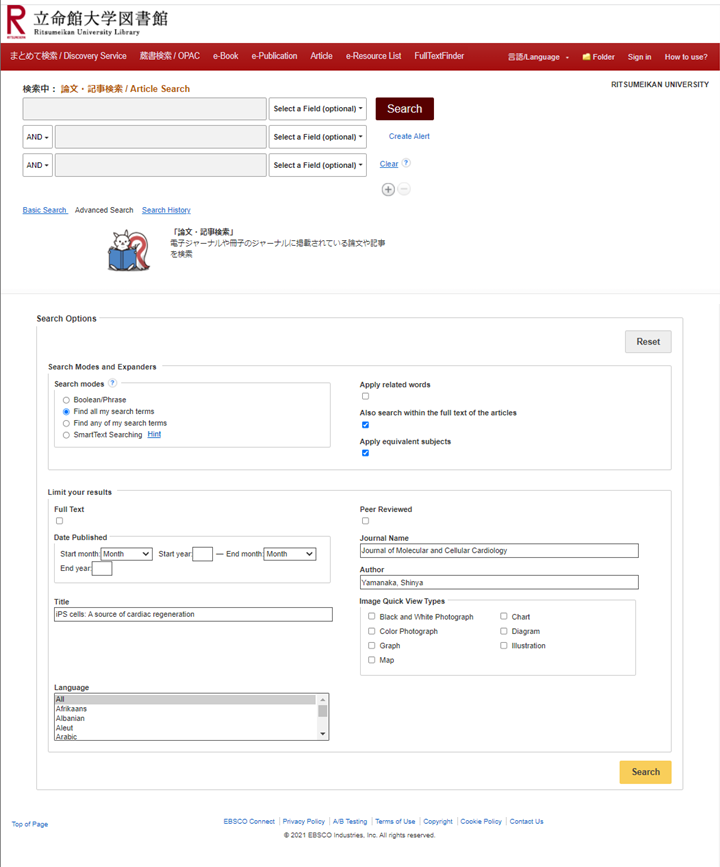 "Search Options" also allow you to specify the "Date Published", the "Title" of the article, the "Journal Name", and the "Author", and also specify those information here to search.
"Search Options" also allow you to specify the "Date Published", the "Title" of the article, the "Journal Name", and the "Author", and also specify those information here to search.
Also, if this information can completely identify the article, you can find out how to get it in the "FullTextFinder".
FullTextFinderについて / About the FullTextFinder
「FullTextFinder」は、特定された文献へのアクセス方法を調べるツールです。参考文献や引用文献として提示されている文献にアクセスするときなどに使います。論文を特定する方法としては、例えば以下のものがあります。
(1) 掲載されているジャーナル(雑誌)のタイトル(誌名)またはISSN、巻、号、開始ページを指定する。
(2) 掲載されているジャーナル(雑誌)のタイトル(誌名) 、巻、号、論文のタイトル、著者を指定する。
(3) DOI や PubMed IDを指定する。
参考文献、引用文献の記載方法に合わせて使ってください。
"Full Text Finder" is a tool to find out how to access the specified article or book. It is used when trying to access a document presented as a reference or citation. For example, the following methods can be used to identify a article.
(1) Specify the journal name or ISSN, volume, issue, and start page of the journal that is published.
(2) Specify the journal name, volume, issue, title and author of the article.
(3) Specify the DOI or PubMed ID.
Please use it according to the description method of references and citations.
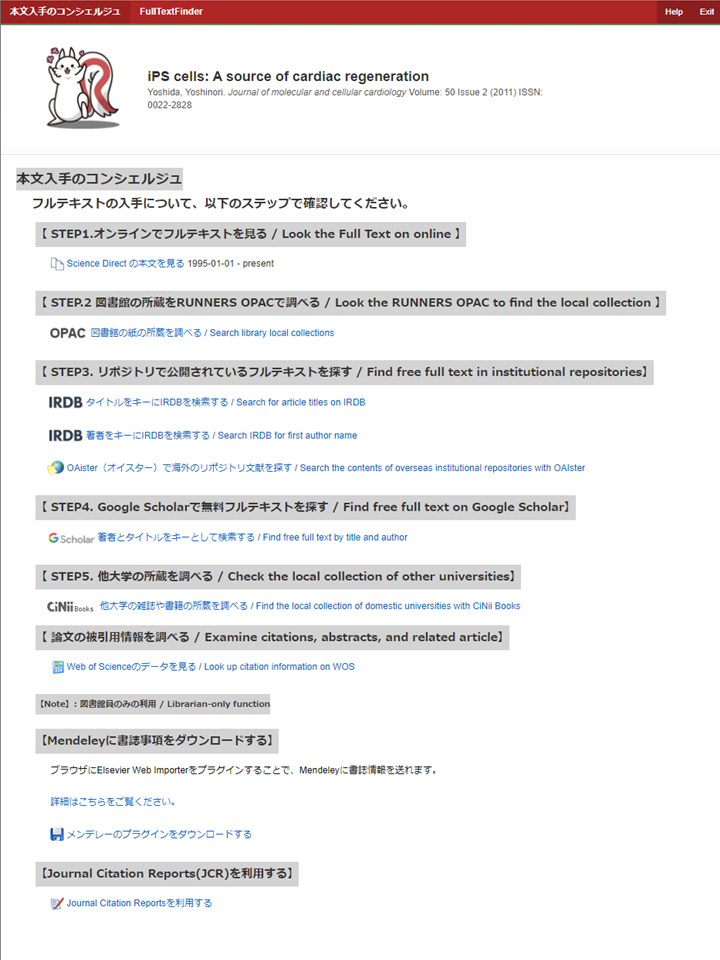 「FullTextFinder」の検索結果は右の図の画面で表示されます。すぐにアクセスできるフルテキストの電子リソースがある場合は、STEP1にリンクが表示されます。この画面の見方は、「リンク先・入手方法の見方について」をご覧ください。
「FullTextFinder」の検索結果は右の図の画面で表示されます。すぐにアクセスできるフルテキストの電子リソースがある場合は、STEP1にリンクが表示されます。この画面の見方は、「リンク先・入手方法の見方について」をご覧ください。
The search results for "FullTextFinder" are displayed on the sumple screen shown on the right. If the full-text e-resource is accessible, you can see a link in STEP1. For derails of how to read this screen, see "About 'How to Find the Full Text' ".
掲載ジャーナルのタイトル、巻号、ページから論文・記事を探す / Search for Articles by Journal Title, Volume, Issue, and Page
 画面上部の赤帯部で「FullTextFinder」をクリックすると右の図の画面が表示されますので、記事を特定する情報を入力してください。この図では「Journal of Molecular and Cellular Cardiology」というジャーナルの、50巻2号の327ページから332ページに掲載されている論文を検索しています。検索対象は、論文のタイトルと著者、ISSNと論文のタイトルといった組み合わせでも特定できます。
画面上部の赤帯部で「FullTextFinder」をクリックすると右の図の画面が表示されますので、記事を特定する情報を入力してください。この図では「Journal of Molecular and Cellular Cardiology」というジャーナルの、50巻2号の327ページから332ページに掲載されている論文を検索しています。検索対象は、論文のタイトルと著者、ISSNと論文のタイトルといった組み合わせでも特定できます。
Clicking "FullTextFinder" on the red belt at the top of the screen will bring up the screen shown on the right, and you can enter the information that identifies the article. This figure searches for articles published in the "Journal of Molecular and Cellular Cardiology", Vol. 50, No. 2, pp. 327-332. The search target can be specified by the title and author of the article, or by the combination of ISSN and the title of the article.
 「Citation Search」の検索結果は右の図の画面で表示されます。すぐにアクセスできるフルテキストの電子リソースがある場合は、STEP1にリンクが表示されます。この画面の見方は、「リンク先・入手方法の見方について」をご覧ください。
「Citation Search」の検索結果は右の図の画面で表示されます。すぐにアクセスできるフルテキストの電子リソースがある場合は、STEP1にリンクが表示されます。この画面の見方は、「リンク先・入手方法の見方について」をご覧ください。
The search results for "Citation Search" are displayed on the sumple screen shown on the right. If the full-text e-resource is accessible, you can see a link in STEP1. For derails of how to read this screen, see "About 'How to Find the Full Text' ".
DOI や PubMed ID から論文・記事を探す / Search for Articles by DOI or PubMed ID
 DOI とは、米国出版協会(American Association of Publishers)が中心となって開発した、インターネット上の電子資料を一意に識別する国際的なコードで、電子資料の恒久的な識別を可能とする永続的識別子の一つです(※)。電子ジャーナルに掲載された論文や、電子書籍などの文献ごとに付与されるため、これを正しく入力すれば探している文献を特定することができます。PubMed とは、米国国立医学図書館(NLM)が無料で提供する医学文献データベースで、収録されると PubMed ID が付与されます。
DOI とは、米国出版協会(American Association of Publishers)が中心となって開発した、インターネット上の電子資料を一意に識別する国際的なコードで、電子資料の恒久的な識別を可能とする永続的識別子の一つです(※)。電子ジャーナルに掲載された論文や、電子書籍などの文献ごとに付与されるため、これを正しく入力すれば探している文献を特定することができます。PubMed とは、米国国立医学図書館(NLM)が無料で提供する医学文献データベースで、収録されると PubMed ID が付与されます。
※"DOI", 図書館情報学用語辞典 第5版, JapanKnowledge, https://japanknowledge.com , (参照 2021-10-07)
DOI や PubMed ID で特定された論文・記事を検索する場合は「FullTextFinder」を使ってください。画面上部の赤帯部で「FullTextFinder」をクリックすると右の図の画面が表われますので、所定の欄に DOI または PubMed ID を入力してください。この図では「10.1016/j.yjmcc.2010.10.026」という DOI が付与された文献を検索しています。
DOI is an international code developed by the American Association of Publishers that uniquely identifies electronic materials on the Internet, and is a permanent code that enables permanent identification of electronic materials. It is given for each article published in an e-journal or for each document such as an e-book, so if you enter this correctly, you can identify the document you are looking for. PubMed is a database of medical literature provided free of charge by the National Library of Medicine (NLM), and when tha article is recorded, it is given a PubMed ID.
Use "FullTextFinder" to search for articles identified by DOI or PubMed ID. Click "FullTextFinder" in the red belt at the top of the screen to display the screen shown on the right. Enter your DOI or PubMed ID in the space provided. In this figure, we are searching for documents with the DOI "10.1016 / j.yjmcc. 2010.10.026".
 「FullTextFinder」の検索結果は右の図の画面で表示されます。すぐにアクセスできるフルテキストの電子リソースがある場合は、STEP1にリンクが表示されます。この画面の見方は、「リンク先・入手方法の見方について」をご覧ください。
「FullTextFinder」の検索結果は右の図の画面で表示されます。すぐにアクセスできるフルテキストの電子リソースがある場合は、STEP1にリンクが表示されます。この画面の見方は、「リンク先・入手方法の見方について」をご覧ください。
The search results for "FullTextFinder" are displayed on the sumple screen shown on the right. If the full-text e-resource is accessible, you can see a link in STEP1. For derails of how to read this screen, see "About 'How to Find the Full Text' ".
検索結果画面について / About the Search Results
 検索結果は右の図のように表示されます。表示方法は「ページオプション」で変更できますが、ここでは標準的な表示方法(結果形式:標準、画像クイックビュー:オン、ページ レイアウト:フィルター、メインおよびセカンダリー コンテンツ)をもとに解説します。
検索結果は右の図のように表示されます。表示方法は「ページオプション」で変更できますが、ここでは標準的な表示方法(結果形式:標準、画像クイックビュー:オン、ページ レイアウト:フィルター、メインおよびセカンダリー コンテンツ)をもとに解説します。
検索結果画面の左側に表示される様々な絞り込み条件を「ファセット」と呼びます。ファセットを使うと、例えばフルテキストのあるものだけ、出版時期、出版物タイプ、出版物の名称、出版社、言語、登録されているサブジェクト(主題)などにより検索結果をさらに絞り込むことができます。
検索結果画面の中央部のいちばん上に、グレーの枠で囲まれたエリアが表示されることがあります。これを「プラカードエリア」と呼び、事典や辞書に記載されている入力されたキーワードの意味や、入力されたキーワードと一致する電子ジャーナルのページへのリンクなどが表示されます。プラカードリアの下から、検索された文献が表示されます。
検索結果画面の右側には、朝日新聞の記事データベースや、AP通信などのニュース記事データベース「Newswires」から検索された、入力されたキーワードに関連する新聞記事が表示されます。
このシステムで使われているシソーラスに入力されたキーワードの同義語や関連語がある場合、検索結果画面右側の、新聞記事の下に表示されます。
 The search results are displayed as shown in the figure on the right. The display style can be changed in "Page Options", but here we will explain based on the standard display style (Result Format: Standard, Image QuickView: On, Page Layout: Filters, Main and Secondary Content).
The search results are displayed as shown in the figure on the right. The display style can be changed in "Page Options", but here we will explain based on the standard display style (Result Format: Standard, Image QuickView: On, Page Layout: Filters, Main and Secondary Content).
The various refinement criteria that appear on the left side of the search results screen are called "facets. Facets allow you to further refine your search results. For example, you can narrow down your search by full-text only, publication date, publication type, publication name, publisher, language, or registered subject (subject).
An area surrounded by a gray frame may be displayed at the top of the center of the search result screen. This is called the "placard area". Here you can see the meaning of the entered keywords in the encyclopedia or dictionary, and links to e-journal pages that match the entered keywords. The searched documents are displayed from the bottom of the placard rear.
On the right side of the search results screen, you will see newspaper articles related to the keyword you entered, retrieved from the Asahi Shimbun article database and Newswires, a database of news articles from the Associated Press and other sources.
If there are synonyms or related words of the keyword entered in the thesaurus used in this system, they will be displayed on the right side of the search result screen, below the newspaper article.
表示される順番 / Order of Display
「まとめて検索」の検索結果画面の表示順は、関連度順、日付の新しい順、日付の古い順を選択できます。デフォルトは関連度順です。関連度順では、検索画面に入力されたキーワードに対する関連性の高いものから順に表示されます。具体的には、
1. 主題件名(サブジェクト)にヒットするもの
2. タイトルにヒットするもの
3. 著者によるキーワードにヒットするもの
4. 抄録内にヒットするもの
5. 全文内にヒットするもの
の順で、より関連性が高いものと判断されます。
また、完全一致するものを部分一致するものよりも関連度が高いと評価したり、キーワードの密集度によって関連度を評価する機能もあります。さらに、より新しく、より文章の長いものを優先する、査読論文をより価値のあるものとするといった判断の上で、表示される順番が決められています。
You can select Relevance, Date Newest, or Date Oldest as the display order of the Result List of "RUNNERS Discovery Service". The default is Relrvance. In Relrvance Order, the contents that are most relevant to the keyword entered on the search screen are displayed in order. In specifically,
1. What hits the subject
2. What hits the title
3. What hits the keyword by the author
4. What hits in the abstract
5. What hits in the full text
In these order, they are judged to be more relevant.
There is also the ability to rate exact matches as more relevant than partial matches, and to rate relevance based on keyword density. In addition, the order in which the articles are displayed is determined by prioritizing newer and longer articles, and by assigning more value to peer-reviewed articles.
さらなる絞り込み / Further Narrowing Down
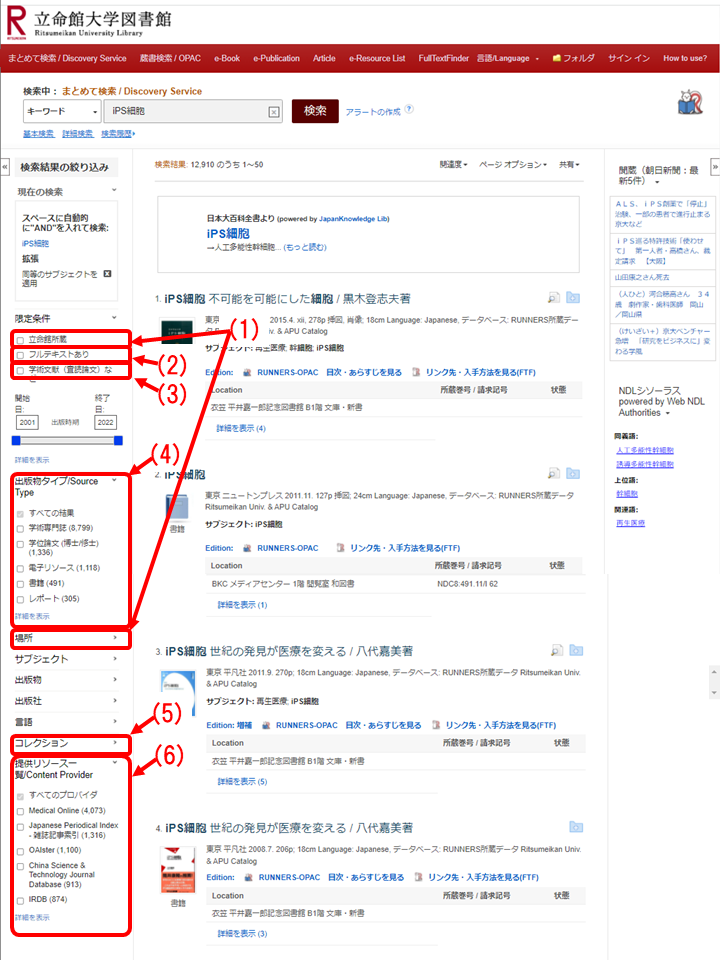 検索結果画面の左側に表示される「ファセット」を使うと、検索結果をさらに絞り込むことができます。
検索結果画面の左側に表示される「ファセット」を使うと、検索結果をさらに絞り込むことができます。
(1) 「蔵書検索(RUNNERS OPAC)」にチェックを入れると、本学の図書館に所蔵されている文献だけに絞り込まれます。この場合、本学に所蔵されている図書などの印刷物は表示されますが、電子書籍やジャーナルに掲載された論文・記事は表示されません。「場所」を選択することで、配架場所を絞り込むこともできます。
(2) 「フルテキストあり」にチェックを入れると、電子版のフルテキストにアクセスできるものだけに絞り込めます。
(3) 「学術文献(査読論文)など」にチェックを入れると、書籍やビジネス誌の記事などが取り除かれ、ジャーナルに掲載された学術論文などの学術文献に絞り込めます。
(4) 「出版物タイプ」には、「学術専門誌」(学術ジャーナル)に掲載された論文、博士論文や修士論文などの「学術論文」、「電子書籍」、学協会などが開催するシンポジウムなどの学術的会議の発表原稿や記録などの「会議用書類」、「ニュース」、「ビデオ」などがあります。
(5) 「コレクション」を選ぶことで、それぞれの文献が置かれているコレクションによる絞り込みができます。
(6) 「提供リソース」は、その文献がどのデータベースを通じて提供されているかによって絞り込むときに使います。
 You can further narrow down your search results by using the "facets" displayed on the left side of the search results screen.
You can further narrow down your search results by using the "facets" displayed on the left side of the search results screen.
(1) If you check "Catalog Only", you will be narrowed down to only the documents held in the library of our university. In this case, printed matter such as books held by the university will be displayed, but articles and articles published in e-books and journals will not be displayed. You can also narrow down the placement location by selecting "Location".
(2) If you check "Full Text", you can narrow down to only those that can access the electronic version of full text immediately.
(3) If you check "Peer Reviewed", books and articles in business journals will be removed, and you will be able to narrow down to academic papers published in journals after being peer-reviewed by experts.
(4) "Source Type" includes academic papers published in "Academic Journals", "Dissertations / Theses" such as doctoral dissertations and master's theses, "e-books", "Conference Materials" such as presentation manuscripts and records of academic conferences such as symposiums held by academic societies, etc. "News", "Videos" And so on.
(5) By selecting "Collection", you can narrow down by the collection in which each document is placed.
(6) "Content Provider" is used to narrow down the documents by which database it is provided through.
すぐに利用できる電子リソースがある場合 / Cases with Available e-Resources
 検索された文献のフルテキストが利用できる場合、右図のように、「全文へのリンク」、「PDF全文」、「Online Access」または利用できるリソースの名称などが表示されます。これらをクリックすると、フルテキストのPDFが開く、フルテキストへのリンクを含む書誌情報画面が開くなど、直接的または間接的にフルテキストにアクセスできます。
検索された文献のフルテキストが利用できる場合、右図のように、「全文へのリンク」、「PDF全文」、「Online Access」または利用できるリソースの名称などが表示されます。これらをクリックすると、フルテキストのPDFが開く、フルテキストへのリンクを含む書誌情報画面が開くなど、直接的または間接的にフルテキストにアクセスできます。
「全文へのリンク」はDOIを利用したリンクで、他の方法(例えばOpenURLなど)より高い精度でリンクを提供できます。主に主要出版社の電子ジャーナルが対象です。「PDFへのリンク」はEBSCO社仕様のリンクで、DOIがなくても高い精度でリンクが提供されます。EBSCOhost収録のフルテキストやオープンリソースであるDOAJの一部などに対応しています。電子書籍本文へのリンクは「Online Access」と表示されます。
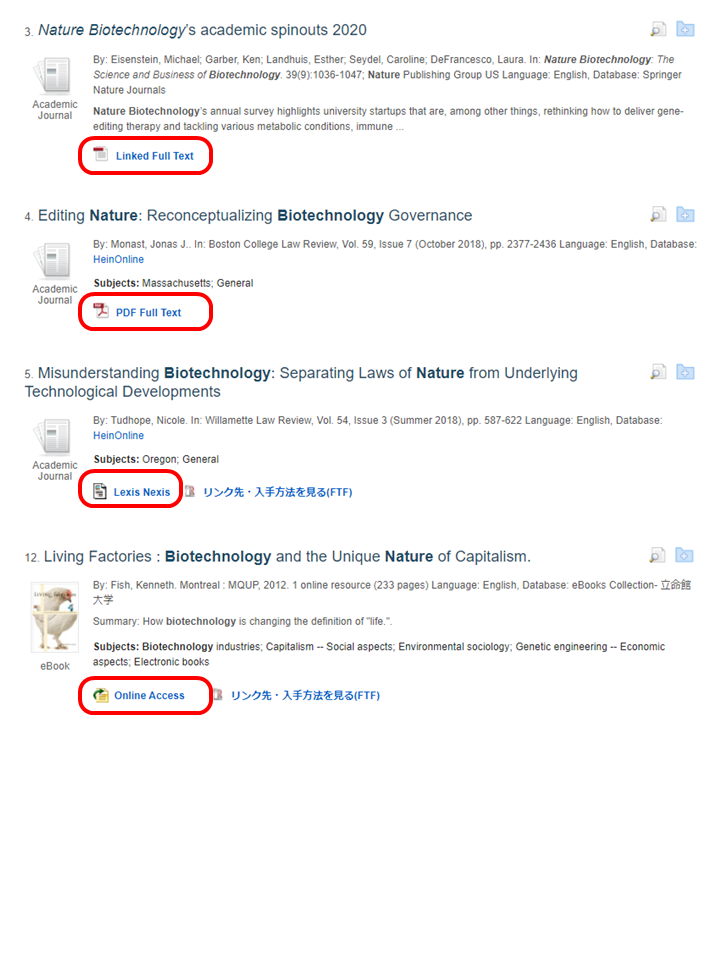 If the full text of the searched document is available, "Linked Full Text", "PDF Full Text", "Online Access" or the name of the available resource will be displayed as shown on the right. Clicking on these will open a full-text PDF, a bibliographic information screen with links to the full text, and so on, giving you access to the full text.
If the full text of the searched document is available, "Linked Full Text", "PDF Full Text", "Online Access" or the name of the available resource will be displayed as shown on the right. Clicking on these will open a full-text PDF, a bibliographic information screen with links to the full text, and so on, giving you access to the full text.
The "Link to Full Text" is a DOI-based link, which provides a more accurate link than other methods (e.g. OpenURL). It is mainly for e-journals from major publishers. Link to PDF" is a link based on EBSCO's specification, which provides links with high accuracy even without DOI, and supports EBSCOhost full text and some DOAJ open resources. The link to the full text of the e-book will be displayed as "Online Access".
本学図書館に蔵書がある場合 / Cases the book is in our library
 検索された図書が本学図書館に所蔵されている場合、右図のように所在(Location)、所蔵番号/請求記号、状態が表示されます。検索結果画面に少しでも多くの文献を表示させるため、所蔵に関する情報は1行だけ表示するようになっていますが、「詳細を表示」をクリックすればすべての所蔵情報が表示されます。
検索された図書が本学図書館に所蔵されている場合、右図のように所在(Location)、所蔵番号/請求記号、状態が表示されます。検索結果画面に少しでも多くの文献を表示させるため、所蔵に関する情報は1行だけ表示するようになっていますが、「詳細を表示」をクリックすればすべての所蔵情報が表示されます。
「蔵書検索(RUNNERS OPAC)」をクリックすると、蔵書検索システムの詳細表示画面が表示され、書誌情報や所在情報を確認できます。また多くの場合、「目次・あらすじを見る」にマウスポインタ―を乗せることで、「openBD」に登録されている目次情報やあらすじがポップアップ画面で表示されます。「openBD」は、カーリル社と版元ドットコム社が運営する、書誌情報・書影をだれでも自由に使えるようにするためのプロジェクトです。蔵書検索(RUNNERS OPAC)の詳細表示画面に表示される目次情報やあらすじは、日外アソシエーツ社の「BOOKPLUS」から取得しているため、内容が異なることがありますが、どちらも正しい情報です。
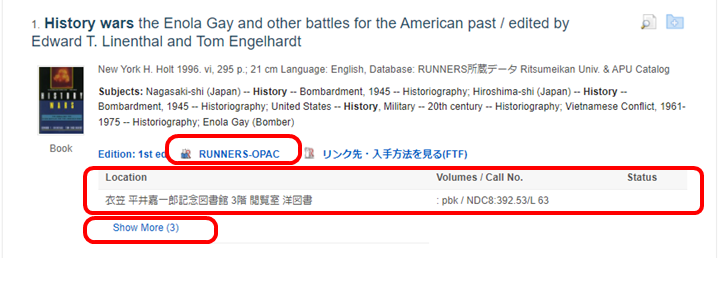 If the searched book is in our library collection, the Location, Volumes / Call No., and Status are displayed as shown on the right. In order to display as many documents as possible on the search result screen, only one line of information about the collection is displayed, but if you click "Show More", all the collection information will be displayed.
If the searched book is in our library collection, the Location, Volumes / Call No., and Status are displayed as shown on the right. In order to display as many documents as possible on the search result screen, only one line of information about the collection is displayed, but if you click "Show More", all the collection information will be displayed.
When you click "RUNNERS OPAC", the detailed display screen of the OPAC system is displayed, and you can check the bibliographic information and catalog information. To switch the display language to English, click the globe icon at the top right of the screen. In many cases, by hovering the mouse pointer over "目次・あらすじを見る (View table of contents / synopsis)", the table of contents information and synopsis registered in "openBD" will be displayed on a pop-up screen. "OpenBD" is a project run by CALIL Inc. and hanmoto.com to allow anyone to freely use bibliographic information and shadows. The table of contents information and synopsis displayed on the detailed display screen of the OPAC system are obtained from "BOOK PLUS" of Nichigai Associates, Inc., so the contents may differ, but both are correct information.
リンク先・入手方法を見る(FTF) / How to Find the Full Text
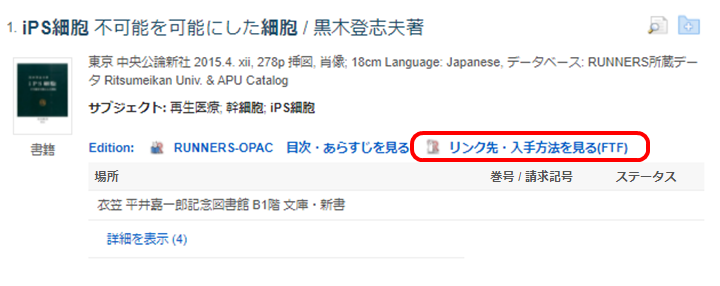 検索結果画面に表示されている文献ごとに「リンク先・入手方法を見る(FTF)」と表示されています。これをクリックすることで、その文献のフルテキストの入手方法を示す画面が表示されます。例えば、すぐに閲覧できるフルテキストの電子リソースがあればそのリソースへのリンク、本学の図書館に所蔵があればその所在場所、他大学に所蔵があれば取り寄せをリクエストする画面などを表示します。詳しくは、「リンク先・について」をご覧ください。
検索結果画面に表示されている文献ごとに「リンク先・入手方法を見る(FTF)」と表示されています。これをクリックすることで、その文献のフルテキストの入手方法を示す画面が表示されます。例えば、すぐに閲覧できるフルテキストの電子リソースがあればそのリソースへのリンク、本学の図書館に所蔵があればその所在場所、他大学に所蔵があれば取り寄せをリクエストする画面などを表示します。詳しくは、「リンク先・について」をご覧ください。
APUでは「リンク先・入手方法を見る(FTF)」の代わりにRUNNERS FIND FULL TEXTアイコン( )が表示されます。
)が表示されます。
新聞記事、アーカイブ製品に含まれている個々の文献、ワーキングペーパーなど、DOIが付与されておらず、かつ Open URL が生成できない文献は、フルテキストの入手方法を示す画面を提供している Full Text Finder へのリンクが生成できないため、「リンク先・入手方法を見る(FTF)」が表示されません。そのうちの多くの場合、フルテキストへ直接アクセスするリンクを表示します。
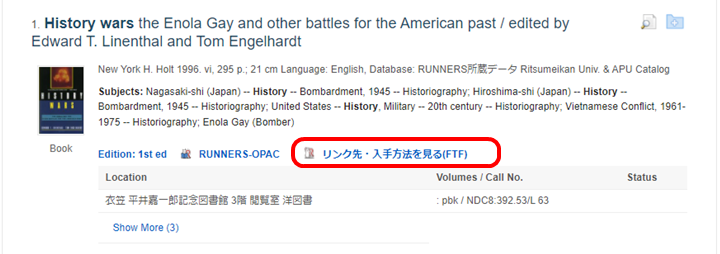 For each document displayed on the search result screen, "リンク先・入手方法を見る(FTF)"(How to Find the Full Text) is displayed. Clicking on this will bring up a screen showing how to obtain the full-text of the document. For example, if there is a full-text e-resource that can be viewed immediately, a link to that resource will be displayed, if there is a collection in our library, the location will be shown, or if there is a collection at another university, the screen to check the collection will be displayed and requesting screen to ordere it by ILL service will be displayed. For more information, see "About 'How to Find the Full Text' ".
For each document displayed on the search result screen, "リンク先・入手方法を見る(FTF)"(How to Find the Full Text) is displayed. Clicking on this will bring up a screen showing how to obtain the full-text of the document. For example, if there is a full-text e-resource that can be viewed immediately, a link to that resource will be displayed, if there is a collection in our library, the location will be shown, or if there is a collection at another university, the screen to check the collection will be displayed and requesting screen to ordere it by ILL service will be displayed. For more information, see "About 'How to Find the Full Text' ".
As for APU, the RUNNERS FIND FULL-TEXT icon( )is shown instead of the “リンク先・入手方法を見る(FTF)" icon.
)is shown instead of the “リンク先・入手方法を見る(FTF)" icon.
For newspaper articles, individual documents contained in archived products, working papers, and other documents that do not have a DOI and cannot generate an Open URL, "リンク先・入手方法を見る(FTF)" is not displayed, becouse the link to Text Finder which provid the screen showing how to obtain full text cannot be generated. In many cases, you'll see a link on your search results screen that gives you direct access to the full text.
電子ジャーナルタイトルの表示 / Display from the Title of e-journal
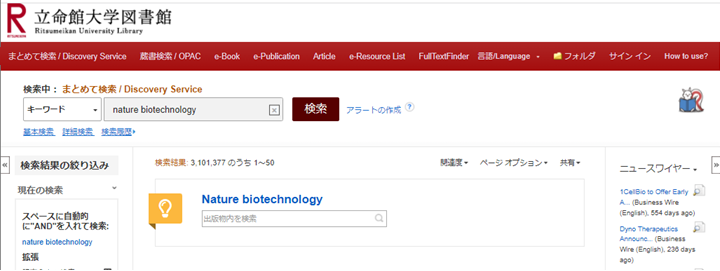 本学が購読している電子ジャーナルのタイトルをキーワードとして入力した場合は、その電子ジャーナルのウェブサイトへのリンクをプラカードエリアに表示します。プラカードエリアに検索窓が表示されている場合は、この検索窓を使って、そのジャーナルの中の論文・記事を検索できます。
本学が購読している電子ジャーナルのタイトルをキーワードとして入力した場合は、その電子ジャーナルのウェブサイトへのリンクをプラカードエリアに表示します。プラカードエリアに検索窓が表示されている場合は、この検索窓を使って、そのジャーナルの中の論文・記事を検索できます。
 If you enter the title of an e-journal subscribed to by the University as a keyword, a link to the website of that e-journal will be displayed in the placard area. If you see a search window in the placard area, you can use this search window to search for articles in that journal.
If you enter the title of an e-journal subscribed to by the University as a keyword, a link to the website of that e-journal will be displayed in the placard area. If you see a search window in the placard area, you can use this search window to search for articles in that journal.
事典・辞書からの表示 / Display from the Encyclopedia and Dictionary
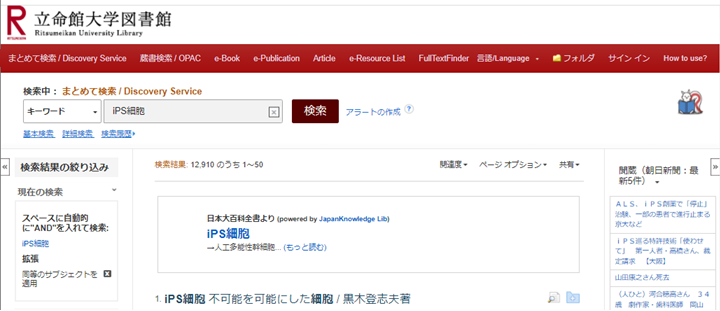 入力されたキーワードが、本学で契約している事典・辞書データベース「Japan knowledge」や、EBSCO社の提供する学術事典データベース「Research Starters」に掲載されている記事の項目名と一致した場合、検索結果上部のプラカードエリアにその項目名が表示されます。プラカードエリアのリンクをクリックすると、それらの事典・辞書の記事が表示されます。
入力されたキーワードが、本学で契約している事典・辞書データベース「Japan knowledge」や、EBSCO社の提供する学術事典データベース「Research Starters」に掲載されている記事の項目名と一致した場合、検索結果上部のプラカードエリアにその項目名が表示されます。プラカードエリアのリンクをクリックすると、それらの事典・辞書の記事が表示されます。
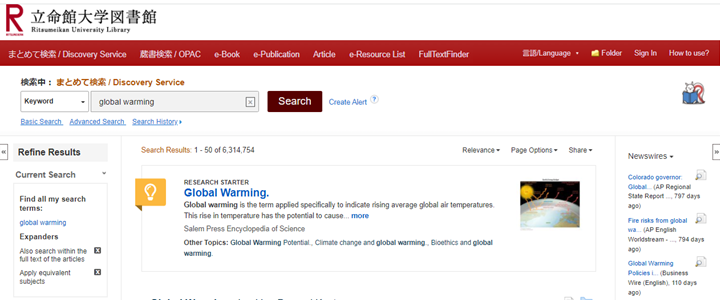 If the keyword you enter matches the name of an article in Japan knowledge, an encyclopedia and dictionary database that our University has a contract with, or in Research Starters, an academic encyclopedia database provided by EBSCO, the name of the article will be displayed in the placard area at the top of the search results. Clicking on a link in the placard area will display the article in the encyclopedia or dictionary.
If the keyword you enter matches the name of an article in Japan knowledge, an encyclopedia and dictionary database that our University has a contract with, or in Research Starters, an academic encyclopedia database provided by EBSCO, the name of the article will be displayed in the placard area at the top of the search results. Clicking on a link in the placard area will display the article in the encyclopedia or dictionary.
書誌情報画面について / About the Bibliographic Information Screen
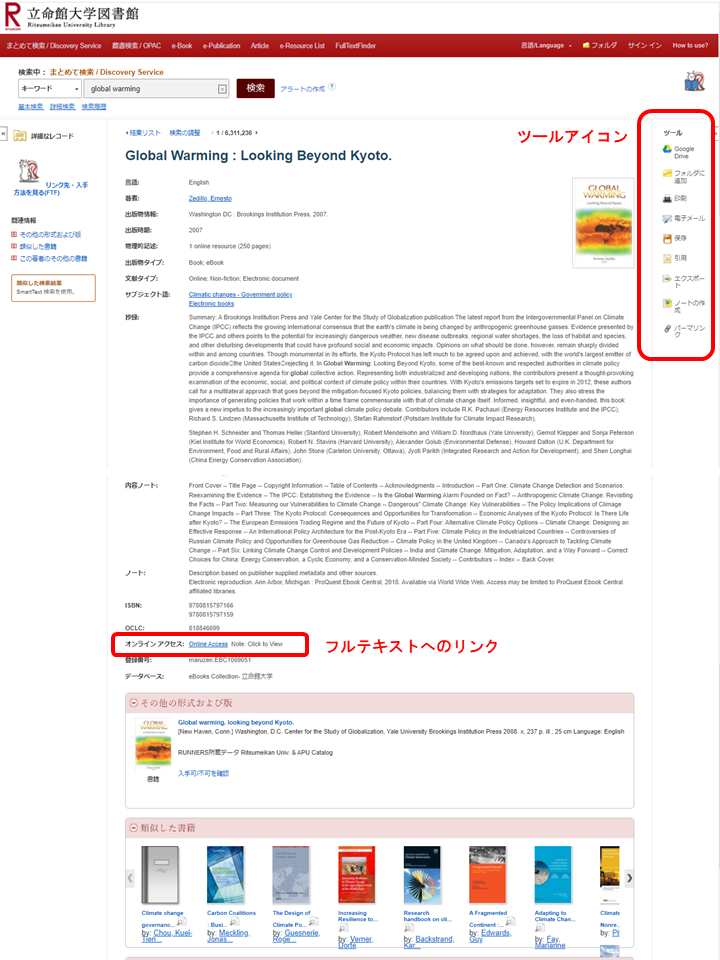 検索結果画面に表示されている書名・著者名のリンクをクリックすると、その文献の書誌情報が表示されます。全文へのアクセスができる場合は、そのためのリンクが表示されます。全文へのアクセスができない場合で、本学の図書館に所蔵がある場合は、所在や請求記号などが表示されます。画面右側には、書誌情報を保存、共有するためのさまざまなアイコンが表示されます。これらの機能は、作成しているレポートで参照や引用した文献の一覧を作成する、参考文献を共有する場合などに便利です。
検索結果画面に表示されている書名・著者名のリンクをクリックすると、その文献の書誌情報が表示されます。全文へのアクセスができる場合は、そのためのリンクが表示されます。全文へのアクセスができない場合で、本学の図書館に所蔵がある場合は、所在や請求記号などが表示されます。画面右側には、書誌情報を保存、共有するためのさまざまなアイコンが表示されます。これらの機能は、作成しているレポートで参照や引用した文献の一覧を作成する、参考文献を共有する場合などに便利です。
 Click the title and author link displayed on the search result screen to display the bibliographic information of the document. If it is abalable in full text by online, the link to access will be displayed. If it is not abalable in full text by online but our library has it in the collection, its location and call number will be displayed. On the right side of the screen, you will see various tool icons for saving and sharing bibliographic information. These features are useful for quickly creating a references list of referenced or cited in the report you are creating, or for sharing references documents when writing a treatise with other authers.
Click the title and author link displayed on the search result screen to display the bibliographic information of the document. If it is abalable in full text by online, the link to access will be displayed. If it is not abalable in full text by online but our library has it in the collection, its location and call number will be displayed. On the right side of the screen, you will see various tool icons for saving and sharing bibliographic information. These features are useful for quickly creating a references list of referenced or cited in the report you are creating, or for sharing references documents when writing a treatise with other authers.
Google Driveへの目録情報の保存 / Save Catalog Information to Google Drive
 書誌情報画面の右側にある「Google Drive」のアイコンをクリックすると、Googleアカウントにログインするための画面が表示されます。ご自身のアカウントでログインすると、書誌情報画面に「文書は Google Drive アカウントに保存されました。」のメッセージが表示されます。このメッセージは「OK」ボタンを押すと消えます。この状態でご自身のGoogle Driveを開くと「EBSCO」という名前のフォルダができ、文献ごとに目録情報が保管されます。「Googleドキュメントで開く」をクリックすると、表形式で目録情報を確認できます。
書誌情報画面の右側にある「Google Drive」のアイコンをクリックすると、Googleアカウントにログインするための画面が表示されます。ご自身のアカウントでログインすると、書誌情報画面に「文書は Google Drive アカウントに保存されました。」のメッセージが表示されます。このメッセージは「OK」ボタンを押すと消えます。この状態でご自身のGoogle Driveを開くと「EBSCO」という名前のフォルダができ、文献ごとに目録情報が保管されます。「Googleドキュメントで開く」をクリックすると、表形式で目録情報を確認できます。
Google Driveのフォルダを論文の共同執筆者と共有する、レポート課題ごとや論文の章ごとにサブファイルを用意して文献ごとのファイルをそれぞれのサブフォルダで管理するなど、さらに効率的に文献を管理できます。
Using this function, you can manage documents by linking with your own Google Drive. We will not explain how to get a Google account or create a Google Drive here, so please do your own research.
Click the "Google Drive" tool icon on the right side of the bibliographic information screen to display the screen for logging in to your Google account. Please log in to your account. Then, the message "Your document has been saved to your Google Drive account." Is displayed on the bibliographic information screen. This message disappears when you press the "OK" button. If you open your own Google Drive in this state, a folder named "EBSCO" will be created. If you look inside of it, the catalog information is stored for each document, so click it to open. You can check the catalog information in tabular format by clicking "Open with Google Docs".
You can use various methods such as sharing the Google Drive folder with the co-authors of the treatise, preparing subfiles for each report assignment or chapter of the treatise, and managing the files for each document in those subfolder, and you can also manage your document information more efficiently.
フォルダに追加 / Add to Folder
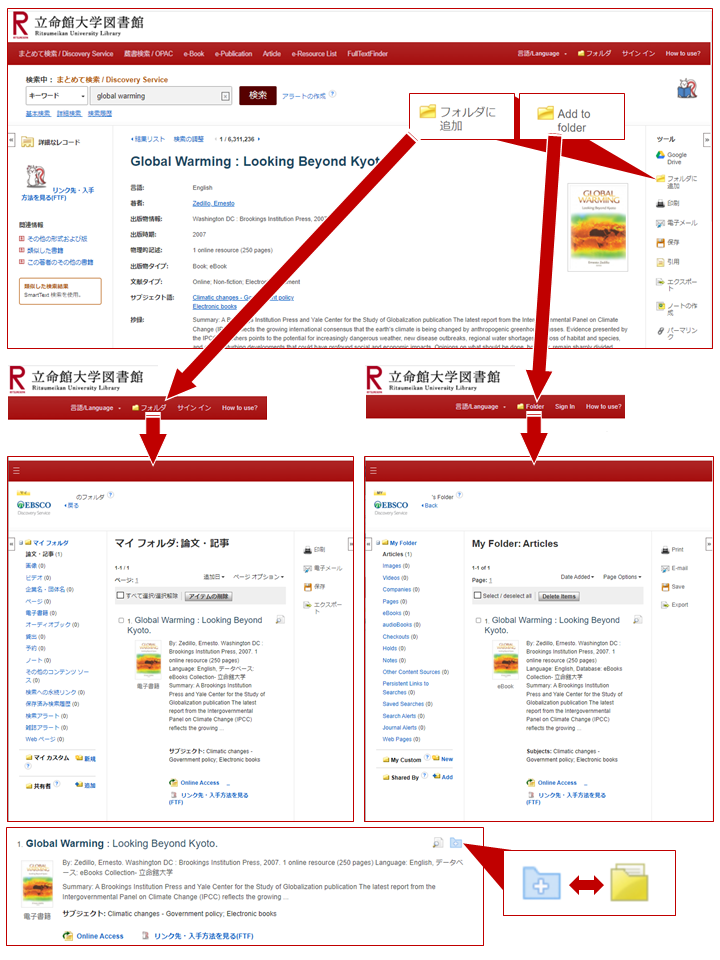 この機能は、MyEBSCOhostにサインインをした状態で利用することで、ブラウザを閉じたりセッションを終了しても、保存した情報が維持されます。
この機能は、MyEBSCOhostにサインインをした状態で利用することで、ブラウザを閉じたりセッションを終了しても、保存した情報が維持されます。
書誌情報画面の右側にある「フォルダに追加」のアイコンをクリックすると、書誌情報をEBSCOhostのフォルダに保存できます。既に保存されているものを削除する場合は、「フォルダから削除」アイコンが表示されます。
検索結果画面でも「フォルダに追加」ができます。タイトルの右側に表示されるグレーのフォルダのアイコン(「+」が表示されているもの)をクリックすると、EBSCOhostのフォルダに書誌情報を保存できます。保存されると「+」が消え、アイコンの色が黄色に変わります。もういちどクリックするとフォルダから削除され、アイコンの色がグレーに変わります。
This feature can be used while you are signed in to MyEBSCOhost, so that your saved information will be maintained even if you close your browser or terminate your session.
You can save the bibliographic information to the EBSCO host folder by clicking the "Add to folder" tool icon on the right side of the bibliographic information screen. If you want to delete the item that has already been saved, the "Remove from folder" tool icon will be displayed.
You can also "Add to folder" on the search result screen. You can save the bibliographic information to the EBSCO host folder by clicking the gray folder icon (the one with the "+") displayed to the right of the title. When saved, the "+" disappears and the icon color changes to yellow. Click it again to remove it from the folder and the icon will turn gray.
書誌情報の印刷 / Print Bibliographic Information
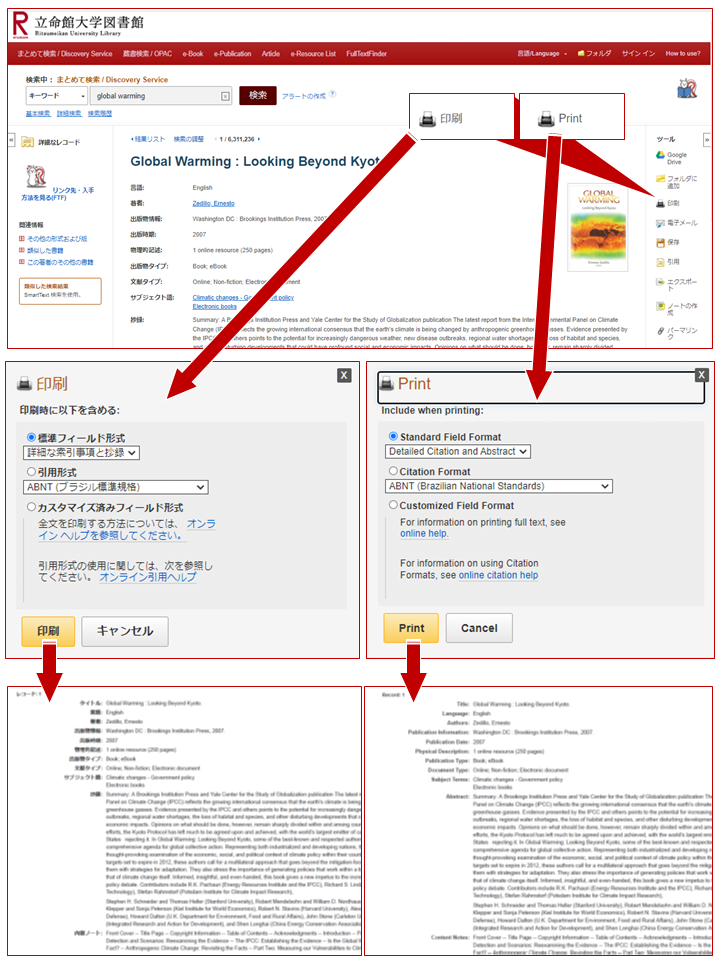 書誌情報画面の右側にある「印刷」アイコンをクリックすると、表示されている書誌情報を印刷できます。書誌情報のうちのどの情報をどのような書式で印刷するかについては、右に示した画面で選択できます。
書誌情報画面の右側にある「印刷」アイコンをクリックすると、表示されている書誌情報を印刷できます。書誌情報のうちのどの情報をどのような書式で印刷するかについては、右に示した画面で選択できます。
複数の文献の書誌情報をまとめて印刷する場合は、画面上部の赤帯の右にある「フォルダ」をクリックして保存された文献情報の一覧を表示させ、印刷したい文献の左側のチェックボックスにチェックを入れて「印刷」アイコンをクリックします。詳しくは、「フォルダに追加 / Add to Folder」や「フォルダ機能の活用 / Utilization of Folder Function」の説明をお読みください。
なお、印刷されるのは書誌情報のみで、本文がフルテキストで印刷されるわけではありません。本文が電子化されていて本学でアクセス可能な場合は「オンラインアクセス」欄に表示されているリンクから本文を表示させて、必要な部分を印刷してください。
You can print the displayed bibliographic information by clicking the "Print" tool icon on the right side of the bibliographic information screen. You can select which of the bibliographic information to print in what format on the screen shown on the right.
If you want to print the bibliographic information of multiple documents at once, save the bibliographic information of each document in the EBSCOhost folder with the "Add to folder" icon, and then click "Folder" which display to the right side of the red belt at the top of the screen. A list of saved bibliographic information will be displaied, check the check box on the left side of the bibliography you want to print, and click the "Print" tool icon displayed on the right side. For details, read the explanations of "Add to Folder" and "Utilization of Folder Function".
Note that only bibliographic information is printed, and the fulltext will be not printed in this operation. If the text is digitized and accessible on our university, please click the text displayed in the "Online Access" column and print out the necessary parts.
電子メールの送信 / Send e-Mail
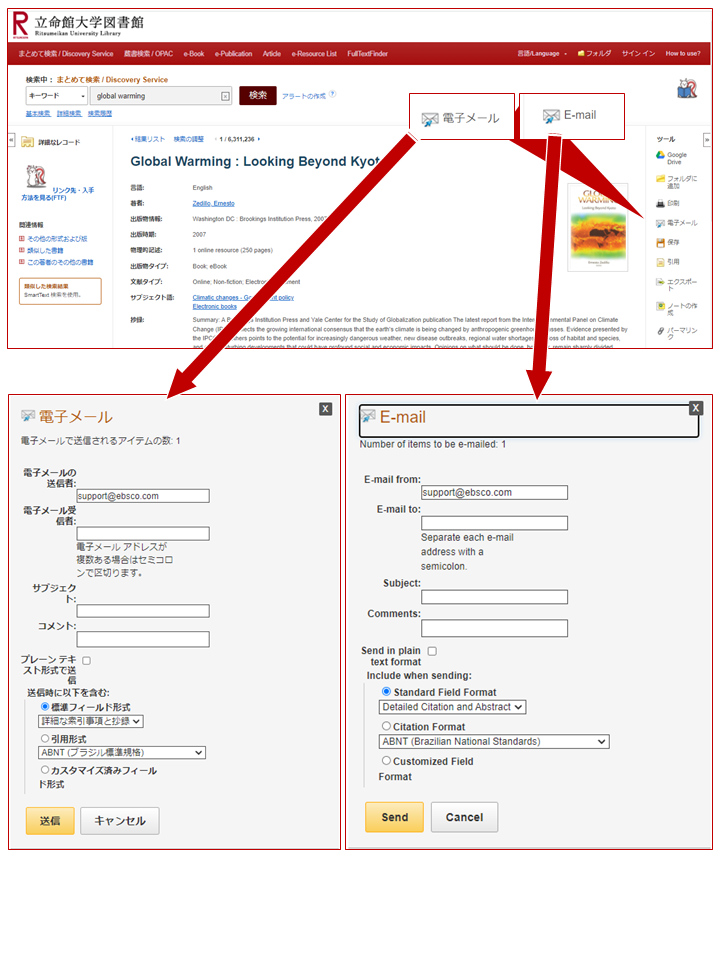 書誌情報画面の右側にある「電子メール」のツールアイコンをクリックすると、表示されている書誌情報を電子メールで送信できます。どの情報をどのような書式で、どのメールアドレスに送信するか等は、右に示した画面で選択できます。
書誌情報画面の右側にある「電子メール」のツールアイコンをクリックすると、表示されている書誌情報を電子メールで送信できます。どの情報をどのような書式で、どのメールアドレスに送信するか等は、右に示した画面で選択できます。
複数の文献の書誌情報をまとめてメール送信する場合は、画面上部の赤帯の右にある「フォルダ」をクリックして保存された文献情報の一覧を表示させ、印刷したい文献の左側のチェックボックスにチェックを入れて「電子メール」アイコンをクリックします。詳しくは、「フォルダに追加 / Add to Folder」や「フォルダ機能の活用 / Utilization of Folder Function」の説明をお読みください。
You can send the displayed bibliographic information by e-mail by clicking the "E-mail" tool icon on the right side of the bibliographic information screen. You can select which of the bibliographic information to send in what format and from which email address to which email address on the screen shown on the right.
If you want to send e-mail with the bibliographic information of multiple documents at once, save the bibliographic information of each document in the EBSCOhost folder with the "Add to folder" icon, and then click "Folder" which display to the right side of the red belt at the top of the screen. A list of saved bibliographic information will be displaied, check the check box on the left side of the bibliography you want to print, and click the "E-mail" tool icon displayed on the right side. For details, read the explanations of "Add to Folder" and "Utilization of Folder Function".
書誌情報画面の保存 / Saving the Bibliographic Information Screen
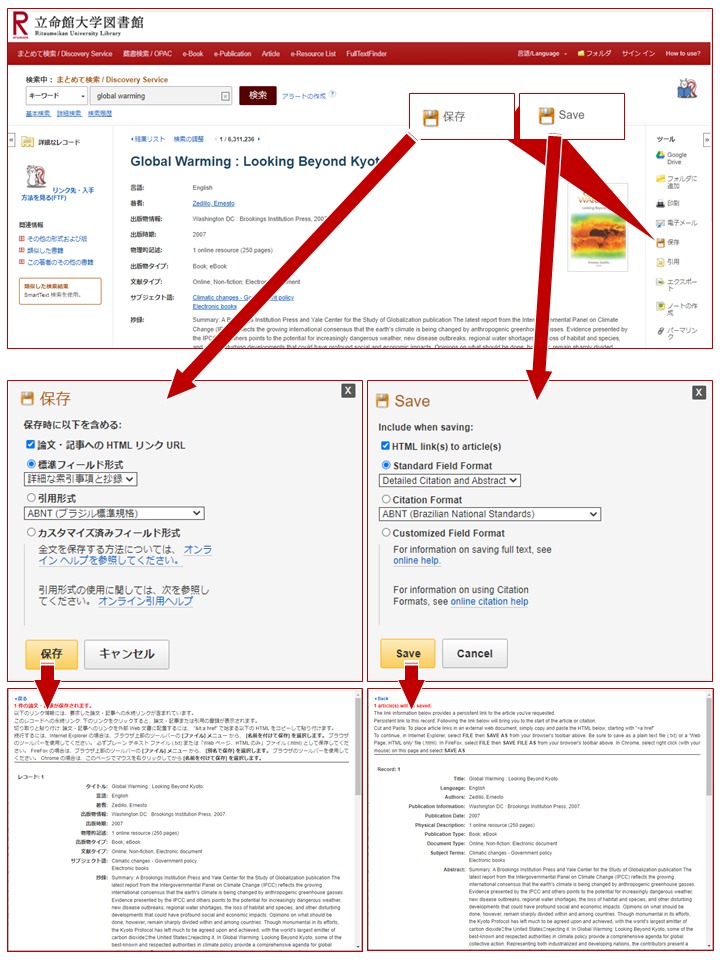 書誌情報画面の右側にある「保存」アイコンをクリックすると、表示されている画面のうちの書誌情報の部分のみを別の画面で表示し、ブラウザの機能を用いてこれを保存できます。右の図はGoogleChromeを利用した場合の例です。「保存」ツールアイコンをクリックして表示される画面の上で「Crtl」キーを押しながら「s」キーを押すと、保存先を指定するためのダイアログボックスが表示されます。
書誌情報画面の右側にある「保存」アイコンをクリックすると、表示されている画面のうちの書誌情報の部分のみを別の画面で表示し、ブラウザの機能を用いてこれを保存できます。右の図はGoogleChromeを利用した場合の例です。「保存」ツールアイコンをクリックして表示される画面の上で「Crtl」キーを押しながら「s」キーを押すと、保存先を指定するためのダイアログボックスが表示されます。
If you click the "Save" tool icon on the right side of the bibliographic information screen, only the bibliographic information part of the displayed screen will be displayed on another screen, and you can save it using the browser function. The figure on the right is an example of using Google Chrome. Click the "Save" tool icon to display the screen. Hold down the "Crtl" key and press the "s" key to display a dialog box for specifying the save destination.
引用書式での表示 / Display in Citation Format
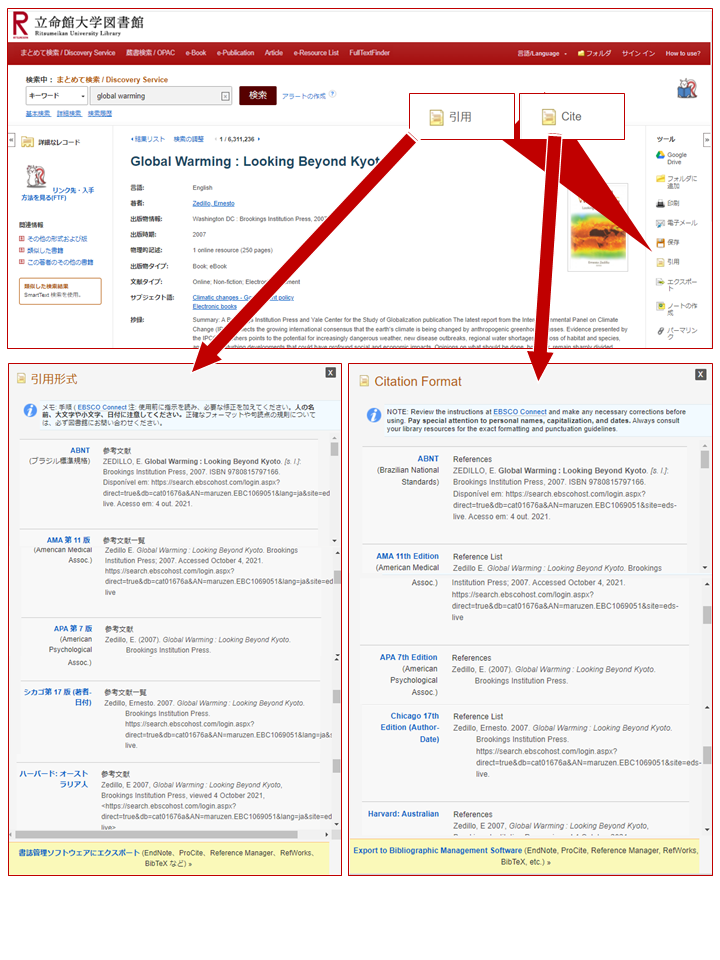 書誌情報画面の右側にある「引用」アイコンをクリックすると、さまざまな引用形式が表示されます。その中から、普段ご自身が使われている形式や、論文やレポートの執筆にあたって指定されている形式を選ぶことができます。
書誌情報画面の右側にある「引用」アイコンをクリックすると、さまざまな引用形式が表示されます。その中から、普段ご自身が使われている形式や、論文やレポートの執筆にあたって指定されている形式を選ぶことができます。
Click on the "Citation" tool icon on the right side of the bibliographic information screen to display a variety of citation formats. You can select the format that you usually use or that is specified for writing papers and reports.
他の文献管理ツールへのエクスポート / Export to Other Document Management Tool
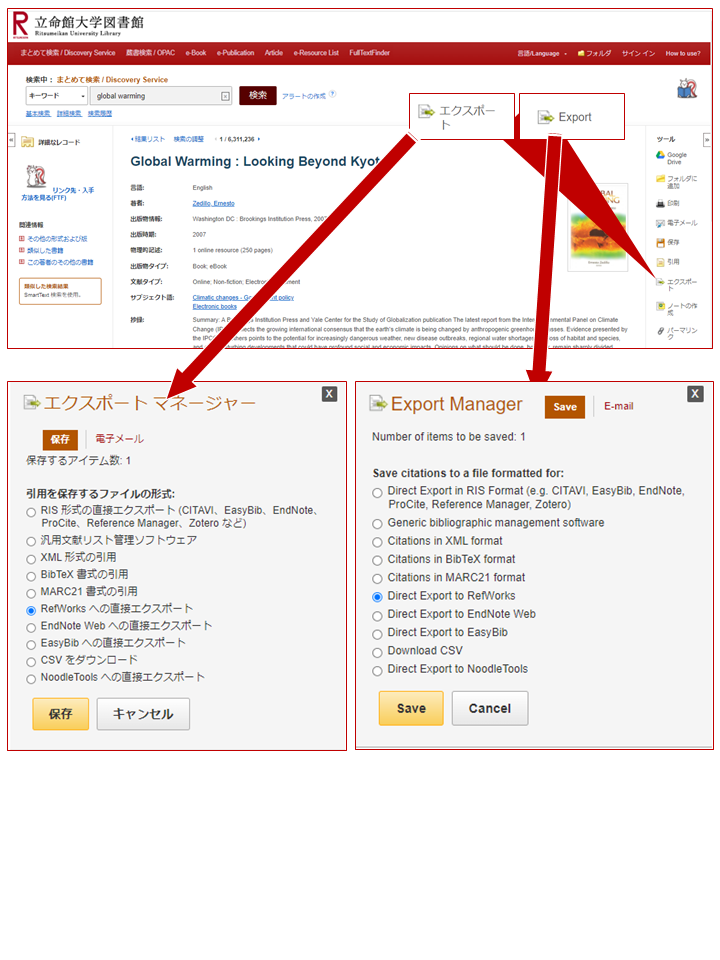 書誌情報画面の右側にある「エクスポート」アイコンをクリックすると、外部の文書管理ツールに書誌情報を保存できる形式のデータを作成できます。
書誌情報画面の右側にある「エクスポート」アイコンをクリックすると、外部の文書管理ツールに書誌情報を保存できる形式のデータを作成できます。
なお、Mendeleyに書誌情報を保存する方法は、「Mendeleyへの書誌情報インポートについて」をご覧ください。
Click the "Export" tool icon on the right side of the bibliographic information screen, you can create data in a format that allows you to save the bibliographic information in an external document management tool.
For information on how to store bibliographic information in Mendeley, see "About Importing Bibliographic Information into Mendeley".
ノートの作成 / Create Note
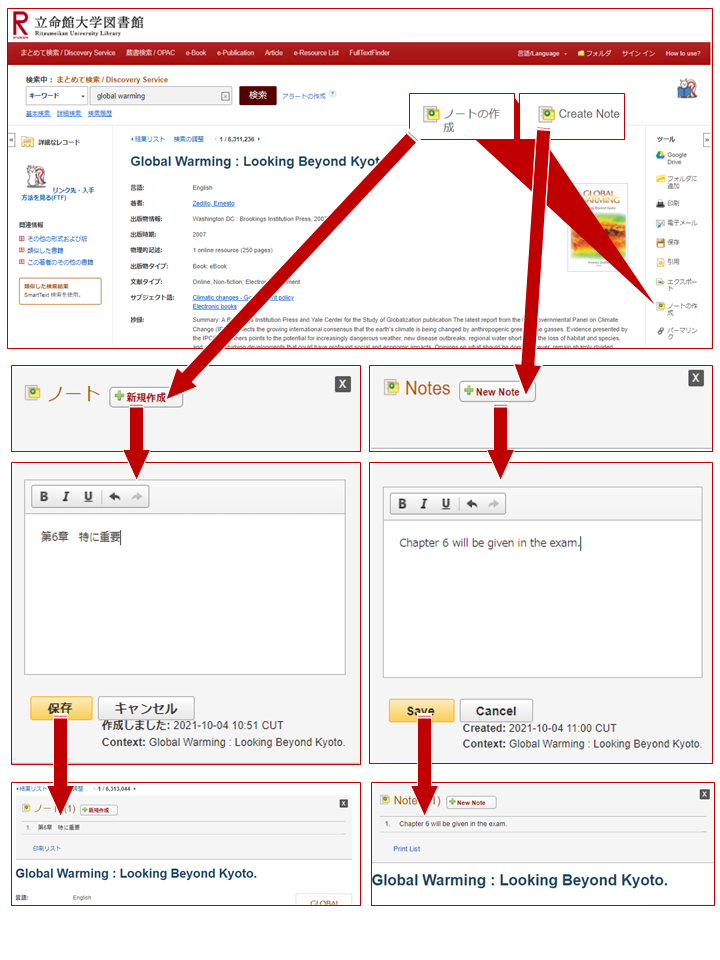 この機能は、MyEBSCOhostにサインインをした状態で利用することで、ブラウザを閉じたりセッションを終了しても、保存した情報が維持されます。
この機能は、MyEBSCOhostにサインインをした状態で利用することで、ブラウザを閉じたりセッションを終了しても、保存した情報が維持されます。
書誌情報画面の右側にある「ノート」アイコンをクリックすると、表示されている文献の任意の情報を保存できます。例えば「〇ページに○○について言及あり」「〇月〇日の授業で紹介」などのメモ情報を、EBSCOhostのフォルダに保存できます。保存したノートは、画面上部の赤帯の右にある「フォルダ」をクリックして、保存された文献情報の一覧を表示させることで参照ができます。
This feature can be used while you are signed in to MyEBSCOhost, so that your saved information will be maintained even if you close your browser or terminate your session.
Click the "Create Note" tool icon on the right side of the bibliographic information screen, you can save any note information about the document which displayed bibliography. For example, you can save note information such as "There is a reference to XX on page XX", "Introduced in the class on YY/MM" in the EBSCO host folder. Saved notes can be viewed by clicking "Folder" on the right side of the red belt at the top of the screen to display a list of saved bibliographic information.
パーマリンクの表示 / Display a Pamalink
書誌情報画面の右側にある「パーマリンク」アイコンをクリックすると、当該書誌情報画面のパーマリンクが表示されます。パーマリンクを使うと、いま表示されている書誌情報画面をあとで再表示できます。ブラウザのURL欄に表示されているURLは、表示の都度、違ったものが表示されます。同じ画面を表示する場合は、パーマリンクを使ってください。
Click the "Permalink" tool icon on the right side of the bibliographic information screen to display the permalink on the bibliographic information screen. You can use the permalink to display the bibliographic information screen that is currently displayed again later. The URL displayed in the URL field of the browser will be different each time it is displayed. If you want to display the same screen, use a permalink.
リンク先・入手方法の見方について / About "How to Find the Full Text"
 「まとめて検索」「電子書籍検索」「論文・記事検索」で検索された文献の全文にアクセスするための方法は、右図のように表示されます。この画面は、「まとめて検索」「電子書籍検索」「論文・記事検索」の「リンク先・入手方法を見る(FTF)」をクリックしたときに表示されます。また、外部データベースのうち、CiNiiResearch や Web of Science などの索引データベースや書誌データベース(データベース内に文献の全文を持っていないデータベース)の中にも、「RUNNERS/FullTextFinder」「リンク先・入手方法を見る(FTF)」をクリックして、この画面を表示するものがあります。
「まとめて検索」「電子書籍検索」「論文・記事検索」で検索された文献の全文にアクセスするための方法は、右図のように表示されます。この画面は、「まとめて検索」「電子書籍検索」「論文・記事検索」の「リンク先・入手方法を見る(FTF)」をクリックしたときに表示されます。また、外部データベースのうち、CiNiiResearch や Web of Science などの索引データベースや書誌データベース(データベース内に文献の全文を持っていないデータベース)の中にも、「RUNNERS/FullTextFinder」「リンク先・入手方法を見る(FTF)」をクリックして、この画面を表示するものがあります。
「まとめて検索」の検索結果一覧に表示される文献は、図書館が全文にオンラインでアクセスする権利を得ている文献や、インターネットを通じて誰でも自由に閲覧できるオープンリソースばかりではありません。図書館の蔵書(印刷されている資料)、他大学の図書館資料、新たに購入しないと入手できない文献もあります。また、オンライン文献は見つかっても、リンク先が見つからない場合もあります。その場合は、個別のデータベースで再検索する必要があります。
この画面では、文献の全文を閲覧または入手するための方法が STEP1.から順に示されています。初めての方、慣れておられない方は、各図書館のレファレンスカウンターにお越しください。
The method for accessing the full text of the document searched by "RUNNERS Discovery Service", "e-book Search", and "Article Search" is displayed on the screen shown in the figure on the right. This screen is displayed when you click "リンク先・入手方法を見る(FTF) / How to find the Full Text" in "RUNNERS Discovery Service", "e-book search", and "article search". In addition, among external databases which are index databases or bibliographic databases (databases that do not have the full text of the literature in the database) such as CiNii Research and Web of Science and also have links say as "RUNNERS/FullTextFinder" or "リンク先・入手方法を見る(FTF)" which made this screen appeared by clicking.
Not all of the documents displayed in the search results list of the "Integrated Search" are documents for which the library has obtained the right to access the full text online, or open resources that are freely available to anyone through the Internet. There are also library books (printed materials), library materials from other universities, and literature that can only be obtained through new purchases. In some cases, you may be able to find online references, but not links to them. In such cases, you will need to search again in individual databases.
This screen shows how to view or obtain the full text of this document, starting with STEP 1. If you are new or unfamiliar, please come to the reference counter of our library.
Step1. オンラインでフルテキストを見る / Look the Full Text on online
 すぐに閲覧できるフルテキストの電子リソースがあればそのリソースへのリンクを表示します。なければ「オンラインのフルテキストが見つかりませんでした」と表示されます。
すぐに閲覧できるフルテキストの電子リソースがあればそのリソースへのリンクを表示します。なければ「オンラインのフルテキストが見つかりませんでした」と表示されます。
If there is a full-text electronic resource available for immediate viewing, a link to that resource will be displayed. Otherwise, the message "The full text on online was not found" will be displayed.
Step2. 図書館の所蔵をRUNNERS OPACで調べる / Look the RUNNERS OPAC to find the local collection
 本学の図書館に所蔵があれば、右の図のように蔵書情報が表示されます。「図書館の紙の所蔵を調べる/Search library collections」をクリックすると本学図書館の蔵書検索(RUNNERS OPAC)の画面に遷移します。
本学の図書館に所蔵があれば、右の図のように蔵書情報が表示されます。「図書館の紙の所蔵を調べる/Search library collections」をクリックすると本学図書館の蔵書検索(RUNNERS OPAC)の画面に遷移します。
If there is a collection of books in our library, the collection information will be displayed as shown in the figure on the right. Click "図書館の紙の所蔵を調べる/Search library collections" to move to our RUNNERS OPAC screen.
Step3. リポジトリで公開されているフルテキストを探す / Find free full text in institutional repositories
リポジトリで公開されている文献を検索することができます。
日本国内の学術機関リポジトリに登録されたコンテンツはIRDB(学術機関リポジトリデータベース : Institutional Repositories DataBase)で検索できます。IRDBは、日本国内の学術機関リポジトリに登録されたコンテンツのメタデータを収集し、提供するデータベース・サービスです。OAIster(オイスター) は世界各国の大学等、学術機関が公開している研究成果を検索できる機関リポジトリの統合検索サイトです。なお、日本の大学や学術機関のデータも収録されており、日本語でも検索できます。
機関リポジトリとは「大学や研究機関が主体となって所属研究者の知的生産物を電子的に収集,蓄積,提供するシステム,またそのサービス」(※)です。多くの論文が無料で公開されています。
※"機関リポジトリ", 図書館情報学用語辞典 第5版, JapanKnowledge, https://japanknowledge.com , (参照 2021-11-11)
You can search for documents whose search contents are published in the repository.
Contents registered in academic institutional repositories in Japan can be searched in IRDB (Institutional Repositories DataBase). IRDB is a database service that collects and provides metadata of content registered in academic institutional repositories in Japan. OAIster is an integrated search site for institutional repositories that allows you to search for research results published by academic institutions such as universities around the world. Contents from Japanese universities and academic institutions are also included, and you can search in Japanese.
An institutional repository is a system or service that electronically collects, stores, and provides the intellectual products of affiliated researchers, mainly by universities and research institutes. Many papers are published free of charge.
Step4. Google Scholarで無料フルテキストを探す / Find free full text on Google Scholar
 Google Scholarでは学術専門誌、論文、書籍、要約など、さまざまな分野の学術資料を検索できます。 検索できる記事には、学術出版物や学会論文のほか、ウェブ上で閲覧可能な学術資料も含まれます。ただし、大学が契約している文献データベースで入手できる論文等の情報がGoogle Scholarの検索対象になっていないこともありますので注意してください。Google Scholar 画面の右下の「ヘルプ」に検索のヒントなどが記載されています。
Google Scholarでは学術専門誌、論文、書籍、要約など、さまざまな分野の学術資料を検索できます。 検索できる記事には、学術出版物や学会論文のほか、ウェブ上で閲覧可能な学術資料も含まれます。ただし、大学が契約している文献データベースで入手できる論文等の情報がGoogle Scholarの検索対象になっていないこともありますので注意してください。Google Scholar 画面の右下の「ヘルプ」に検索のヒントなどが記載されています。
Google Scholar allows you to search for academic materials in a variety of disciplines, including academic journals, dissertations, books, and abstracts. Searchable articles include a wide range of scholarly publications and academic papers, as well as scholarly materials available on the web. However, please note that if you search only with Google Scholar, the information such as papers available in the literature database contracted by the university may not be searched by Google Scholar. Search tips and more can be found in "Help" at the bottom right of the Google Scholar screen.
Step5. 他大学の所蔵を調べる / Check the local collection of other universities
CiNii Booksは全国の大学図書館等が所蔵する本(図書・雑誌)の情報を検索できるデータベースで、NDL Searchは国立国会図書館に所蔵があるか検索できます。
近隣の大学図書館に所蔵があれば、閲覧や貸出ができる場合があります。詳細はこちらの記載事項を確認してください。
CiNii Books is a database that allows you to search for information about docments (books and journals) held by university libraries nationwide, and NDL Search allows you to search for books in the National Diet Library.
If the document you looking for is hold in a nearby university library as a collection, there is a case that a agreement between libraries allows you to be able to view or rent it. For details, click here.
Step6. ILLを使って論文を取り寄せたり、現物貸借を行う / Request the article or book with ILL
他大学等に所蔵がある場合はこちらから取り寄せ申請ができます。なお他大学資料の借用・複写(Inter Library Loan / ILL)にはルールや注意事項があります。
申請受付後の調査で立命館大学の所属するキャンパスの図書館に所蔵がある場合、申請者にその旨を案内することがあります。
詳細はこちらの記載事項を確認してください。なお、ILLは有料のサービスです。
If you own materials at another university, you can apply for an order to borrow or to copy from here. There are rules and precautions for borrowing and copying materials from another universities (Inter Library Loan / ILL).
If, after receiving the application, Library staff investigates and finds that the library on the campus to which the applicant belongs has a library collection, the applicant may be informed of this fact.
For details, check here. In addition, ILL is a paid service.
Step7. 購入リクエストを行う / Apply for purchase
 Step1~6で全文を入手することができず、入手方法がない場合はこのリンクから図書購入申込の画面に遷移し、購入リクエストを行うことができます。
Step1~6で全文を入手することができず、入手方法がない場合はこのリンクから図書購入申込の画面に遷移し、購入リクエストを行うことができます。
立命館大学(RU)の、教員、大学院生による研究用図書の購入申請
図書館HPの研究支援のページに教員と大学院生の研究用資料の購入申請に関する案内や申請方法を記載しています。こちらで詳細を確認してください(右の図を参照)。
立命館大学(RU)の、学部学生による学習用図書の購入申請
図書購入申込(学習用)についての詳細はこちらの記載事項を確認してください。
なお、教員、大学院生、学部生のいずれの購入申請の場合も購入の可否にあたっては図書館の定める下記の基準に則って判断します。
・立命館大学(RU)の「図書館資料収集の基本方針と収書基準 」
・立命館大学(RU)の「学習用資料の選択基準」
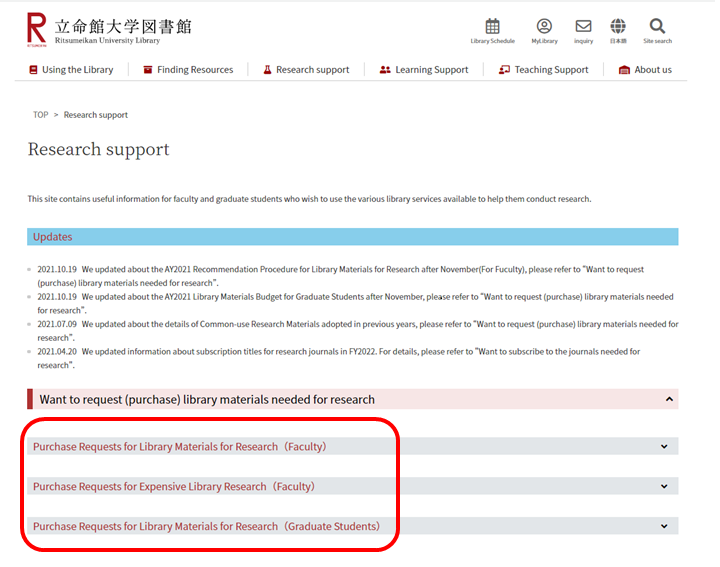 If you cannot get the full text in Steps 1-6 and there is no way to get it, you can move to the "Purchase Request screen" from this link and make a purchase request.
If you cannot get the full text in Steps 1-6 and there is no way to get it, you can move to the "Purchase Request screen" from this link and make a purchase request.
Purchase requests for library materials for research by faculty and graduate students in Ritsumeikan University (RU)
"Research support" page on the library website provides guidance and application methods for purchasing research materials for faculty members and graduate students. Please check here for details (see the figure on the right).
Purchase requests for library materials for stading by undergraduate students in Ritsumeikan University (RU)
For details on the purchase requests for library materials for stading , check here.
Whether you are a faculty member or student, we will make a decision on whether or not to purchase according to the following criteria set by our library. ・ Ritsumeikan University (RU) "Basic Policy for Collection of Library Materials and Receipt Standards" ・ Ritsumeikan University (RU) "Criteria for selecting collections for Studing"
Reprints Desk
 Reprints Desk は、インターネットを通じて有料で提供されている文献を、論文や記事の単位で購入できるサービスです。全文にアクセスするためのリンクがなく、かつ、当該文献が掲載されているジャーナルのISSNがある場合に、この画面に右の図で示すリンクが表示されます。実際に入手が可能か、費用などは、レファレンスライブラリアンが調べます。利用を希望される場合はレファレンスカウンターにご相談ください。
Reprints Desk は、インターネットを通じて有料で提供されている文献を、論文や記事の単位で購入できるサービスです。全文にアクセスするためのリンクがなく、かつ、当該文献が掲載されているジャーナルのISSNがある場合に、この画面に右の図で示すリンクが表示されます。実際に入手が可能か、費用などは、レファレンスライブラリアンが調べます。利用を希望される場合はレファレンスカウンターにご相談ください。
"Reprints Desk" is a service for purchasing documents and articles provided for a fee via the Internet in units of documents and articles. If we do not have a link to access the full text and we have an ISSN for the journal in which the article which you look for is published, the srreen shown in the figure on the right will be displaied. The reference librarian will check if it is actually available and how much it will cost. If you wish to use it, please contact our reference counter.
Journal Citation Reports
「Journal Citation Reports」とは、論文の引用データを使って、学術雑誌の影響度を評価・比較できる分析ツールです。雑誌の影響度指標であるジャーナルインパクトファクターなどを調べることができます。
ジャーナルインパクトファクターの調べ方はこちらを参照してください。
"Journal Citation Reports" is an analysis tool that can evaluate and compare the influence of academic journals using citation data of articles. You can check the journal impact factor, which is an index of the influence of journals, here.
Click here for how to check the journal impact factor.
EBSCOアカウントの作成とサインインについて / About Sign up EBSCO Acount and Sign in
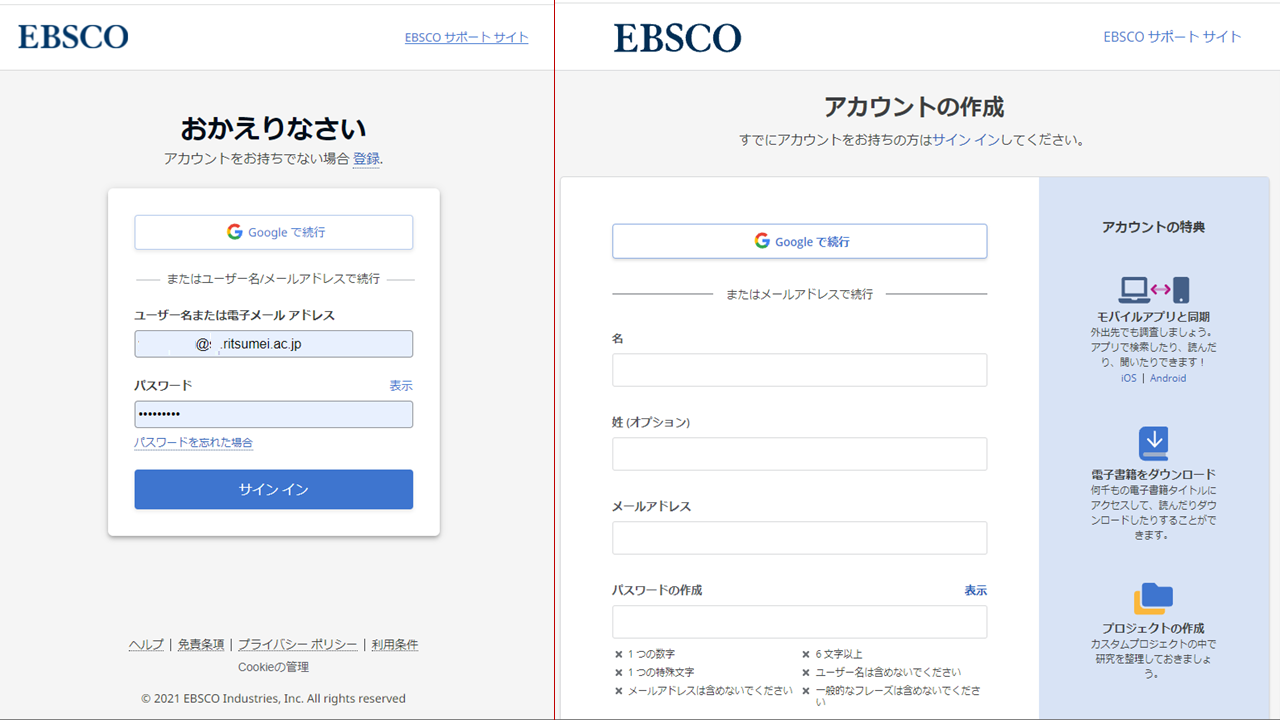 EBSCOアカウントを作成し、サインインした状態で「まとめて検索」「電子書籍検索」「論文・記事検索」を使うことによって、検索条件を保存して再利用する、検索した文献をテーマ別に整理する、予め設定した条件に適合する文献が新たに見つかったときに自分宛てにメールを送信するといった、さらに高度な使い方ができます。
EBSCOアカウントを作成し、サインインした状態で「まとめて検索」「電子書籍検索」「論文・記事検索」を使うことによって、検索条件を保存して再利用する、検索した文献をテーマ別に整理する、予め設定した条件に適合する文献が新たに見つかったときに自分宛てにメールを送信するといった、さらに高度な使い方ができます。
サインインには、EBSCOアカウントの作成が必要です。「まとめて検索」などの上部の赤い帯にある「サインイン」をクリックしてください。ユーザー名やパスワードを入力する画面の「アカウントをお持ちでない場合 登録」をクリックし、必要事項を入力してアカウントを作成してください。
アカウントを作成したあとは、赤い帯の「サインイン」をクリックし、表示された画面にユーザー名とパスワードを入力してサインインすることができます。
アカウントの作成画面、サインイン画面は、予告なく変更されることがあります。
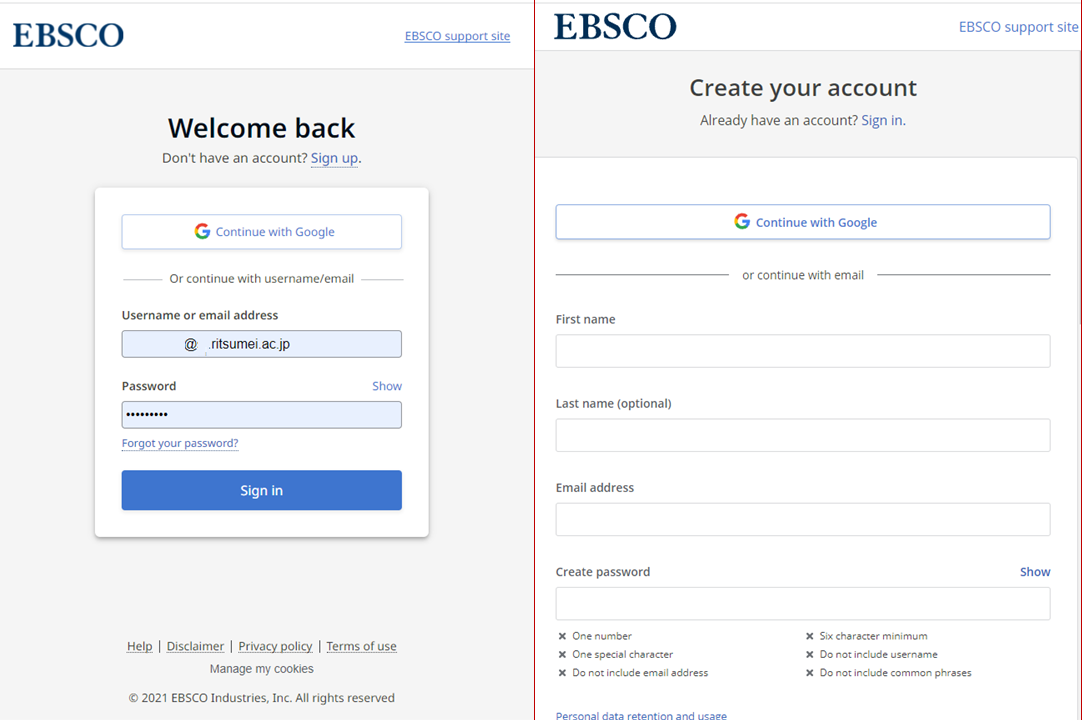 Creating an EBSCO account and sign in to "RUNNERS Discovery Service", "e-book Search", and "Article Search", you can use the search services in more advanced ways, such as saving and reusing search conditions, organizing the searched documents by theme, receiving an e-mail when a new document that meets the preset conditions is found.
Creating an EBSCO account and sign in to "RUNNERS Discovery Service", "e-book Search", and "Article Search", you can use the search services in more advanced ways, such as saving and reusing search conditions, organizing the searched documents by theme, receiving an e-mail when a new document that meets the preset conditions is found.
To sign in, you need to create an EBSCO account. Click on "Sign in" in the red band at the top of "Search in bulk" and so on. If you do not have an account, click "Register" on the screen where you enter your username and password, and then fill in the required information to create an account.
After creating an account, you can sign in by clicking "Sign in" in the red band and entering your user name and password on the screen that appears.
The sign up screen and sign in screen are subject to change without notice.
フォルダ機能の活用 / Utilization of Folder Function
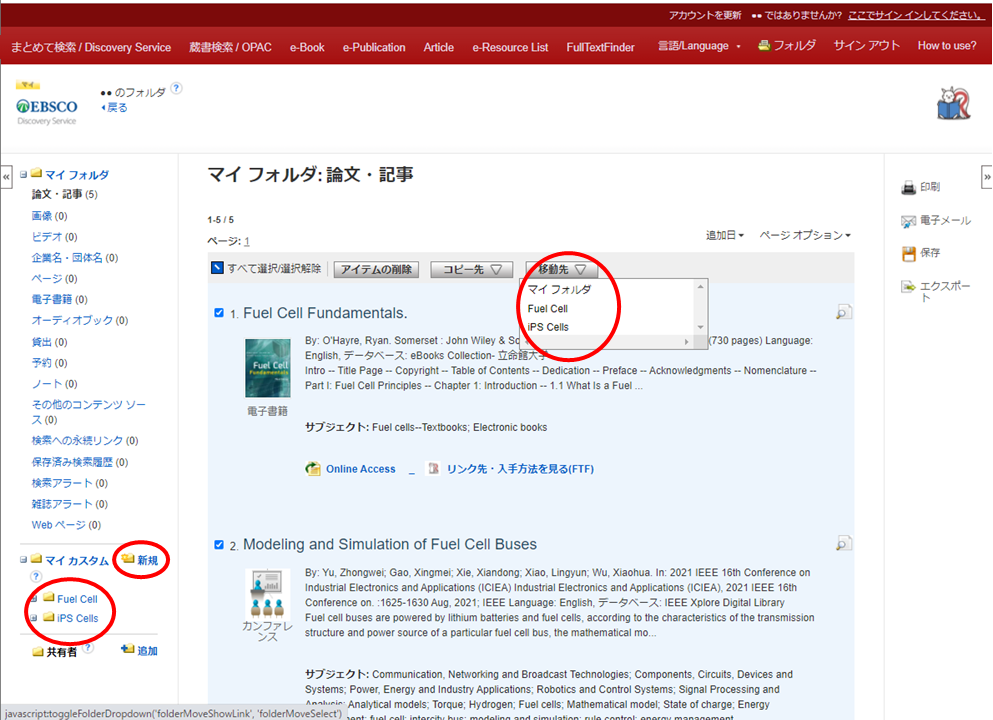 EBSCOアカウントにサインインした状態で、画面上部の赤帯部にある「フォルダ」をクリックすると、右の図に示す画面が表示されます。左側の下にある「マイカスタム」フォルダアイコンの右に表示された「新規」をクリックすると、マイカスタムフォルダの中にサブフォルダを作ることができます。サブフォルダを使えば、EBSCOフォルダに保存されている文献情報を、授業科目やレポート課題ごとに分類できます。右の図では、EBSCOフォルダに保存された文献情報を、Fuel Cell(燃料電池)に関するものと、iPS Cells(iPS細胞)に関するものに振り分けています。
EBSCOアカウントにサインインした状態で、画面上部の赤帯部にある「フォルダ」をクリックすると、右の図に示す画面が表示されます。左側の下にある「マイカスタム」フォルダアイコンの右に表示された「新規」をクリックすると、マイカスタムフォルダの中にサブフォルダを作ることができます。サブフォルダを使えば、EBSCOフォルダに保存されている文献情報を、授業科目やレポート課題ごとに分類できます。右の図では、EBSCOフォルダに保存された文献情報を、Fuel Cell(燃料電池)に関するものと、iPS Cells(iPS細胞)に関するものに振り分けています。
 作成したフォルダをクリックすると、「編集」「共有」「論文・記事」というリンクが表示されます。「編集」をクリックすると、フォルダの名前の変更、サブフォルダの削除ができます。「論文・記事」の右にある数字をクリックすると、そのサブフォルダに入れられた文献情報が表示されます。
作成したフォルダをクリックすると、「編集」「共有」「論文・記事」というリンクが表示されます。「編集」をクリックすると、フォルダの名前の変更、サブフォルダの削除ができます。「論文・記事」の右にある数字をクリックすると、そのサブフォルダに入れられた文献情報が表示されます。
右の図では、フォルダを他の利用者と共有しています。フォルダの共有について、詳しくは、EBSCO社の用意しているこちらのページをご覧ください。
 When you are signed in to your EBSCO account and click "Folder" in the red belt at the top of the screen, the screen shown on the right will be displayed. A folder icon seid "My Custom" is displayed at the bottom of the left side. You can create a subfolder in "My Custom" Folder by clicking "New" displayed to the right of it. By using subfolders, you can classify and save the bibliographic information stored in the EBSCO folder by subject class or by report assignment. The figure on the right is the seen that trying to sort the literature information stored in the EBSCO folder into those related to "Fuel Cell" and those related to "iPS Cells".
When you are signed in to your EBSCO account and click "Folder" in the red belt at the top of the screen, the screen shown on the right will be displayed. A folder icon seid "My Custom" is displayed at the bottom of the left side. You can create a subfolder in "My Custom" Folder by clicking "New" displayed to the right of it. By using subfolders, you can classify and save the bibliographic information stored in the EBSCO folder by subject class or by report assignment. The figure on the right is the seen that trying to sort the literature information stored in the EBSCO folder into those related to "Fuel Cell" and those related to "iPS Cells".
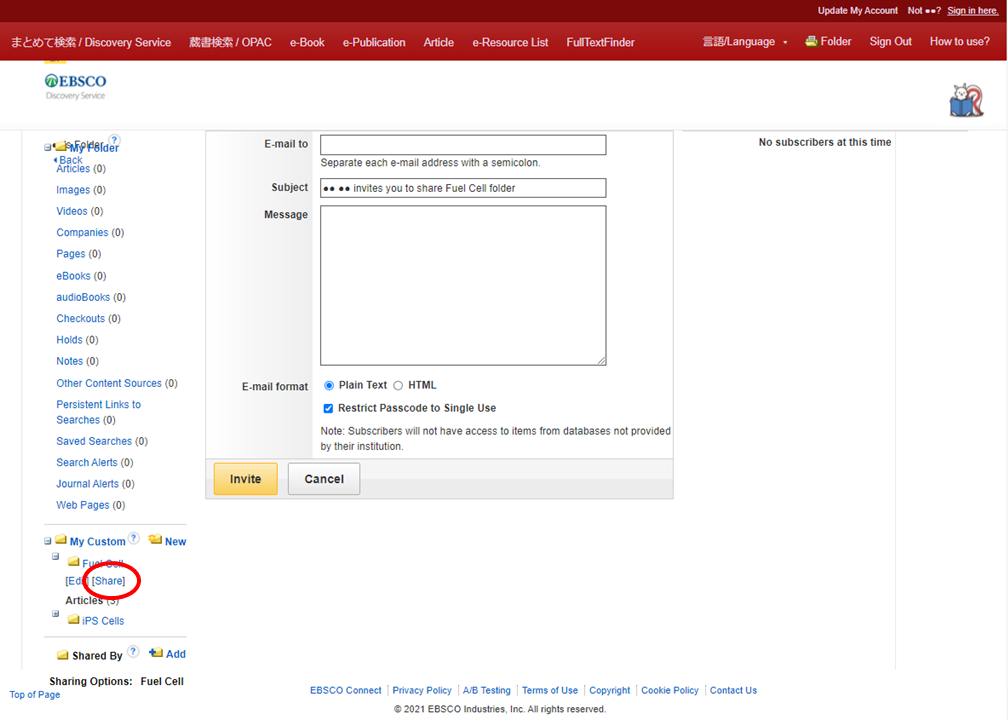 When you click on the created folder, the links "Edit", "Share", and "Articles" will be displayed. Click "Edit" to rename the folder or delete subfolders. Click the number to the right of "Articles" to see the bibliographic information contained in that subfolder.
When you click on the created folder, the links "Edit", "Share", and "Articles" will be displayed. Click "Edit" to rename the folder or delete subfolders. Click the number to the right of "Articles" to see the bibliographic information contained in that subfolder.
The figure on the right is the seen that trying to share a folder with other users. For more information on sharing folders, please see this page provided by EBSCO.
アラートの作成 / Create Alert
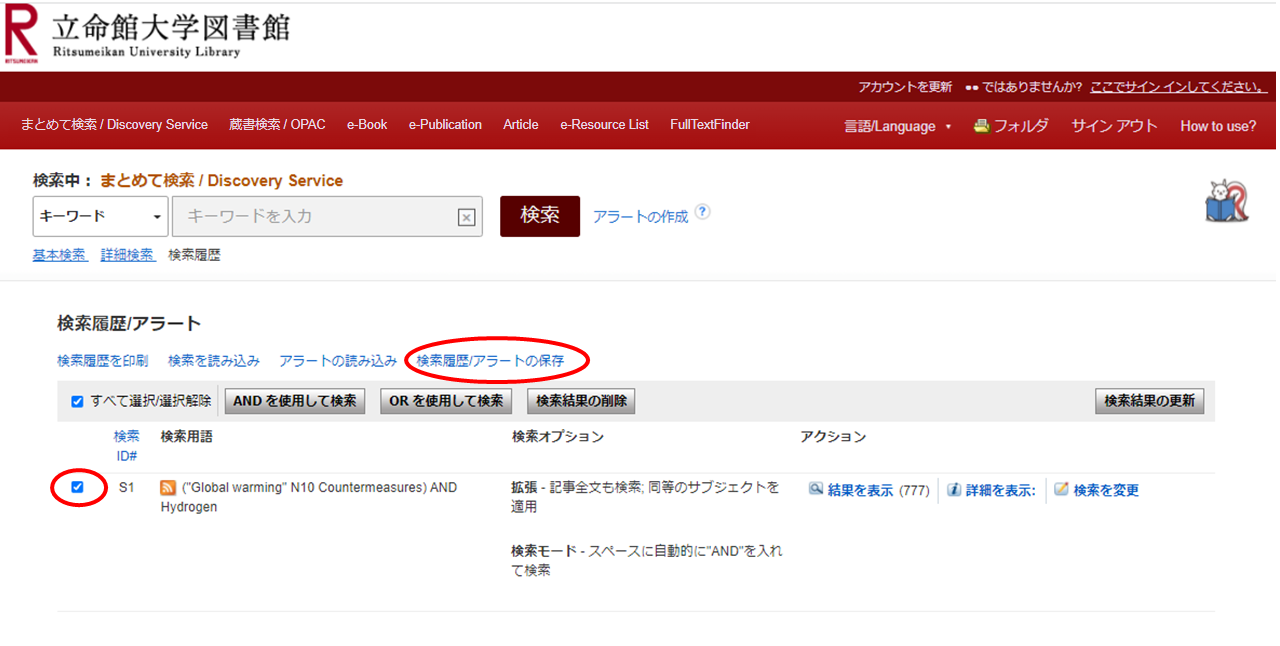 1日1回、週に1回といった頻度で、保存された検索式にヒットする新しい文献がないかどうか検索し、新しい文献が見つかればメールで知らせる機能です。右の図のように、アラートを作成したい検索式を選び、「検索履歴/アラートの保存」をクリックしてください。
1日1回、週に1回といった頻度で、保存された検索式にヒットする新しい文献がないかどうか検索し、新しい文献が見つかればメールで知らせる機能です。右の図のように、アラートを作成したい検索式を選び、「検索履歴/アラートの保存」をクリックしてください。
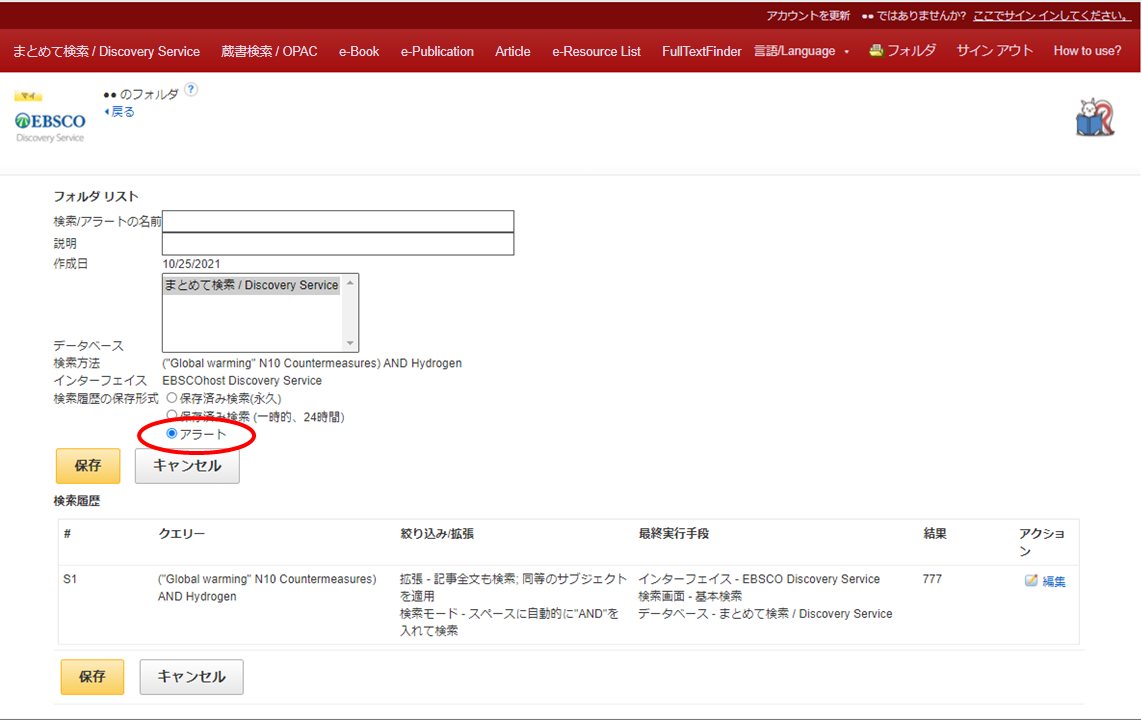 右の図で示す画面が表示されます。「検索履歴の保存形式」のラジオボタンで「アラート」を選んでください。
右の図で示す画面が表示されます。「検索履歴の保存形式」のラジオボタンで「アラート」を選んでください。
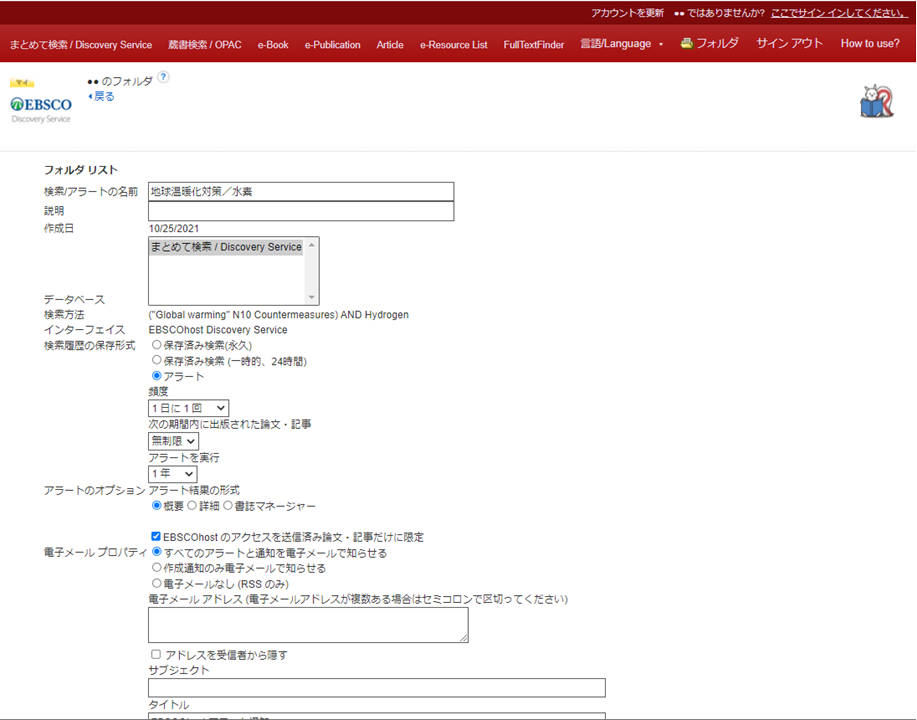 アラートを作成する頻度や、アラート送付先のメールアドレス、メールの件名などを入力する画面が表示されますので、それぞれ入力、保存してください。
アラートを作成する頻度や、アラート送付先のメールアドレス、メールの件名などを入力する画面が表示されますので、それぞれ入力、保存してください。
アラートの作成についての詳細は、EBSCO社の用意しているこちらのページをご覧ください。
 One such effective use is to create alerts. It is a function that searches for new documents that hit the saved search formula once a day, once a week, etc., and if new documents are found, it will notify you by e-mail. Select the search formula for which you want to create an alert, and click "Save Searches / Alerts" as shown in the figure on the right.
One such effective use is to create alerts. It is a function that searches for new documents that hit the saved search formula once a day, once a week, etc., and if new documents are found, it will notify you by e-mail. Select the search formula for which you want to create an alert, and click "Save Searches / Alerts" as shown in the figure on the right.
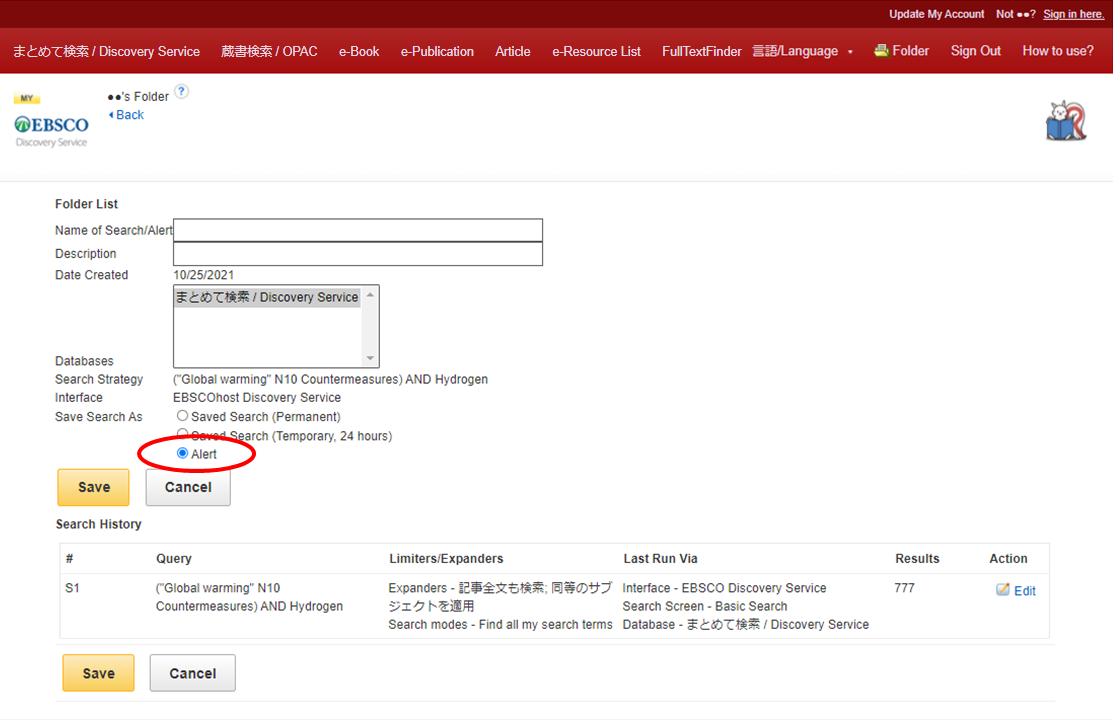 The screen shown on the right is displayed. Select "Alert" from the "Save Search as" radio button.
The screen shown on the right is displayed. Select "Alert" from the "Save Search as" radio button.
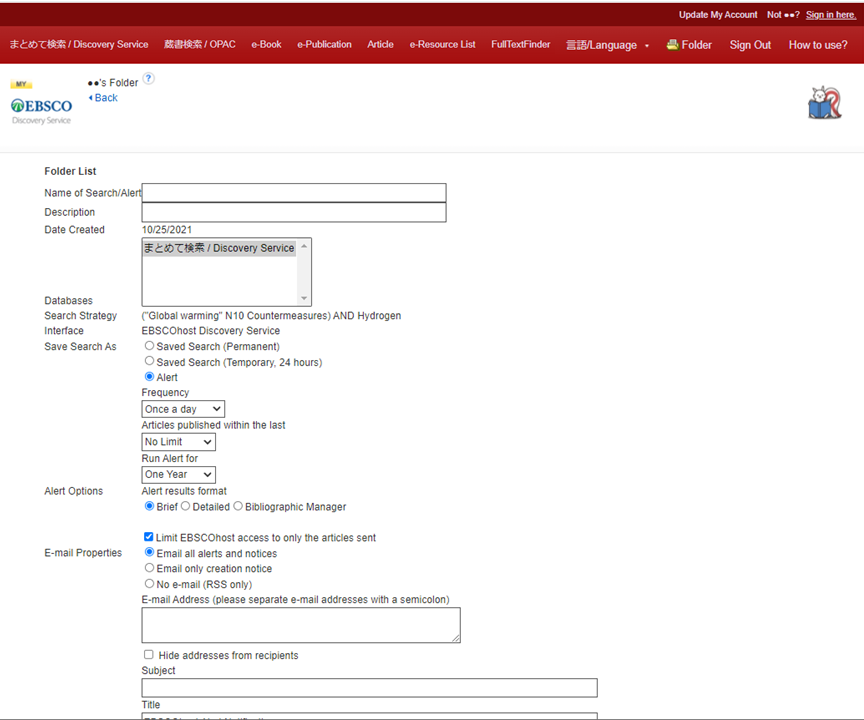 A screen for entering the frequency of alert creation, the email address to which the alert will be sent, the subject of the email, etc. will be displayed. Enter each of them and save.
A screen for entering the frequency of alert creation, the email address to which the alert will be sent, the subject of the email, etc. will be displayed. Enter each of them and save.
For more information on creating alerts, please see this page provided by EBSCO.
Mendeleyへの書誌情報インポートについて / About Importing Bibliographic Information into Mendeley
「まとめて検索」「電子書籍検索」「論文・記事検索」で検索した文献の書誌情報画面や、「リンク先・入手方法を見る(FTF)」をクリックして現れる画面から、文献管理ツール Mendeley への書誌情報のインポートができます。この機能を使うには Mendeley のアカウントが必要です。 Menderey のアカウント取得については、Mendeley の操作説明をお読みください。
この機能を使うには、お使いのブラウザにプラグインを入れる必要があります。ご自身のパソコンであれば、いちどプラグインを入れれば、繰り返し、そのプラグインを使ってインポートすることができます。
From the bibliographic information screen of the literature searched on the "RUNNERS Discovery Service", "e-book search", and "article search" screens, or from the screen that appears when you click "リンク先・入手方法を見る(FTF)"(How to Find the Full Text), you can inmoprt the bibliographic informationgo into the Mendeley whuch is a literature management tool. You need a Menderey account to use this feature. For information on getting a Mendeley account, please read the Mendeley operating instructions.
To use this feature, you need to install a plug-in in your browser. If you use your own computer, once you install the plug-in, you can repeatedly import using that plug-in.
プラグインを入れる方法 How to Install the Plug-in (▼Click to Read)
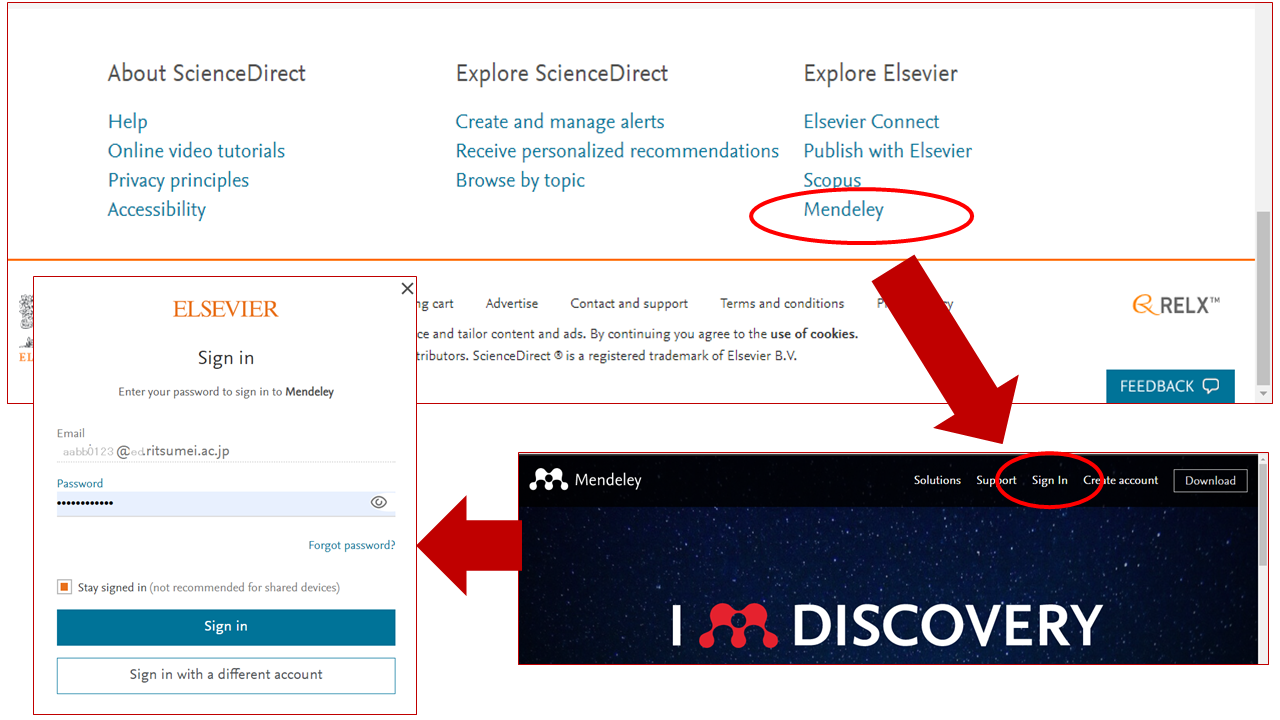 Mendeley は Elsevire 社が提供する文献管理ツールです。Elsevier のページにある Mendeley へのリンクをクリックし、あらかじめ取得しておいたアカウントでサインインしてください。右の図は、Elsevier Science Direct のトップ画面の下の方から Mendeley にリンクし、そこからサインインしている様子です。アカウントを取得していない場合は、「Sign in」の右にある「Create account」をクリックして、アカウントを取得してください。なお、これらの画面は予告なく変更されることがあります。
Mendeley は Elsevire 社が提供する文献管理ツールです。Elsevier のページにある Mendeley へのリンクをクリックし、あらかじめ取得しておいたアカウントでサインインしてください。右の図は、Elsevier Science Direct のトップ画面の下の方から Mendeley にリンクし、そこからサインインしている様子です。アカウントを取得していない場合は、「Sign in」の右にある「Create account」をクリックして、アカウントを取得してください。なお、これらの画面は予告なく変更されることがあります。
Mendeley is a literature management tool provided by Elsevire. There is a link to Mendeley on the Elsevier page, click on it and sign in with your pre-account. The figure on the right shows a link to the Mendeley from the bottom of the Elsevier Science Direct top page and trying to sign in from there. If you do not have an account, click "Create account" to the right of "Sign in" to get one. These screens are subject to change without notice.
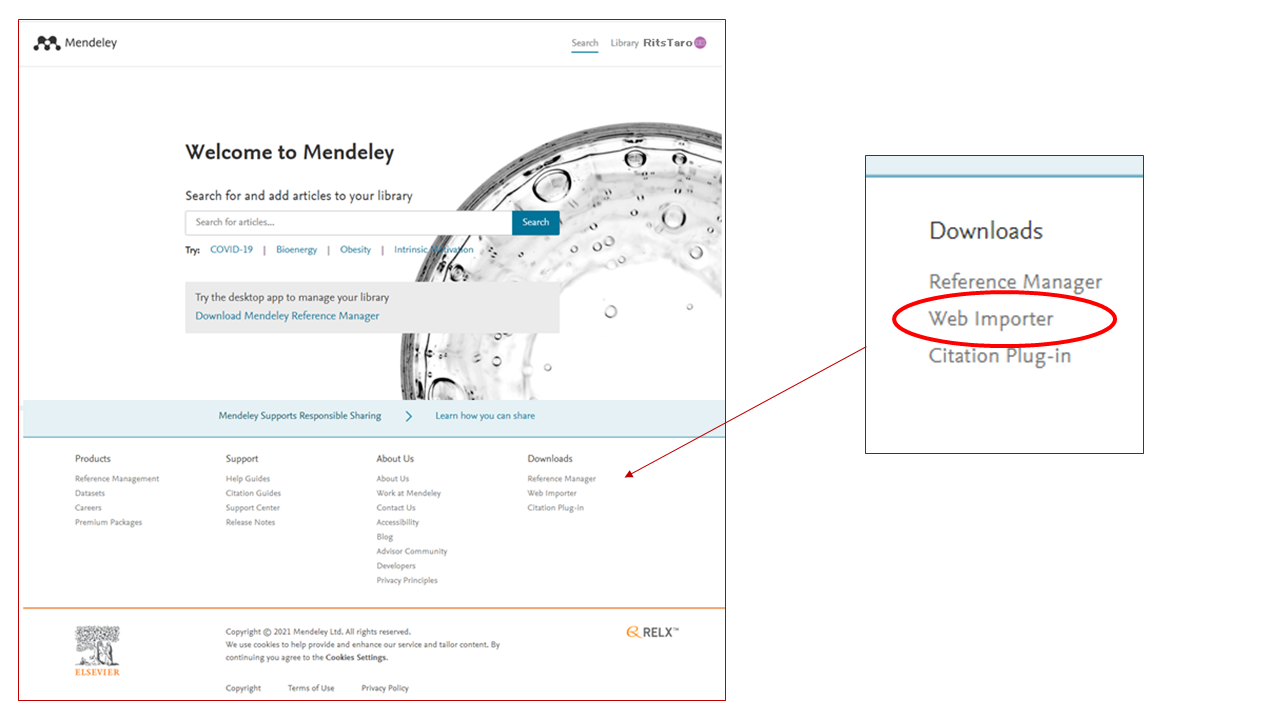 Mendeley の画面が表示されます。この画面では、ボトムメニューの右に「Web importer」というリンクがあります。これが、これからブラウザに組み込もうとしているプラグインです。
Mendeley の画面が表示されます。この画面では、ボトムメニューの右に「Web importer」というリンクがあります。これが、これからブラウザに組み込もうとしているプラグインです。
The Mendeley screen is displayed. On this screen, there is a link say "Web importer" on the right side of the bottom menu. This is the plug-in that you will install in your browser.
 右の図は、Google Chrome を使って操作している様子です。プラグインは、ブラウザの種類によって異なります。この画面では、あなたがいま使っているブラウザに合わせて、それにマッチするプラグインをインストールするためのボタンが表示されます。
右の図は、Google Chrome を使って操作している様子です。プラグインは、ブラウザの種類によって異なります。この画面では、あなたがいま使っているブラウザに合わせて、それにマッチするプラグインをインストールするためのボタンが表示されます。
The figure on the right is a screen operating using Google Chrome. Plug-ins vary depending on the browser type. On this screen, you will see a button to install the matching plug-in for the browser you are using.
 右の図は、Google Chrome を使って操作している様子です。上は日本語で、下は英語で操作している画面です。「Chromeに追加」ボタンを押すと、プラグインが組み込まれます。Google Chrome 以外のブラウザを使っている場合は、それぞれのブラウザが提供しているインストール画面が表示されます。
右の図は、Google Chrome を使って操作している様子です。上は日本語で、下は英語で操作している画面です。「Chromeに追加」ボタンを押すと、プラグインが組み込まれます。Google Chrome 以外のブラウザを使っている場合は、それぞれのブラウザが提供しているインストール画面が表示されます。
The figure on the right shows the operation using Google Chrome. The upper half is the screen operated in Japanese, and the lower half is the screen operated in English. Click the "Add to Chrome" button to install the plug-in. If you are using a browser other than Google Chrome, the installation screen provided by each browser will be displayed.
プラグインを使った Mendeley へのインポート Import into Mendeley Using the Plug-in
 右の図は、Google Chrome を使って、表示されている文献の情報を Mendeley にインポートしている様子です。上は日本語で、下は英語で操作している画面です。Google Chrome の場合、左上に拡張機能を表示するためのアイコンがありますので、これをクリックしてください。あなたがブラウザに組み込んださまざまなプラグインが表示されます。その中から「Mendeley Web Importer」をクリックしてください。
右の図は、Google Chrome を使って、表示されている文献の情報を Mendeley にインポートしている様子です。上は日本語で、下は英語で操作している画面です。Google Chrome の場合、左上に拡張機能を表示するためのアイコンがありますので、これをクリックしてください。あなたがブラウザに組み込んださまざまなプラグインが表示されます。その中から「Mendeley Web Importer」をクリックしてください。
The figure on the right is a screen that uses Google Chrome to import the information of the displayed literature into Mendeley. The upper half is the screen operated in Japanese, and the lower half is the screen operated in English. The way to display extentions differs depending on the browser. For Google Chrome, there is an icon in the upper left to display the extension, so click on it. You will see the various plug-ins you have built into your browser. From there, click on "Mendeley Web Importer".
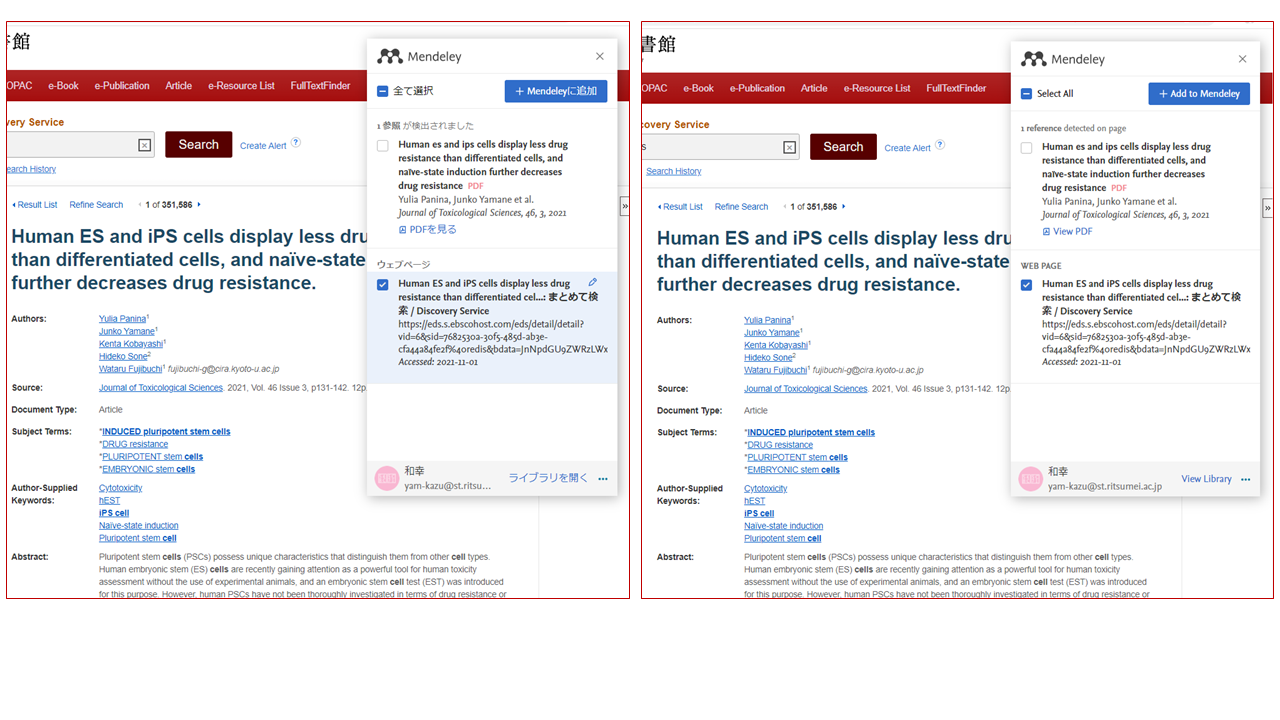 「Mendeley Web Importer」をクリックすると、右の図のように、Mendeley にインポートする文献の候補が表示されます。左は日本語で、右は英語で操作している画面です。文献情報の管理が異なるため、ひとつの文献を表示して Mendeley にインポートしようとしても、複数の候補が表示されることがあります。インポートする文献にチェックを入れて「Mendeleyに追加」ボタンを押せば、その文献の情報がインポートされます。
「Mendeley Web Importer」をクリックすると、右の図のように、Mendeley にインポートする文献の候補が表示されます。左は日本語で、右は英語で操作している画面です。文献情報の管理が異なるため、ひとつの文献を表示して Mendeley にインポートしようとしても、複数の候補が表示されることがあります。インポートする文献にチェックを入れて「Mendeleyに追加」ボタンを押せば、その文献の情報がインポートされます。
Click Mendeley Web Importer and you'll see the candidate literatures you're trying to import into Mendeley, as shown on the right. The left half is the screen operated in Japanese, and the right half is the screen operated in English. Due to the different management of bibliographic information, you may see multiple literature when you try to view a single bibliography and import it into Mendeley. If you check the literature to be imported and click the "Add to Mendeley" button, the information of that literature will be imported.
学外からの利用について / About Usage from Off-Campus
 「まとめて検索」「電子書籍検索」「論文・記事検索」を利用するときは、パソコンやスマホなどの情報機器を学内ネットワーク(RAINBOW)に接続してください。学外から利用した場合、右の図に示した画面が表示されます。自宅や下宿から利用する場合は、VPN接続によって、学内ネットワーク(RAINBOW)に接続してください。
「まとめて検索」「電子書籍検索」「論文・記事検索」を利用するときは、パソコンやスマホなどの情報機器を学内ネットワーク(RAINBOW)に接続してください。学外から利用した場合、右の図に示した画面が表示されます。自宅や下宿から利用する場合は、VPN接続によって、学内ネットワーク(RAINBOW)に接続してください。
APU所属の利用者の方も同様に、VPN接続により学内ネットワーク(APU-Net)に接続してご利用ください。
「まとめて検索」などの検索機能で見つけることができる電子リソースの多くは、それぞれの電子リソースの提供者と大学が契約を交わすことでアクセスできるようになっています。RAINBOWアカウントを持ち、学内ネットワークを使える人だけが利用することを前提に契約内容が決められているため、学外からはこれらの検索機能を使うときには制限がかかります。
電子リソースの利用とネットワークの関係や、自宅や下宿など学外から電子リソースを利用することについては、「電子リソースの利用方法」をお読みください。
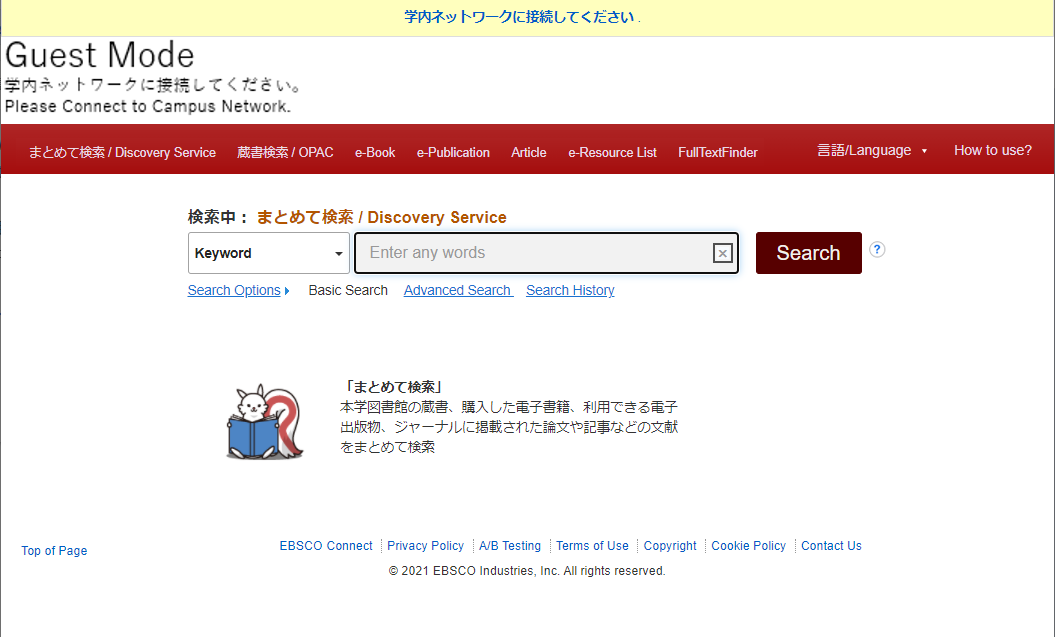 When using "RUNNERS Discovery Service," "e-book Search," or "Article Search," connect information devices such as computers and smartphones to the campus network (RAINBOW). If you use it from off-campus, the screen shown on the right will be displayed. When using from home or student dormitory, please connect to the campus network (RAINBOW) by VPN connection.
When using "RUNNERS Discovery Service," "e-book Search," or "Article Search," connect information devices such as computers and smartphones to the campus network (RAINBOW). If you use it from off-campus, the screen shown on the right will be displayed. When using from home or student dormitory, please connect to the campus network (RAINBOW) by VPN connection.
A VPN connection is required for the APU members also to access "RUNNERS Discovery Service"
Many of the e-resources that can be found with search functions such as "RUNNERS Discovery Service" can be accessed due signing a contract between the provider of each e-resource and our university. At that time, the contract details are decided on the assumption that only those who have a RAINBOW account and can use the campus network will use them, so there will be restrictions when using these search functions from off-campus.
For information on the relation between the use of e-resources and networks system, and on the usage of e-resources from off-campus such as at home or domitory, please read "Usage of e-Resources".